Paul van Yperen's Blog, page 101
December 27, 2022
Star Wars: Episode III - Revenge of the Sith (2005)
The American film Star Wars: Episode III - Revenge of the Sith (George Lucas, 2005) is the third part of the Star Wars saga. George Lucas who directed the film from his own screenplay comes full circle with the sixth - and allegedly but not necessarily the last - of the Star Wars films. It is a return to the classic space opera style that launched the series. In Episode III we learn how and why the brave and handsome Anakin was transformed into a dark, cloaked figure with a fearsome black metal face.
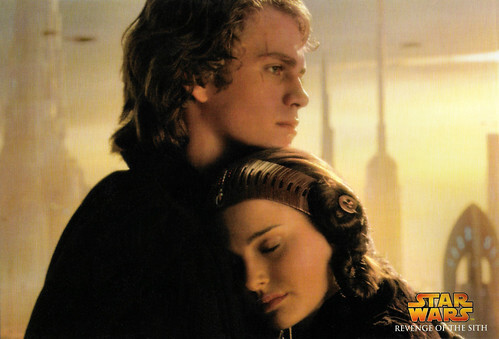
American postcard by Classico San Francisco, no. 106-136. Photo: Lucasfilm. Hayden Christensen as Anakin Skywalker and Natalie Portman as Padmé Amidala in Star Wars: Episode III - Revenge of the Sith (George Lucas, 2005).
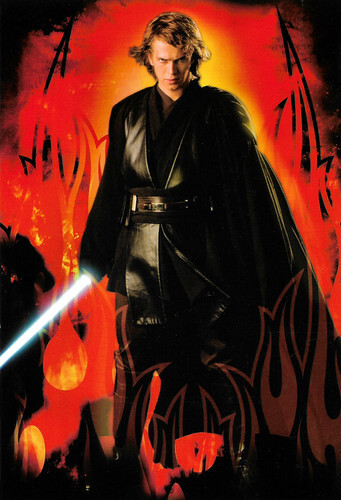
American postcard by Classico San Francisco, no. 106-115. Photo: Lucasfilm. Hayden Christensen as Anakin Skywalker in Star Wars: Episode III - Revenge of the Sith (George Lucas, 2005).
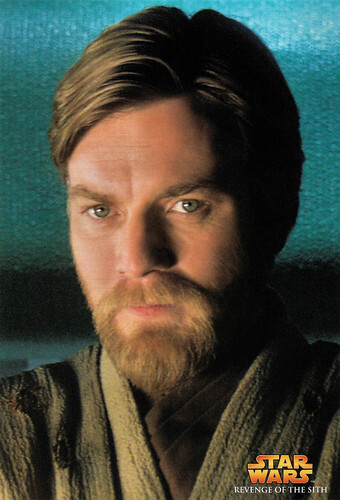
American postcard by Classico San Francisco, no. 106-117. Photo: Lucasfilm. Ewan McGregor as Obi-Wan Kenobi in Star Wars: Episode III - Revenge of the Sith (George Lucas, 2005).
Going the way of the dark side
The universe has changed after three years of devastating Clone Wars. Anakin Skywalker (Hayden Christensen) and Obi-Wan Kenobi ( Ewan McGregor ) have become legendary heroes in their fight against the Separatists' Battle Droid. When the Separatists kidnap Chancellor Palpatine (Ian McDiarmid), Obi-Wan and Anakin go to free him in the spaceship Invisible Hand, which also involves a fierce space battle in space.
After Count Dooku ( Christopher Lee ) tosses Obi-Wan aside unconscious, he plays with Anakin, who chops off Dooku's hands and then grabs his light sabre. Chancellor Palpatine tells him to kill Dooku. When Anakin says that's not the Jedi way, Palpatine tells him to do it. Skywalker beheads the Sith Lord, taking another step towards the Dark Side.
Anakin and Obi-Wan rescue the Chancellor. However, the spaceship Invisible Hand crashes on the planet Coruscant. Anakin and Padmé Amidala, secretly married, have been separated by the war for months. When Anakin goes to the Jedi Temple, he is reunited with his wife Padmé (Natalie Portman). She is pregnant with Anakin. From then on, he is plagued by nightmares about Padmé's death during the birth of their child. He is determined to prevent this, as he has already lost his mother too.
Chancellor Palpatine tells Anakin that he will allow him to sit on the Jedi Council and become a Jedi Master. Anakin is allowed by the Jedi Council to belong to them but is not allowed to become a Jedi Master. Still, Anakin does get nightmares about Padmé every time and decides to visit the Chancellor again in the Galactic Opera House. Chancellor Palpatine tells Anakin that only the Dark Force can save his wife Padmé, and mentions the example of Darth Plagueis, a Sith master who could create life using the so-called midi-chlorians.
Palpatine also tells Anakin that General Grievous is on the planet Utapau. This, in turn, Anakin later tells Obi-Wan. Palpatine reveals to Anakin that he is the Sith Lord the Jedi were looking for, namely Darth Sidious. Only through the Dark Side can life be created, therefore Anakin must then become his apprentice and go the way of the Dark Side...
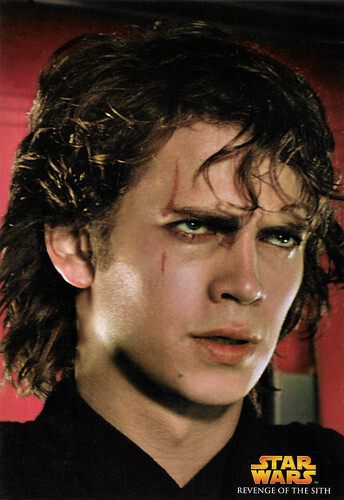
American postcard by Classico San Francisco, no. 106-118. Photo: Lucasfilm. Hayden Christensen as Anakin Skywalker in Star Wars: Episode III - Revenge of the Sith (George Lucas, 2005).
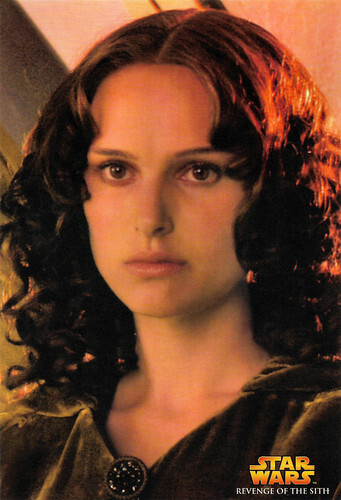
American postcard by Classico San Francisco, no. 106-128. Photo: Lucasfilm. Natalie Portman as Padmé Amidala in Star Wars: Episode III - Revenge of the Sith (George Lucas, 2005).
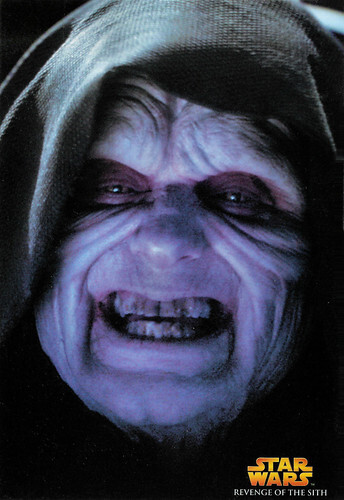
American postcard by Classico San Francisco, no. 106-129. Photo: Lucasfilm. Ian McDiarmid as Darth Sidious in Star Wars: Episode III - Revenge of the Sith (George Lucas, 2005).
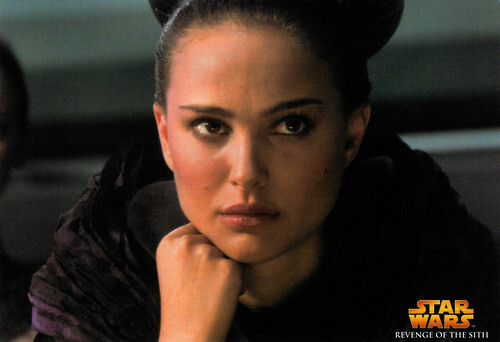
American postcard by Classico San Francisco, no. 106-130. Photo: Lucasfilm. Natalie Portman in Star Wars: Episode III - Revenge of the Sith (George Lucas, 2005). Caption: Padmé Amidala in senate.
The Force is in a jollier mood this time
In 2003 and 2004, George Lucas began turning his original story, which he had already written in 1973, into a screenplay. Playwright Tom Stoppard also helped with the screenplay as a ghostwriter for Lucas. The title of the film was the subject of many rumours at the beginning such as 'Rise of the Empire', 'The Creeping Fear' and 'Birth of the Empire'.
Actors Hayden Christensen and Ewan McGregor practised together for months before their lightsaber duel. As in the previous film, the two actors did all their fighting themselves. Because of their training, the speed at which they are seen fighting in the film is actually the speed at which the scene was shot, and the action has not been sped up later. In fact, the final scene of the film had already been shot during the filming of Star Wars: Episode II - Attack of the Clones in 2000.
The film itself was shot almost entirely at Fox Studios Australia in Sydney. Revenge of the Sith is the first Star Wars film to feature both Darth Vader in his full costume, and his alter-ego Anakin Skywalker both, and also both played by the same actor. Initially, the plan was to just have a random actor wear the Darth Vader costume, but according to his own account, Christensen begged Lucas to play the role himself. The film score was again composed by John Williams. He also conducted the London Symphony Orchestra and London Voices when they performed the soundtrack.
Reactions to the film, especially compared to the previous two films, were relatively positive. Roger Ebert of the Chicago Sun-Times gave the film three-and-a-half out of four stars, writing "If [Lucas] got bogged down in solemnity and theory in Episode II: Attack of the Clones, the Force is in a jollier mood this time, and Revenge of the Sith is a great entertainment". Some critics called the film the best of the prequels, and others called it the best Star Wars film since Star Wars: Episode V- The Empire Strikes Back.
One point that still drew criticism was the dialogue, especially in the romantic scenes with Anakin and Padmé. Roger Ebert: "The characters talk in what sounds like Basic English, without color, wit or verbal delight, as if they were channeling Berlitz." Star Wars: Episode 3 - Revenge of the Sith grossed $850 million worldwide, making it the second-best-grossing film of 2005. Ebert concludes in his review: "George Lucas has achieved what few artists do; he has created and populated a world of his own. His "Star Wars" movies are among the most influential, both technically and commercially, ever made. And they are fun."
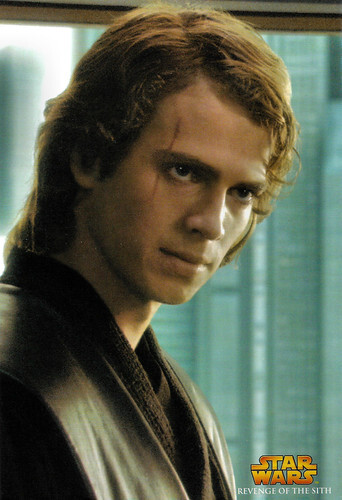
American postcard by Classico San Francisco, no. 106-132. Photo: Lucasfilm. Hayden Christensen as Anakin Skywalker in Star Wars: Episode III - Revenge of the Sith (George Lucas, 2005).
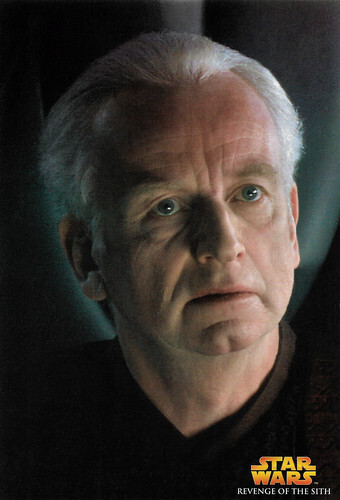
American postcard by Classico San Francisco, no. 106-134. Photo: Lucasfilm. Ian McDiarmid as Chancellor Palpatine in Star Wars: Episode III - Revenge of the Sith (George Lucas, 2005).
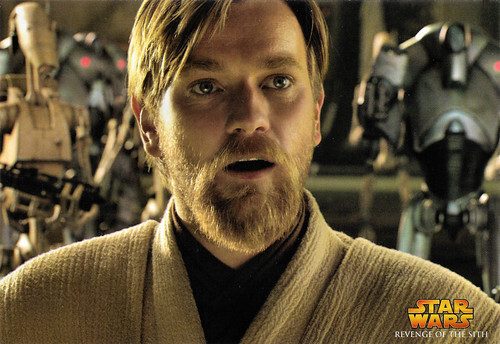
American postcard by Classico San Francisco, no. 106-138. Photo: Lucasfilm. Ewan McGregor as Obi-Wan Kenobi in Star Wars: Episode III - Revenge of the Sith (George Lucas, 2005).
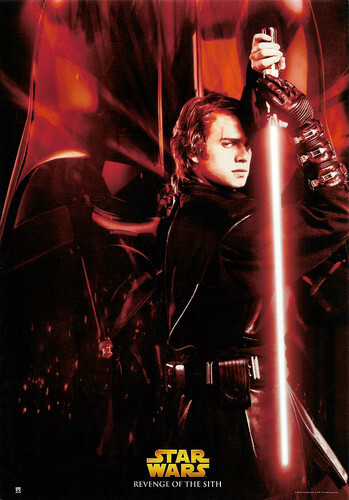
French postcard by Sonis, no. C 1611. Photo: Lucasfilm. Hayden Christensen in Star Wars: Episode III - Revenge of the Sith (George Lucas, 2005).
Sources: Roger Ebert (Roger Ebert.com), Wikipedia (Dutch and English) and IMDb.

American postcard by Classico San Francisco, no. 106-136. Photo: Lucasfilm. Hayden Christensen as Anakin Skywalker and Natalie Portman as Padmé Amidala in Star Wars: Episode III - Revenge of the Sith (George Lucas, 2005).

American postcard by Classico San Francisco, no. 106-115. Photo: Lucasfilm. Hayden Christensen as Anakin Skywalker in Star Wars: Episode III - Revenge of the Sith (George Lucas, 2005).

American postcard by Classico San Francisco, no. 106-117. Photo: Lucasfilm. Ewan McGregor as Obi-Wan Kenobi in Star Wars: Episode III - Revenge of the Sith (George Lucas, 2005).
Going the way of the dark side
The universe has changed after three years of devastating Clone Wars. Anakin Skywalker (Hayden Christensen) and Obi-Wan Kenobi ( Ewan McGregor ) have become legendary heroes in their fight against the Separatists' Battle Droid. When the Separatists kidnap Chancellor Palpatine (Ian McDiarmid), Obi-Wan and Anakin go to free him in the spaceship Invisible Hand, which also involves a fierce space battle in space.
After Count Dooku ( Christopher Lee ) tosses Obi-Wan aside unconscious, he plays with Anakin, who chops off Dooku's hands and then grabs his light sabre. Chancellor Palpatine tells him to kill Dooku. When Anakin says that's not the Jedi way, Palpatine tells him to do it. Skywalker beheads the Sith Lord, taking another step towards the Dark Side.
Anakin and Obi-Wan rescue the Chancellor. However, the spaceship Invisible Hand crashes on the planet Coruscant. Anakin and Padmé Amidala, secretly married, have been separated by the war for months. When Anakin goes to the Jedi Temple, he is reunited with his wife Padmé (Natalie Portman). She is pregnant with Anakin. From then on, he is plagued by nightmares about Padmé's death during the birth of their child. He is determined to prevent this, as he has already lost his mother too.
Chancellor Palpatine tells Anakin that he will allow him to sit on the Jedi Council and become a Jedi Master. Anakin is allowed by the Jedi Council to belong to them but is not allowed to become a Jedi Master. Still, Anakin does get nightmares about Padmé every time and decides to visit the Chancellor again in the Galactic Opera House. Chancellor Palpatine tells Anakin that only the Dark Force can save his wife Padmé, and mentions the example of Darth Plagueis, a Sith master who could create life using the so-called midi-chlorians.
Palpatine also tells Anakin that General Grievous is on the planet Utapau. This, in turn, Anakin later tells Obi-Wan. Palpatine reveals to Anakin that he is the Sith Lord the Jedi were looking for, namely Darth Sidious. Only through the Dark Side can life be created, therefore Anakin must then become his apprentice and go the way of the Dark Side...

American postcard by Classico San Francisco, no. 106-118. Photo: Lucasfilm. Hayden Christensen as Anakin Skywalker in Star Wars: Episode III - Revenge of the Sith (George Lucas, 2005).

American postcard by Classico San Francisco, no. 106-128. Photo: Lucasfilm. Natalie Portman as Padmé Amidala in Star Wars: Episode III - Revenge of the Sith (George Lucas, 2005).

American postcard by Classico San Francisco, no. 106-129. Photo: Lucasfilm. Ian McDiarmid as Darth Sidious in Star Wars: Episode III - Revenge of the Sith (George Lucas, 2005).

American postcard by Classico San Francisco, no. 106-130. Photo: Lucasfilm. Natalie Portman in Star Wars: Episode III - Revenge of the Sith (George Lucas, 2005). Caption: Padmé Amidala in senate.
The Force is in a jollier mood this time
In 2003 and 2004, George Lucas began turning his original story, which he had already written in 1973, into a screenplay. Playwright Tom Stoppard also helped with the screenplay as a ghostwriter for Lucas. The title of the film was the subject of many rumours at the beginning such as 'Rise of the Empire', 'The Creeping Fear' and 'Birth of the Empire'.
Actors Hayden Christensen and Ewan McGregor practised together for months before their lightsaber duel. As in the previous film, the two actors did all their fighting themselves. Because of their training, the speed at which they are seen fighting in the film is actually the speed at which the scene was shot, and the action has not been sped up later. In fact, the final scene of the film had already been shot during the filming of Star Wars: Episode II - Attack of the Clones in 2000.
The film itself was shot almost entirely at Fox Studios Australia in Sydney. Revenge of the Sith is the first Star Wars film to feature both Darth Vader in his full costume, and his alter-ego Anakin Skywalker both, and also both played by the same actor. Initially, the plan was to just have a random actor wear the Darth Vader costume, but according to his own account, Christensen begged Lucas to play the role himself. The film score was again composed by John Williams. He also conducted the London Symphony Orchestra and London Voices when they performed the soundtrack.
Reactions to the film, especially compared to the previous two films, were relatively positive. Roger Ebert of the Chicago Sun-Times gave the film three-and-a-half out of four stars, writing "If [Lucas] got bogged down in solemnity and theory in Episode II: Attack of the Clones, the Force is in a jollier mood this time, and Revenge of the Sith is a great entertainment". Some critics called the film the best of the prequels, and others called it the best Star Wars film since Star Wars: Episode V- The Empire Strikes Back.
One point that still drew criticism was the dialogue, especially in the romantic scenes with Anakin and Padmé. Roger Ebert: "The characters talk in what sounds like Basic English, without color, wit or verbal delight, as if they were channeling Berlitz." Star Wars: Episode 3 - Revenge of the Sith grossed $850 million worldwide, making it the second-best-grossing film of 2005. Ebert concludes in his review: "George Lucas has achieved what few artists do; he has created and populated a world of his own. His "Star Wars" movies are among the most influential, both technically and commercially, ever made. And they are fun."

American postcard by Classico San Francisco, no. 106-132. Photo: Lucasfilm. Hayden Christensen as Anakin Skywalker in Star Wars: Episode III - Revenge of the Sith (George Lucas, 2005).

American postcard by Classico San Francisco, no. 106-134. Photo: Lucasfilm. Ian McDiarmid as Chancellor Palpatine in Star Wars: Episode III - Revenge of the Sith (George Lucas, 2005).

American postcard by Classico San Francisco, no. 106-138. Photo: Lucasfilm. Ewan McGregor as Obi-Wan Kenobi in Star Wars: Episode III - Revenge of the Sith (George Lucas, 2005).

French postcard by Sonis, no. C 1611. Photo: Lucasfilm. Hayden Christensen in Star Wars: Episode III - Revenge of the Sith (George Lucas, 2005).
Sources: Roger Ebert (Roger Ebert.com), Wikipedia (Dutch and English) and IMDb.
Published on December 27, 2022 22:00
December 26, 2022
Star Wars: Episode II - Attack of the Clones (2002)
Star Wars: Episode II - Attack of the Clones (George Lucas, 2002) is situated ten years after Star Wars: Episode I - The Phantom Menace (George Lucas, 1999). Anakin Skywalker shares a forbidden romance with Padmé Amidala, while Obi-Wan Kenobi investigates an assassination attempt on the senator and discovers a secret clone army crafted for the Jedi.
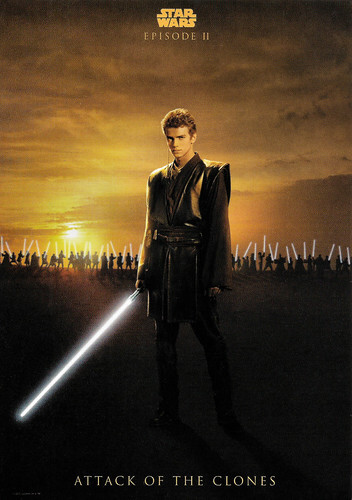
Dutch postcard by Boomerang, Amsterdam, no. P10-02. postcard. Photo: Lucasfilm. Hayden Christensen as Anakin Skywalker in Star Wars: Episode II - Attack of the Clones (George Lucas, 2002).
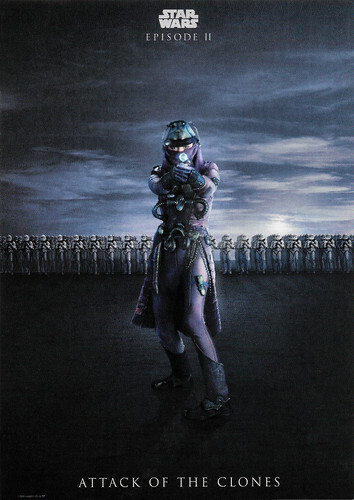
Dutch postcard by Boomerang, Amsterdam, no. P10-02. Photo: Lucasfilm. Leeanna Walsman as Zam Wesell in Star Wars: Episode II - Attack of the Clones (George Lucas, 2002).
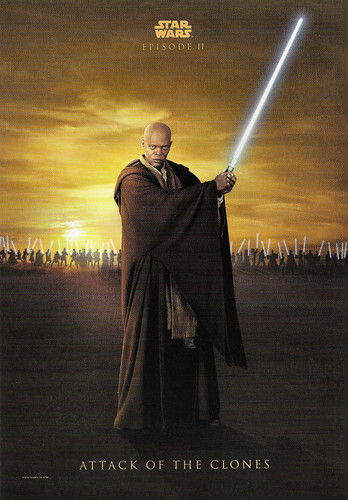
Singaporean postcard by ArtCard, no. 337, Collectable postcard series, no. 5 of 9. Photo: Lucasfilm. Samuel L. Jackson as Mace Windu in Star Wars: Episode II - Attack of the Clones (George Lucas, 2002). Caption: Mace Windu. A senior member of the Jedi Council, Mace Windu is a highly revered Jedi Master. Mace is a diplomat by nature and seeks peaceful solutions to the most volatile issues. However, with thousands of solar systems threatening to break away from the Galactic Republic, Mace believes the time has come to swift action. He leads a battalion of Jedi to the planet of Geonosis to rescue Anakin, Padmé and Obi-Wan and to neutralize Count Dooku's overwhelming forces.
An army of clones that has been under production for years
Ten years after the invasion of Naboo, the Galactic Republic is facing a Separatist movement and the former queen and now Senator Padmé Amidala (Natalie Portman) travels to Coruscant to vote on a project to create an army to help the Jedi to protect the Republic.
Upon arrival, she escapes from an attempt to kill her, and Obi-Wan Kenobi ( Ewan McGregor ) and his Padawan Anakin Skywalker (Hayden Christensen) are assigned to protect her. They chase the shape-shifter Zam Wessell (Leeanna Walsman) but she is killed by a poisoned dart before revealing who hired her.
The Jedi Council assigns Obi-Wan Kenobi and Anakin to discover who has tried to kill Amidala and to protect her in Naboo. Obi-Wan discovers that the dart is from the planet Kamino, and he heads to the remote planet. He finds an army of clones that has been under production for years for the Republic and that the bounty hunter Jango Fett (Temuera Morrison) was the matrix for the clones.
Meanwhile, Anakin and Amidala fall in love with each other, and he has nightmarish visions of his mother. They travel to his home planet, Tatooine, to see his mother, and he discovers that she has been abducted by Tusken Raiders. Anakin finds his mother dying, and he kills all of the Tusken tribe, including the women and children.
Obi-Wan follows Jango Fett to the planet Geonosis where he discovers who is behind the Separatist movement. He transmits his discoveries to Anakin since he cannot reach the Jedi Council. Who is the leader of the Separatist movement? Will Anakin receive Obi-Wan's message? And will the secret love between Anakin and Amidala succeed?
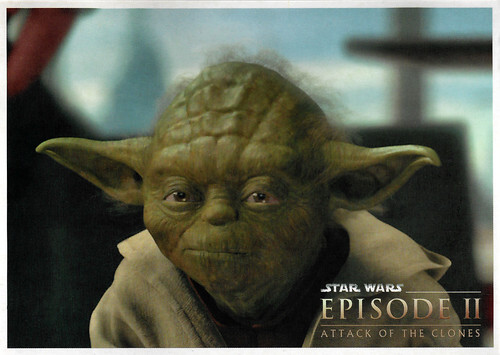
Vintage postcard, no. 744. Photo: Lucasfilm. Yoda in Star Wars: Episode II - Attack of the Clones (George Lucas, 2002).
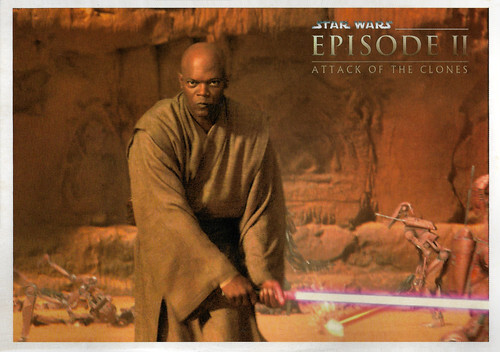
Vintage postcard, no. 745. Photo: Lucasfilm. Samuel L. Jackson as Mace Windu in Star Wars: Episode II - Attack of the Clones (George Lucas, 2002).
An iconic lightsaber duel
Star Wars: Episode II - Attack of the Clones (George Lucas, 2002) is compared to Star Wars: Episode I - The Phantom Menace (George Lucas, 1999) a superior achievement, but it still doesn't break much new ground.
The problem with both films is George Lucas' dialogue. His lines sound like the actors are reading them off of cue cards and some weak, unsatisfying sequences drag the speed of the film down. The two major storylines in the film are the political underpinnings that eventually lead to the start of the infamous Clone Wars, and the personal story of Anakin Skywalker (Hayden Christensen).
The latter storyline is problematic because it both traces Anakin's path to the dark side and becoming the father of Luke and Leia. Therefore, he must turn evil – and fall in love with Padmé (Natalie Portman) – at the same time. It does not work.
Still, the film is entertaining, the visual effects are spectacular and there is an iconic lightsaber duel at the end to top it all off. Lucas and company introduce a stunning variety of sprawling landscapes, crazy creatures, fanciful vehicles, and formidable weapons although he does tend to favour CGI backgrounds and creatures too much. But in this film, Jedi Master Yoda really comes alive, thanks to first-rate CG effects. Yoda is played to perfection by Frank Oz.
Natalie Portman is captivating as Queen Padmé and displays emotional depth. Happily, Lucas also introduces some exciting villains to boot Jango Fett (Temuera Morrison) and the devilishly evil Count Dooku ( Christopher Lee ). He also gives Ewan McGregor as Obi-Wan a lot more to do in this film. McGregor acquits himself very well as do such great actors like Samuel L. Jackson (Mace Windu) and Ian McDiarmid (Palpatine). And finally, there is again a heavenly John Williams score.
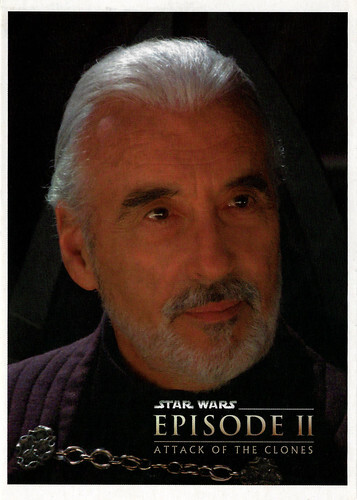
Vintage postcard, no. 743. Photo: Christopher Lee as Count Dooku in Star Wars: Episode II - Attack of the Clones (George Lucas, 2002).
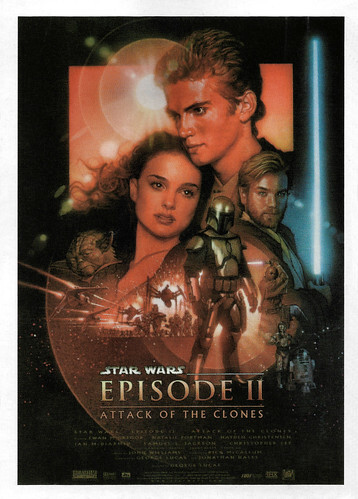
Vintage postcard by Billy Production, no. 23. Film poster for Star Wars: Episode II - Attack of the Clones (George Lucas, 2002).
Sources: Claudio Carvalho (IMDb), Wikipedia and IMDb.

Dutch postcard by Boomerang, Amsterdam, no. P10-02. postcard. Photo: Lucasfilm. Hayden Christensen as Anakin Skywalker in Star Wars: Episode II - Attack of the Clones (George Lucas, 2002).

Dutch postcard by Boomerang, Amsterdam, no. P10-02. Photo: Lucasfilm. Leeanna Walsman as Zam Wesell in Star Wars: Episode II - Attack of the Clones (George Lucas, 2002).

Singaporean postcard by ArtCard, no. 337, Collectable postcard series, no. 5 of 9. Photo: Lucasfilm. Samuel L. Jackson as Mace Windu in Star Wars: Episode II - Attack of the Clones (George Lucas, 2002). Caption: Mace Windu. A senior member of the Jedi Council, Mace Windu is a highly revered Jedi Master. Mace is a diplomat by nature and seeks peaceful solutions to the most volatile issues. However, with thousands of solar systems threatening to break away from the Galactic Republic, Mace believes the time has come to swift action. He leads a battalion of Jedi to the planet of Geonosis to rescue Anakin, Padmé and Obi-Wan and to neutralize Count Dooku's overwhelming forces.
An army of clones that has been under production for years
Ten years after the invasion of Naboo, the Galactic Republic is facing a Separatist movement and the former queen and now Senator Padmé Amidala (Natalie Portman) travels to Coruscant to vote on a project to create an army to help the Jedi to protect the Republic.
Upon arrival, she escapes from an attempt to kill her, and Obi-Wan Kenobi ( Ewan McGregor ) and his Padawan Anakin Skywalker (Hayden Christensen) are assigned to protect her. They chase the shape-shifter Zam Wessell (Leeanna Walsman) but she is killed by a poisoned dart before revealing who hired her.
The Jedi Council assigns Obi-Wan Kenobi and Anakin to discover who has tried to kill Amidala and to protect her in Naboo. Obi-Wan discovers that the dart is from the planet Kamino, and he heads to the remote planet. He finds an army of clones that has been under production for years for the Republic and that the bounty hunter Jango Fett (Temuera Morrison) was the matrix for the clones.
Meanwhile, Anakin and Amidala fall in love with each other, and he has nightmarish visions of his mother. They travel to his home planet, Tatooine, to see his mother, and he discovers that she has been abducted by Tusken Raiders. Anakin finds his mother dying, and he kills all of the Tusken tribe, including the women and children.
Obi-Wan follows Jango Fett to the planet Geonosis where he discovers who is behind the Separatist movement. He transmits his discoveries to Anakin since he cannot reach the Jedi Council. Who is the leader of the Separatist movement? Will Anakin receive Obi-Wan's message? And will the secret love between Anakin and Amidala succeed?

Vintage postcard, no. 744. Photo: Lucasfilm. Yoda in Star Wars: Episode II - Attack of the Clones (George Lucas, 2002).

Vintage postcard, no. 745. Photo: Lucasfilm. Samuel L. Jackson as Mace Windu in Star Wars: Episode II - Attack of the Clones (George Lucas, 2002).
An iconic lightsaber duel
Star Wars: Episode II - Attack of the Clones (George Lucas, 2002) is compared to Star Wars: Episode I - The Phantom Menace (George Lucas, 1999) a superior achievement, but it still doesn't break much new ground.
The problem with both films is George Lucas' dialogue. His lines sound like the actors are reading them off of cue cards and some weak, unsatisfying sequences drag the speed of the film down. The two major storylines in the film are the political underpinnings that eventually lead to the start of the infamous Clone Wars, and the personal story of Anakin Skywalker (Hayden Christensen).
The latter storyline is problematic because it both traces Anakin's path to the dark side and becoming the father of Luke and Leia. Therefore, he must turn evil – and fall in love with Padmé (Natalie Portman) – at the same time. It does not work.
Still, the film is entertaining, the visual effects are spectacular and there is an iconic lightsaber duel at the end to top it all off. Lucas and company introduce a stunning variety of sprawling landscapes, crazy creatures, fanciful vehicles, and formidable weapons although he does tend to favour CGI backgrounds and creatures too much. But in this film, Jedi Master Yoda really comes alive, thanks to first-rate CG effects. Yoda is played to perfection by Frank Oz.
Natalie Portman is captivating as Queen Padmé and displays emotional depth. Happily, Lucas also introduces some exciting villains to boot Jango Fett (Temuera Morrison) and the devilishly evil Count Dooku ( Christopher Lee ). He also gives Ewan McGregor as Obi-Wan a lot more to do in this film. McGregor acquits himself very well as do such great actors like Samuel L. Jackson (Mace Windu) and Ian McDiarmid (Palpatine). And finally, there is again a heavenly John Williams score.

Vintage postcard, no. 743. Photo: Christopher Lee as Count Dooku in Star Wars: Episode II - Attack of the Clones (George Lucas, 2002).

Vintage postcard by Billy Production, no. 23. Film poster for Star Wars: Episode II - Attack of the Clones (George Lucas, 2002).
Sources: Claudio Carvalho (IMDb), Wikipedia and IMDb.
Published on December 26, 2022 22:00
December 25, 2022
Star Wars: Episode I - The Phantom Menace (1999)
George Lucas's epic space opera Star Wars: Episode I – The Phantom Menace (1999) is the fourth film in the Star Wars film series and set 32 years before the original trilogy, during the era of the Galactic Republic. It is the first film of the prequel trilogy and the first chronological chapter of the "Skywalker Saga". The film stars Liam Neeson, Ewan McGregor, Natalie Portman and the young Jake Lloyd.
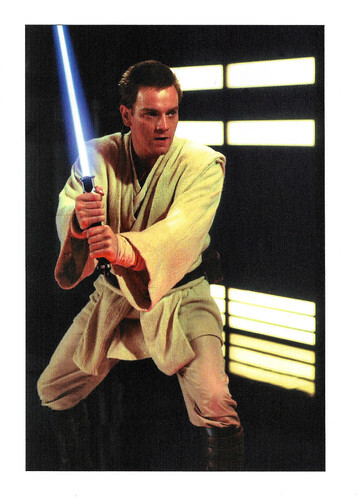
British double card by Danilo, London, no. SW032. Photo: Lucasfilm. Ewan McGregor as Obi-Wan Kenobi in Star Wars: Episode I - The Phantom Menace (George Lucas, 1999).
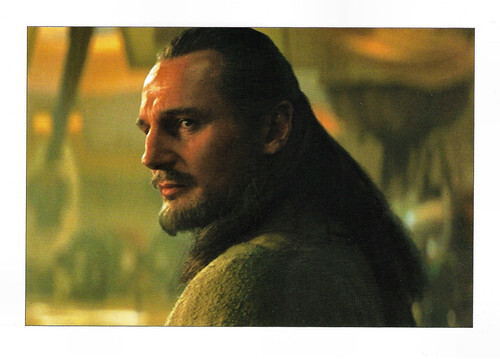
British double card by Danilo, London, no. SW039. Photo: Lucasfilm. Liam Neeson as Qui-Gon Jinn in Star Wars - Episode I - The Phantom Menace (George Lucas, 1999).
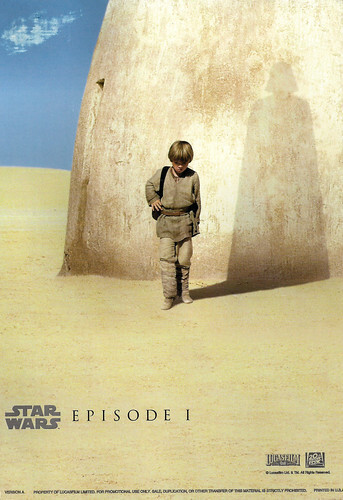
American postcard by Classico San Francisco, no. 106-048. Photo: Lucasfilm / 20th Century Fox. Jake Lloyd as Anakin Skywalker in Star Wars: Episode I - The Phantom Menace (George Lucas, 1999).
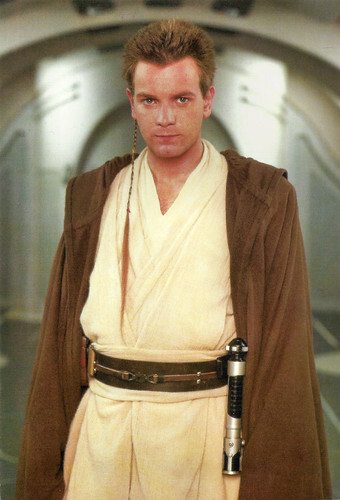
American postcard by Classico San Francisco, no. 106-015. Photo: Lucasfilm. Ewan McGregor as Obi-Wan-Kenobi in Star Wars: Episode I - The Phantom Menace (George Lucas, 1999).
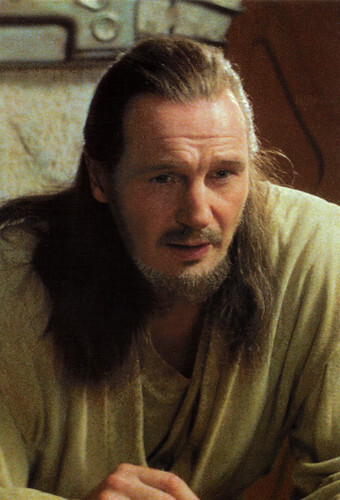
American postcard by Classico San Francisco, no. 106-016. Photo: Lucasfilm. Liam Neeson as Qui-Gon Jinn in Star Wars: Episode I - The Phantom Menace (George Lucas, 1999).
A young boy, known as Anakin Skywalker
The evil Trade Federation, led by Nute Gunray, creates turmoil in the Galactic Republic by blockading the planet Naboo in protest of recent legislation taxing major galactic trade routes.
Jedi Knights Qui-Gon Jinn (Liam Neeson) and his apprentice Obi-Wan Kenobi ( Ewan McGregor ) are sent to confront the leaders. Darth Sidious (Ian McDiarmid), a Sith Lord and the Trade Federation's secret benefactor, orders the Viceroy to kill the Jedi and begin an invasion with an army of battle droids, but the Jedi escape and flee to Naboo.
Along with their new Gungan friend, Jar Jar Binks (Ahmed Best), they head to Naboo to warn Queen Padmé Amidala of Naboo (Natalie Portman), but droids have already started to capture Naboo and the Queen is not safe there. Eventually, they land on Tatooine, where they become friends with a young boy known as Anakin Skywalker (Jake Lloyd).
Qui-Gon is curious about the boy and sees a bright future for him. The group must now find a way of getting to Coruscant and finally solve this trade dispute, but there is someone else hiding in the shadows.
Are the Sith really extinct? Is the Queen really who she says she is? And what's so special about this young boy? May he bring balance to the Force?
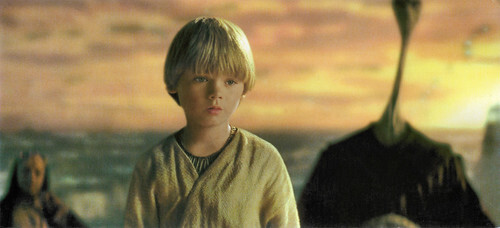
American postcard by Classico San Francisco, no. 490-001. Photo: Lucasfilm. Jake Lloyd as Anakin Skywalker in Star Wars: Episode I - The Phantom Menace (George Lucas, 1999).
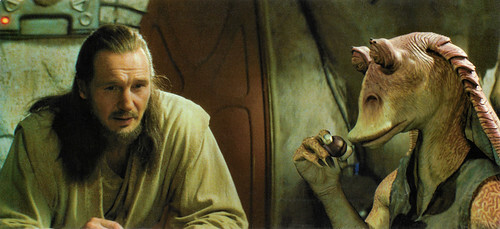
American postcard by Classico San Francisco, no. 490-002. Photo: Lucasfilm. Liam Neeson as Qui-Gon Jinn and Ahmed Best as Jar Jar Binks in Star Wars: Episode I - The Phantom Menace (George Lucas, 1999).
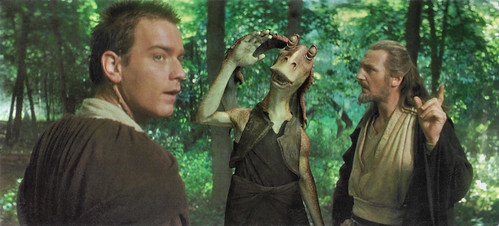
American postcard by Classico San Francisco, no. 490-003. Photo: Lucasfilm. Ewan McGregor as Obi-Wan Kenobi, Ahmed Best as Jar Jar Binks and Liam Neeson as Qui-Gon Jinn in Star Wars: Episode I - The Phantom Menace (George Lucas, 1999).
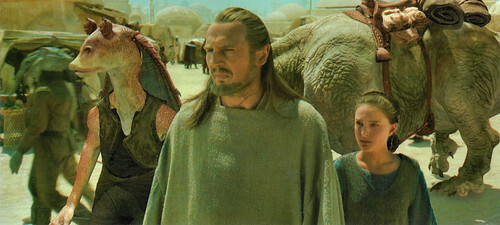
American postcard by Classico San Francisco, no. 490-005. Photo: Lucasfilm. Ahmed Best as Jar Jar Binks, Liam Neeson as Qui-Gon Jinn and Natalie Portman as Padme in Star Wars: Episode I - The Phantom Menace (George Lucas, 1999).
The action is constantly exhilarating
Following the release of Episode 6 of the Star Wars saga, Return of the Jedi (Christian Marquand, 1980), talks of a follow-up were proposed, but George Lucas was unmotivated to return to the franchise. During the hiatus, the backstories he created for the characters, particularly Anakin's own backstory, sparked interest in him to develop a prequel trilogy during the 1990s.
After he determined that computer-generated imagery (CGI) had advanced to the level he wanted for the prequel trilogy's visual effects, Lucas began writing The Phantom Menace in 1993, and production began in 1994.
Filming started in 1997 — at locations including Leavesden Film Studios and the Tunisian desert. The film marked Lucas' first directorial effort after a 22-year hiatus following the original Star Wars (1977). The film's premiere in 1999 was extensively covered by the media and was widely anticipated because of the large cultural following the Star Wars saga had cultivated.
Upon its release, the film received mixed reviews. Star Wars: Episode 1- The Phantom Menace (George Lucas, 1999) is worth a watch, but it is one of the weaker episodes of the Star Wars saga. On a visual and technical level, it looks terrific, with splendid special effects, stunning cinematography and fine scenery and costumes. The script is fairly decent, but lacks the sophistication of Star Wars - A New Hope (1977) or Return of the Jedi (1980), but does have some memorable lines.
The action is constantly exhilarating, and Darth Maul, well-played by Ray Park is a very good villain. Most of the performances are very good, especially Natalie Portman as Queen Padma who looked stunning and Jake Lloyd as Anakin Skywalker who shone with his confident charm. And the music score by John Williams was outstanding, definitely one of his best works.
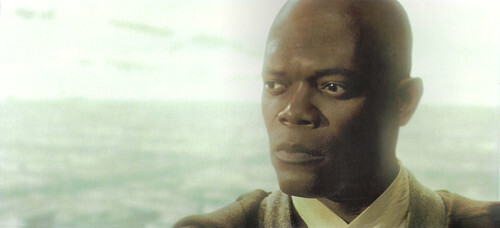
American postcard by Classico San Francisco, no. 490-014. Photo: Lucasfilm. Samuel Jackson as Mace Windu in Star Wars: Episode I - The Phantom Menace (George Lucas, 1999).
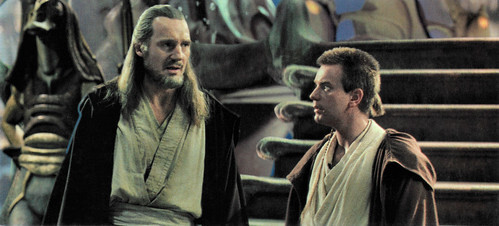
American postcard by Classico San Francisco, no. 490-020. Photo: Lucasfilm. Liam Neeson as Qui-Gon Jinn and Ewan McGregor as Obi-Wan Kenobi in Star Wars: Episode I - The Phantom Menace (George Lucas, 1999).
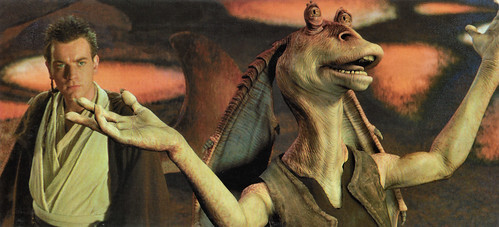
American postcard by Classico San Francisco, no. 490-027. Photo: Lucasfilm. Ewan McGregor as Obi-Wan Kenobi and Ahmed Best as Jar Jar Binks in Star Wars: Episode I - The Phantom Menace (George Lucas, 1999).
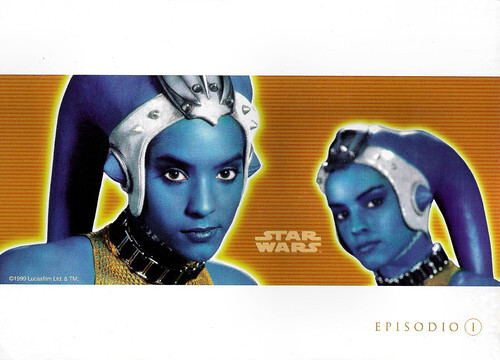
Spanish postcard by Postalfree. Photo: Lucasfilm. Star Wars: Episode I - The Phantom Menace (George Lucas, 1999).
Their energy, their sense of fun, their colourful inventions and their state-of-the-art special effects
Bethany Cox at IMDb : "However, there were things about this film that did disappoint. One is despite the awesome visuals, strong music score and good characters, the story never quite distinguished itself. It did take a while to get going, and when it did try to get going and you could tell it wanted to, it was further disadvantaged by the uneven pacing."
Roger Ebert: "If it were the first "Star Wars" movie, "The Phantom Menace" would be hailed as a visionary breakthrough. But this is the fourth movie of the famous series, and we think we know the territory; many of the early reviews have been blase, paying lip service to the visuals and wondering why the characters aren't better developed. How quickly do we grow accustomed to wonders.
(...) the stories of the "Star Wars" movies have always been space operas, and that the importance of the movies comes from their energy, their sense of fun, their colorful inventions and their state-of-the-art special effects. I do not attend with the hope of gaining insights into human behavior. Unlike many movies, these are made to be looked at more than listened to, and George Lucas and his collaborators have filled "The Phantom Menace" with wonderful visuals."
Despite the mixed reception, The Phantom Menace was a box-office success and broke numerous box-office records during its debut. It grossed more than $924.3 million worldwide during its initial theatrical run, becoming the highest-grossing film of 1999, the second-highest-grossing film worldwide and in North America (behind Titanic), and the highest-grossing Star Wars film at the time (inflation notwithstanding).
A 3D reissue, which earned an additional $102.7 million and brought the film's overall worldwide takings to over $1 billion, was released in 2012.
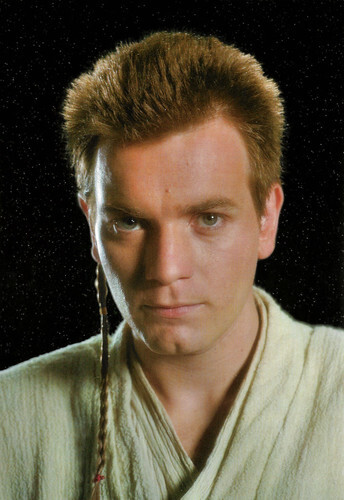
American postcard by Classico San Francisco, no. 106-002. Photo: Lucasfilm. Ewan McGregor as Obi-Wan Kenobi in Star Wars: Episode I - The Phantom Menace (George Lucas, 1999).
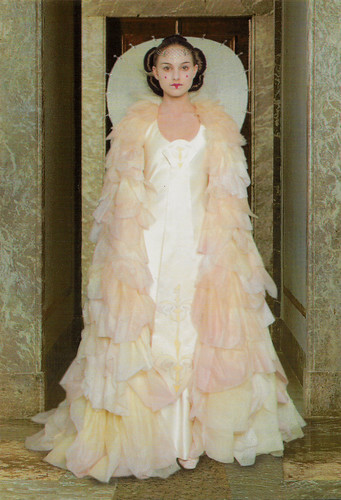
American postcard by Classico San Francisco, no. 106-004. Photo: Lucasfilm. Natalie Portman as Queen Amidala in Star Wars: Episode I - The Phantom Menace (George Lucas, 1999).
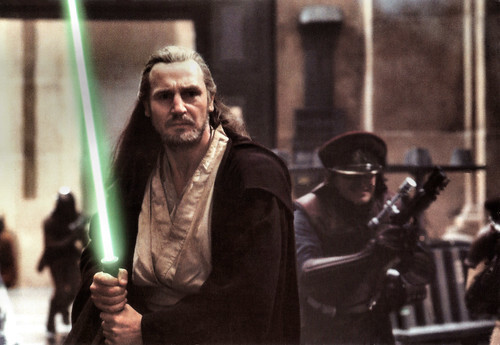
American postcard by Classico San Francisco, no. 106-017. Photo: Lucasfilm. Liam Neeson as Qui-Gon Jinn in Star Wars - Episode I - The Phantom Menace (George Lucas, 1999).
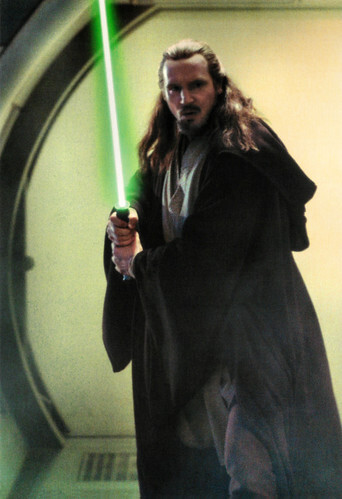
American postcard by Classico San Francisco, no. 106-039. Photo: Lucasfilm. Liam Neeson as Qui-Gon Jinn in Star Wars - Episode I - The Phantom Menace (George Lucas, 1999).
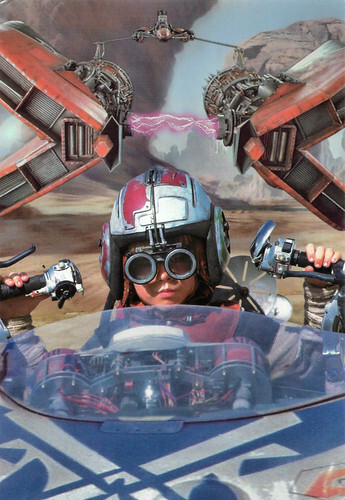
American postcard by Classico San Francisco, no. 106-029. Photo: Lucasfilm. Jake Lloyd as Anakin Skywalker in Star Wars: Episode I - The Phantom Menace (George Lucas, 1999).
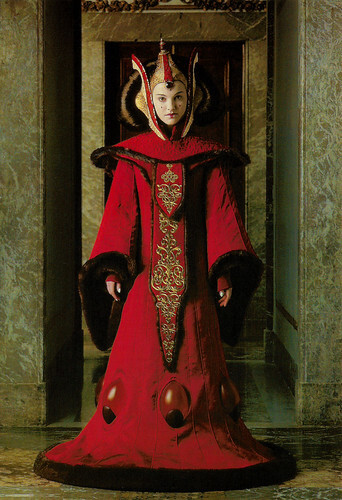
American postcard by Classico San Francisco, no. 106-032. Photo: Lucasfilm. Natalie Portman as Queen Amidala in Star Wars: Episode I - The Phantom Menace (George Lucas, 1999).
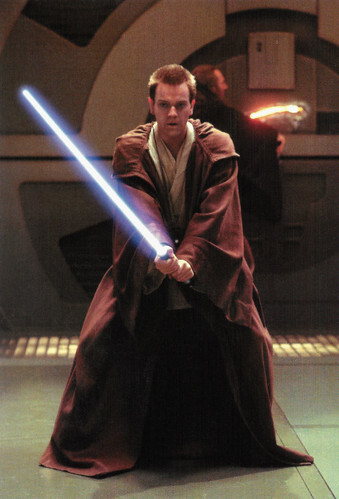
American postcard by Classico San Francisco, no. 106-035. Photo: Lucasfilm. Ewan McGregor as Obi-Wan Kenobi in Star Wars: Episode I - The Phantom Menace (George Lucas, 1999).

American postcard by Classico San Francisco, no. 106-039. Photo: Lucasfilm. Liam Neeson as Qui-Gon Jinn in Star Wars - Episode I - The Phantom Menace (George Lucas, 1999).
Sources: Bethany Cox (IMDb), Roger Ebert (Roger Ebert.com), Wikipedia and IMDb.

British double card by Danilo, London, no. SW032. Photo: Lucasfilm. Ewan McGregor as Obi-Wan Kenobi in Star Wars: Episode I - The Phantom Menace (George Lucas, 1999).

British double card by Danilo, London, no. SW039. Photo: Lucasfilm. Liam Neeson as Qui-Gon Jinn in Star Wars - Episode I - The Phantom Menace (George Lucas, 1999).

American postcard by Classico San Francisco, no. 106-048. Photo: Lucasfilm / 20th Century Fox. Jake Lloyd as Anakin Skywalker in Star Wars: Episode I - The Phantom Menace (George Lucas, 1999).

American postcard by Classico San Francisco, no. 106-015. Photo: Lucasfilm. Ewan McGregor as Obi-Wan-Kenobi in Star Wars: Episode I - The Phantom Menace (George Lucas, 1999).

American postcard by Classico San Francisco, no. 106-016. Photo: Lucasfilm. Liam Neeson as Qui-Gon Jinn in Star Wars: Episode I - The Phantom Menace (George Lucas, 1999).
A young boy, known as Anakin Skywalker
The evil Trade Federation, led by Nute Gunray, creates turmoil in the Galactic Republic by blockading the planet Naboo in protest of recent legislation taxing major galactic trade routes.
Jedi Knights Qui-Gon Jinn (Liam Neeson) and his apprentice Obi-Wan Kenobi ( Ewan McGregor ) are sent to confront the leaders. Darth Sidious (Ian McDiarmid), a Sith Lord and the Trade Federation's secret benefactor, orders the Viceroy to kill the Jedi and begin an invasion with an army of battle droids, but the Jedi escape and flee to Naboo.
Along with their new Gungan friend, Jar Jar Binks (Ahmed Best), they head to Naboo to warn Queen Padmé Amidala of Naboo (Natalie Portman), but droids have already started to capture Naboo and the Queen is not safe there. Eventually, they land on Tatooine, where they become friends with a young boy known as Anakin Skywalker (Jake Lloyd).
Qui-Gon is curious about the boy and sees a bright future for him. The group must now find a way of getting to Coruscant and finally solve this trade dispute, but there is someone else hiding in the shadows.
Are the Sith really extinct? Is the Queen really who she says she is? And what's so special about this young boy? May he bring balance to the Force?

American postcard by Classico San Francisco, no. 490-001. Photo: Lucasfilm. Jake Lloyd as Anakin Skywalker in Star Wars: Episode I - The Phantom Menace (George Lucas, 1999).

American postcard by Classico San Francisco, no. 490-002. Photo: Lucasfilm. Liam Neeson as Qui-Gon Jinn and Ahmed Best as Jar Jar Binks in Star Wars: Episode I - The Phantom Menace (George Lucas, 1999).

American postcard by Classico San Francisco, no. 490-003. Photo: Lucasfilm. Ewan McGregor as Obi-Wan Kenobi, Ahmed Best as Jar Jar Binks and Liam Neeson as Qui-Gon Jinn in Star Wars: Episode I - The Phantom Menace (George Lucas, 1999).

American postcard by Classico San Francisco, no. 490-005. Photo: Lucasfilm. Ahmed Best as Jar Jar Binks, Liam Neeson as Qui-Gon Jinn and Natalie Portman as Padme in Star Wars: Episode I - The Phantom Menace (George Lucas, 1999).
The action is constantly exhilarating
Following the release of Episode 6 of the Star Wars saga, Return of the Jedi (Christian Marquand, 1980), talks of a follow-up were proposed, but George Lucas was unmotivated to return to the franchise. During the hiatus, the backstories he created for the characters, particularly Anakin's own backstory, sparked interest in him to develop a prequel trilogy during the 1990s.
After he determined that computer-generated imagery (CGI) had advanced to the level he wanted for the prequel trilogy's visual effects, Lucas began writing The Phantom Menace in 1993, and production began in 1994.
Filming started in 1997 — at locations including Leavesden Film Studios and the Tunisian desert. The film marked Lucas' first directorial effort after a 22-year hiatus following the original Star Wars (1977). The film's premiere in 1999 was extensively covered by the media and was widely anticipated because of the large cultural following the Star Wars saga had cultivated.
Upon its release, the film received mixed reviews. Star Wars: Episode 1- The Phantom Menace (George Lucas, 1999) is worth a watch, but it is one of the weaker episodes of the Star Wars saga. On a visual and technical level, it looks terrific, with splendid special effects, stunning cinematography and fine scenery and costumes. The script is fairly decent, but lacks the sophistication of Star Wars - A New Hope (1977) or Return of the Jedi (1980), but does have some memorable lines.
The action is constantly exhilarating, and Darth Maul, well-played by Ray Park is a very good villain. Most of the performances are very good, especially Natalie Portman as Queen Padma who looked stunning and Jake Lloyd as Anakin Skywalker who shone with his confident charm. And the music score by John Williams was outstanding, definitely one of his best works.

American postcard by Classico San Francisco, no. 490-014. Photo: Lucasfilm. Samuel Jackson as Mace Windu in Star Wars: Episode I - The Phantom Menace (George Lucas, 1999).

American postcard by Classico San Francisco, no. 490-020. Photo: Lucasfilm. Liam Neeson as Qui-Gon Jinn and Ewan McGregor as Obi-Wan Kenobi in Star Wars: Episode I - The Phantom Menace (George Lucas, 1999).

American postcard by Classico San Francisco, no. 490-027. Photo: Lucasfilm. Ewan McGregor as Obi-Wan Kenobi and Ahmed Best as Jar Jar Binks in Star Wars: Episode I - The Phantom Menace (George Lucas, 1999).

Spanish postcard by Postalfree. Photo: Lucasfilm. Star Wars: Episode I - The Phantom Menace (George Lucas, 1999).
Their energy, their sense of fun, their colourful inventions and their state-of-the-art special effects
Bethany Cox at IMDb : "However, there were things about this film that did disappoint. One is despite the awesome visuals, strong music score and good characters, the story never quite distinguished itself. It did take a while to get going, and when it did try to get going and you could tell it wanted to, it was further disadvantaged by the uneven pacing."
Roger Ebert: "If it were the first "Star Wars" movie, "The Phantom Menace" would be hailed as a visionary breakthrough. But this is the fourth movie of the famous series, and we think we know the territory; many of the early reviews have been blase, paying lip service to the visuals and wondering why the characters aren't better developed. How quickly do we grow accustomed to wonders.
(...) the stories of the "Star Wars" movies have always been space operas, and that the importance of the movies comes from their energy, their sense of fun, their colorful inventions and their state-of-the-art special effects. I do not attend with the hope of gaining insights into human behavior. Unlike many movies, these are made to be looked at more than listened to, and George Lucas and his collaborators have filled "The Phantom Menace" with wonderful visuals."
Despite the mixed reception, The Phantom Menace was a box-office success and broke numerous box-office records during its debut. It grossed more than $924.3 million worldwide during its initial theatrical run, becoming the highest-grossing film of 1999, the second-highest-grossing film worldwide and in North America (behind Titanic), and the highest-grossing Star Wars film at the time (inflation notwithstanding).
A 3D reissue, which earned an additional $102.7 million and brought the film's overall worldwide takings to over $1 billion, was released in 2012.

American postcard by Classico San Francisco, no. 106-002. Photo: Lucasfilm. Ewan McGregor as Obi-Wan Kenobi in Star Wars: Episode I - The Phantom Menace (George Lucas, 1999).

American postcard by Classico San Francisco, no. 106-004. Photo: Lucasfilm. Natalie Portman as Queen Amidala in Star Wars: Episode I - The Phantom Menace (George Lucas, 1999).

American postcard by Classico San Francisco, no. 106-017. Photo: Lucasfilm. Liam Neeson as Qui-Gon Jinn in Star Wars - Episode I - The Phantom Menace (George Lucas, 1999).

American postcard by Classico San Francisco, no. 106-039. Photo: Lucasfilm. Liam Neeson as Qui-Gon Jinn in Star Wars - Episode I - The Phantom Menace (George Lucas, 1999).

American postcard by Classico San Francisco, no. 106-029. Photo: Lucasfilm. Jake Lloyd as Anakin Skywalker in Star Wars: Episode I - The Phantom Menace (George Lucas, 1999).

American postcard by Classico San Francisco, no. 106-032. Photo: Lucasfilm. Natalie Portman as Queen Amidala in Star Wars: Episode I - The Phantom Menace (George Lucas, 1999).

American postcard by Classico San Francisco, no. 106-035. Photo: Lucasfilm. Ewan McGregor as Obi-Wan Kenobi in Star Wars: Episode I - The Phantom Menace (George Lucas, 1999).

American postcard by Classico San Francisco, no. 106-039. Photo: Lucasfilm. Liam Neeson as Qui-Gon Jinn in Star Wars - Episode I - The Phantom Menace (George Lucas, 1999).
Sources: Bethany Cox (IMDb), Roger Ebert (Roger Ebert.com), Wikipedia and IMDb.
Published on December 25, 2022 22:00
December 24, 2022
Star Wars: Episode V - The Empire Strikes Back (1980) and Episode VI - Return of the Jedi (1983)
In Star Wars: Episode V - The Empire Strikes Back (Irvin Kershner, 1980), the adventure continues that started in Star Wars: Episode IV - A New Hope (George Lucas, 1977). It is the fifth, but second made, instalment in the Star Wars series. The screenplay was written by Leigh Brackett and Lawrence Kasdan. Star Wars: Episode VI - Return of the Jedi (Richard Marquand, 1983) is the flawed, epic conclusion to the original Star Wars trilogy. The screenplay is by Lawrence Kasdan and George Lucas from a story by Lucas, who was also the executive producer. The film grossed $374 million during its initial theatrical run, becoming the highest-grossing film of 1983. Overall, the film was well-received by critics, but Return of the Jedi is widely considered to be the weakest film in the original trilogy.

French postcard by Studio Erving, Paris, no. 696. Photo: Lucasfilm Ltd. Harrison Ford as Han Solo in Star Wars: Episode IV - A New Hope (George Lucas, 1977).

American postcard by Classico San Francisco, no. 105-519. Photo: Lucasfilm Ltd. Carrie Fisher as Princess Leia in Star Wars: Episode IV - A New Hope (George Lucas, 1977).

American postcard by Classico San Francisco, no. 105-062. Photo: Lucasfilm Ltd. Anthony Daniels as C-3PO and Kenny Baker as R2-D2 in Star Wars: Episode IV - A New Hope (George Lucas, 1977).
The Empire Strikes Back (1980)
Three years have passed since Star Wars: Episode IV - A New Hope (George Lucas, 1977). In Star Wars Episode V - The Empire Strikes Back (Irvin Kershner, 1980), Luke Skywalker (Mark Hamill) and Han Solo ( Harrison Ford ) are now officially members of the Rebels, holed up on the ice planet Hoth.
However, Han is wanted en masse by bounty hunters because of his debt to Jabba the Hutt. Moreover, the Galactic Empire is bent on revenge after the destruction of the Death Star and has launched a massive search for the rebels.
On Hoth, Luke is attacked by a wampa. The latter takes the unconscious Luke to an ice cave, where Luke (having woken up again) cuts off the wampa's arm with his lightsaber and flees outside. At the Rebel Alliance on the same planet, Han notices that Luke is not coming back, and goes looking for him.
While Han is on a quest, Luke sees the ghost of his old teacher Obi-Wan Kenobi (Alec McGuinness). The latter tells him to go to the planet Dagobah to look for Yoda, the last surviving Jedi master. He can train Luke further. Then Obi-Wan's ghost disappears and Han arrives. Luke and Han are rescued by a snow speeder, which takes them back to the Rebel Alliance.
The Rebels face an attack by the Imperial forces and its AT-AT walkers and they are brutally overpowered by the Empire. While Han Solo, Chewbacca (Peter Mayhew), Princess Leia (Carrie Fisher) and C-3PO (Anthony Daniels) escape in the damaged Millennium Falcon. Luke Skywalker travels with R2-D2 (Kenny Baker) to Dagobah in search of Yoda (voice of Frank Oz).
Only with the Jedi Master's help will Luke survive when the Dark Side of the Force beckons him into the ultimate duel with Darth Vader. Luke begins Jedi training with Yoda, while his friends are pursued across the galaxy by Darth Vader (David Prowse and the voice of James Earl Jones) and bounty hunter Boba Fett (Jeremy Bulloch).

Spanish postcard by Memory Card, no. 131. Photo: Lucasfilm LTD. Poster for Star Wars: Episode V - The Empire Strikes Back (Irvin Kershner, 1980).
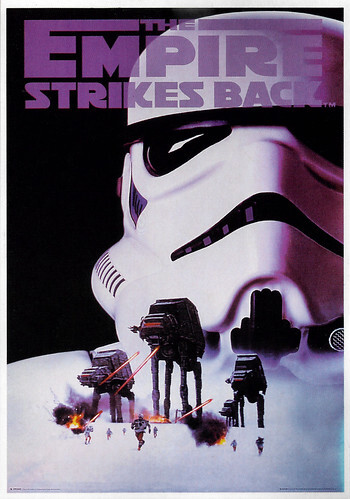
Vintage postcard, no. 606. Photo: Lucasfilm LTD. Poster for Star Wars: Episode V - The Empire Strikes Back (Irvin Kershner, 1980).
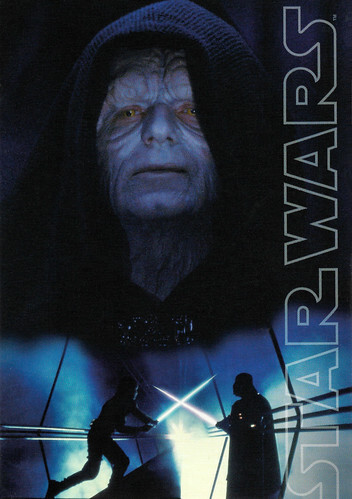
Belgian postcard by Mobistar no. 131. Photo: Lucasfilm LTD., 2000. Poster for Star Wars: Episode V - The Empire Strikes Back (Irvin Kershner, 1980).
A risky move which would later pay off several times over
George Lucas had originally planned to only executive produce and finance Star Wars Episode V - The Empire Strikes Back (1980), leaving the directorial duties in the hands of Irvin Kershner and day-to-day producing duties to Gary Kurtz. Directing Star Wars (1977) had left Lucas exhausted and sick, and he had intended to take time off to start to focus on the expansion of the Lucasfilm company and spending more time with his then-wife Marcia Lucas so that they could start a family and finish construction on Skywalker Ranch.
In order to avoid sharing creative rights, George Lucas decided to avoid using a major studio to finance Star Wars Episode V - The Empire Strikes Back (Irvin Kershner, 1980). Instead, he bankrolled the $18 million production himself, using a combination of his profits from Star Wars (George Lucas, 1977) and a bank loan.
Although the move was risky, it would later pay off several times over. However, when production on The Empire Strikes Back (1980) ran over budget and behind schedule, Lucas had to step in and take a more hands-on role, going on location to oversee filming and even directing portions of the film. A disastrous rough cut of the film proved to be incoherent during screenings, and facing the possibility of financial ruin, Lucas then re-edited the film himself with even worse results.
Extensive re-shoots and further post-production effects work put enormous strain on his health, his marriage, and his relationships with Kershner and Kurtz. To preserve the dramatic opening of the Star Wars films, George Lucas insisted on moving all the credits to the end of the film. However, although the Writers' Guild and Directors' Guild had begrudgingly allowed this on Star Wars (1977) because that film wasn't expected to be very successful, they resented the trend being continued on the sequel.
First, they tried to pull the film from release but were unsuccessful. They then fined Lucas heavily and tried to fine Irvin Kershner, but Lucas paid all of the fines himself (nearly $250,000). Lucas then bitterly dropped his membership in the Writers' Guild, Directors' Guild, and the Motion Picture Association of America, a move that has hindered his hiring choices for later films.
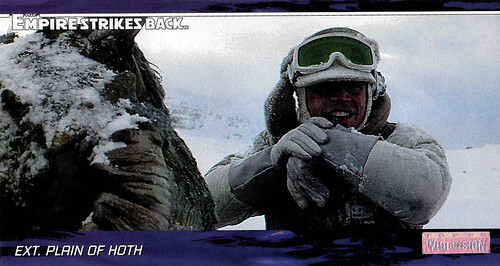
American collectors card by Topps Widevision, no. 4. Photo: Lucasfilm LTD. Mark Hamill as Luke Skywalker in Star Wars: Episode V - The Empire Strikes Back (Irvin Kershner, 1980). Caption: Ext. Plain of Hoth - Pulling off his protective goggles, Luke Skywalker notices something in the sky. He takes a pair of electrobinoculars from his utility belt and through them sees smoke rising from where the probe droid has crashed. The wind whips at Luke's fur-lined cap as he activates a comlink transmitter.
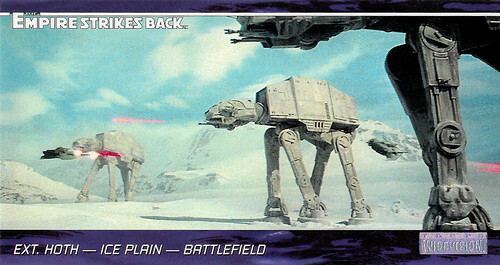
American collectors card by Topps Widevision, no. 24. Photo: Lucasfilm LTD. The AT-AT walkers in Star Wars: Episode V - The Empire Strikes Back (Irvin Kershner, 1980). Caption: Ext. Hoth - Ice plain - Battlefield. The battle on Hoth continues to rage. A giant At-At head swivels and figures, striking a snowspeeder and sending it crashing in a ball of flames. Elsewhere, Rebel troops in the snow french fire on the approaching walkers, as snow and ice explode all around them.

American collectors card by Topps Widevision, no. 68. Photo: Lucasfilm LTD. Yoda (with the voice of Frank Oz) in Star Wars: Episode V - The Empire Strikes Back (Irvin Kershner, 1980). Caption: Ext. Dagobah. Yoda turns to see a huge dead, black tree, its base surrounded by a few feet of water. Giant, twisted roots form a dark and sinister cave on one side. Luke stares at the tree, trembling. "What's in there?" he asks Yoda. "Only what you take with you." Yoda answers.
One of the most expensive films of its day
A new character in Star Wars Episode V - The Empire Strikes Back (1980) was Yoda, originally designed by British make-up artist Stuart Freeborn and voiced by Frank Oz. In the original Star Wars trilogy, he is realised as a puppet, controlled by Oz. The Dagobah set needed to be elevated to give Frank Oz and three other puppeteers room to control the Yoda puppet from below.
For proper interaction, Mark Hamill was given an earpiece so he could hear Oz doing Yoda's voice. On numerous occasions, director Irvin Kershner would give a direction to Yoda by mistake, and Oz would have to remind him who to speak to.
Harrison Ford wanted Han Solo to die at the end of this second film, and he did not want to play the character again. When Star Wars (1977) was made, Carrie Fisher and Mark Hamill were signed for a three-movie deal, but Ford refused since the character had played his part already in the second film.
Instead of killing off the character, George Lucas had a different idea. He opted for Han to be frozen in carbonite, in case Ford had a change of heart and agreed to return in the third film, the character would be revived. And yes, Han Solo still had a heroic part to play in Star Wars: Episode VI - Return of the Jedi (Richard Marquand, 1983).
Lucas recovered his investment within three months of the release of Star Wars Episode V - The Empire Strikes Back (1980). After the various increases in budget, the film became one of the most expensive of its day and after the bank threatened to pull his loan, George Lucas was forced to approach Twentieth Century Fox. Lucas made a deal with the studio to secure the loan in exchange for paying the studio more money but without the loss of his sequel and merchandising rights.
After the film's box-office success, unhappiness at the studio over the deal's generosity to Lucas caused studio president Alan Ladd, Jr. to quit. Lucas, however, showed gratitude far beyond the Hollywood norm by sharing the profits with his employees (nearly $5 million in bonuses). Though the film proved to be an enormous commercial and critical success, George Lucas would never work with Gary Kurtz again, and his marriage with Marcia Lucas dissolved a couple of years later.

American collectors card by Topps Widevision, no. 78. Photo: Lucasfilm LTD. Yoda (with the voice of Frank Oz) in Star Wars: Episode V - The Empire Strikes Back (Irvin Kershner, 1980). Caption: Ext. Dagobah - Bog. Luke is unable to raise his ship from the bog with his levitation skills. Quietly, Yoda turns towards the sunken x-wing fighter. With his eyes closed, he raises his arm and points at the ship. Soon the fighter rises above the water and moves forward as Artoo beeps in terror and scoots away.
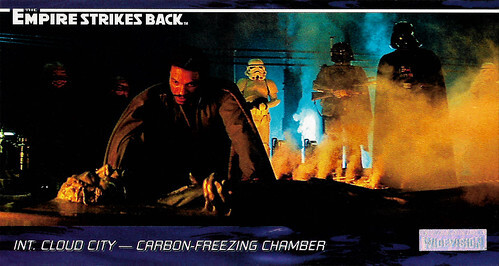
American collectors card by Topps Widevision, no. 106. Photo: Lucasfilm LTD. Billie Dee Williams as Lando in Star Wars Episode: V - The Empire Strikes Back (Irvin Kershner, 1980). Caption: Int. Cloud City - Carbon-freezing chamber. A huge, mechanical tong lifts the steaming, metal-encased Han Solo out of the carbon vat and stands him on the platform. Some Ugnaughts rush over and push the block over onto the platform. They then attach an electric box onto the structure and step away. Lando kneels and adjusts some knobs, measuring the heat. Seeing Han is still alive, Lando shakes his head in relief.
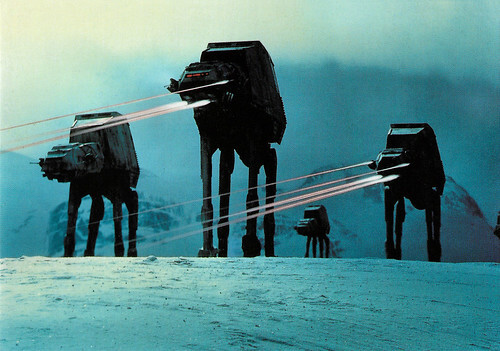
German postcard by Filmwelt Berlin, Bad Münder, no. SW 5.049. Image: Lucasfilm. Publicity still for Star Wars: Episode V - The Empire Strikes Back (Irvin Kershner, 1980).
Star Wars Episode VI - Return of the Jedi (1983)
A long time ago, in a galaxy far, far away..... Star Wars Episode VI - Return of the Jedi (1983) takes place a year after Han Solo has been frozen in carbonite to be transported to crime lord Jabba the Hutt, a large slug-like alien, for a bounty.
Luke Skywalker heads to Dagobah to finish his training with Yoda; however, the Jedi is dying and he confirms that Darth Vader (David Prowse) is his father. Obi-Wan Kenobi's Force spirit later tells Luke that Leia is his twin sister and that he must face Vader again to finish his training and defeat the Empire.
C-3PO and R2-D2 are sent to crime lord Jabba's palace in the desert world of Tatooine in a trade bargain made by Luke Skywalker to rescue Han, who is still frozen. Disguised as the bounty hunter Boushh, Princess Leia sneaks into the palace under the pretence of collecting the bounty on Chewbacca and unfreezes Han but is caught by Jabba and chained to him as his slave.
Luke shows up and after many adventures and fights, Leia strangles Jabba to death with her slave chains and is freed by Luke. Meanwhile, the rebels discover that the Empire is building a new Death Star more powerful than the first one that is protected by an energy shield generated by a generator on planet Endor.
Han Solo and Princess Leia reaffirm their love, and team with Chewbacca, the Ewoks, and droids C-3PO and R2-D2 to aid in the disruption of the Dark Side, and the defeat of the evil emperor. The Rebel Fleet led by Lando Calrissian battles with the Imperial Fleet while they wait for the shields to go down. Luke has a final showdown with Darth Vader. He struggles to help dis father back from the dark side without falling into the Emperor's trap.
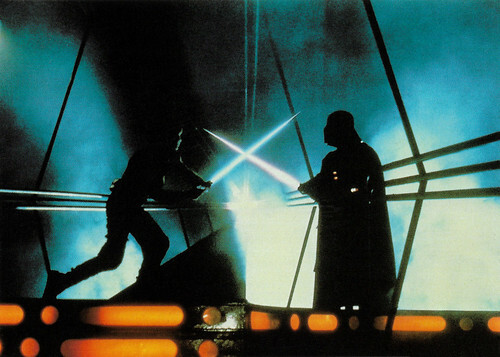
Vintage postcard. Image: Lucasfilm. Mark Hamill and David Prowse in Star Wars: Episode V - The Empire Strikes Back (Irvin Kershner, 1980).
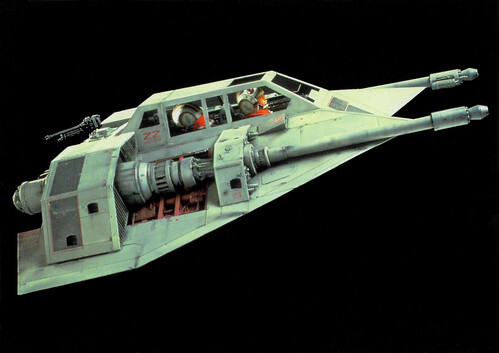
Vintage postcard. Image: Lucasfilm. Publicity still for Star Wars: Episode V - The Empire Strikes Back (Irvin Kershner, 1980).
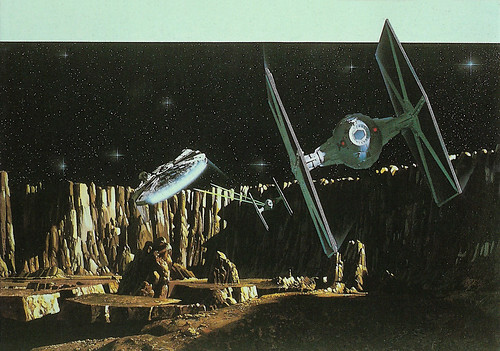
West-German postcard by Filmwelt Berlin, Bad Gmünder, no. SW 5.038. Image: Lucasfilm. Publicity still for Star Wars: Episode V - The Empire Strikes Back (Irvin Kershner, 1980).
Priority on story or spectacle?
Star Wars Episode VI - Return of the Jedi (Richard Marquand, 1983) is action-packed with a tremendous triple battle at the end. The final lightsaber battle between Vader and Luke is breathtaking. The beautiful ending of the film brings everything together.
Still, the film was generally seen as a step down from its two predecessors. The comic and romantic elements weren't as developed. The furry Ewoks are a bit too cute. In other scenes, the film seems to take itself too seriously.
Luke A. McGowan at IMDb : "It is full of holes, tonal inconsistencies and plot implausibilities. I'd chalk this up to Richard Marquand not being half as competent as Irvin Kershner, and the departure of Gary Kurtz from the project. Kurtz reportedly left because he and Lucas couldn't agree on whether story or spectacle should take priority."
Derek Armstrong at AllMovie : "Overrun by furry Ewoks, the sixth episode in the planned nine-part story represented George Lucas' turn toward kiddie sensibilities, which he would continue in force with the much-reviled Jar Jar Binks character in Star Wars, Episode I: The Phantom Menace. Still, with C3PO constantly getting himself into slapstick jams that inspired endless doomsday whining, the saga had always included silly bursts of comic relief, and the Ewoks only furthered that trend."
However, the plot of Return of the Jedi is still fast-paced and sophisticated and the film is still enormously entertaining, thanks to the elaborate set pieces and the well-choreographed battles. And John Williams's music remains a brilliant and innovative film score.
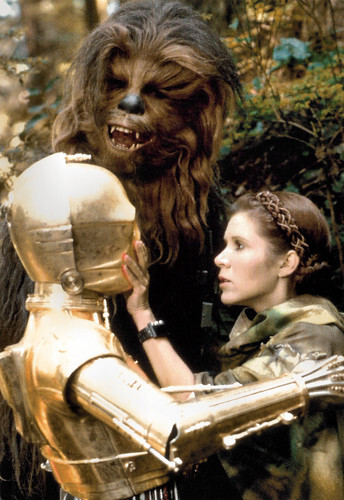
American postcard by Classico San Francisco, no. 105-531. Photo: Lucasfilm Ltd. Anthony Daniels as C3-PO, Peter Mayhew as Chewbacca and Carrie Fisher as Princess Leia in Star Wars: Episode VI - Return of the Jedi (George Lucas, 1983).
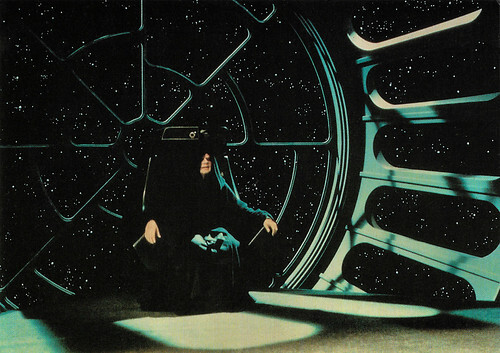
German postcard by Filmwelt Berlin, Bad Münder, no. SW 6.029. Photo: Lucasfilm Ltd. Ian McDiarmid as The Emperor in Star Wars: Episode VI - Return of the Jedi (Richard Marquand, 1983).
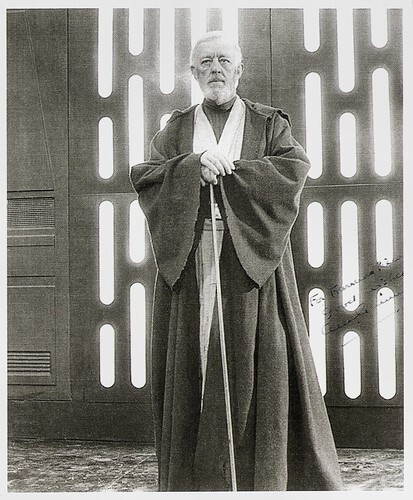
British autograph card. Photo: Alec Guinness in Star Wars (George Lucas, 1977).
Sources: Luke A. McGowan (IMDb), Derek Armstrong (AllMovie), Wikipedia and IMDb.

French postcard by Studio Erving, Paris, no. 696. Photo: Lucasfilm Ltd. Harrison Ford as Han Solo in Star Wars: Episode IV - A New Hope (George Lucas, 1977).

American postcard by Classico San Francisco, no. 105-519. Photo: Lucasfilm Ltd. Carrie Fisher as Princess Leia in Star Wars: Episode IV - A New Hope (George Lucas, 1977).

American postcard by Classico San Francisco, no. 105-062. Photo: Lucasfilm Ltd. Anthony Daniels as C-3PO and Kenny Baker as R2-D2 in Star Wars: Episode IV - A New Hope (George Lucas, 1977).
The Empire Strikes Back (1980)
Three years have passed since Star Wars: Episode IV - A New Hope (George Lucas, 1977). In Star Wars Episode V - The Empire Strikes Back (Irvin Kershner, 1980), Luke Skywalker (Mark Hamill) and Han Solo ( Harrison Ford ) are now officially members of the Rebels, holed up on the ice planet Hoth.
However, Han is wanted en masse by bounty hunters because of his debt to Jabba the Hutt. Moreover, the Galactic Empire is bent on revenge after the destruction of the Death Star and has launched a massive search for the rebels.
On Hoth, Luke is attacked by a wampa. The latter takes the unconscious Luke to an ice cave, where Luke (having woken up again) cuts off the wampa's arm with his lightsaber and flees outside. At the Rebel Alliance on the same planet, Han notices that Luke is not coming back, and goes looking for him.
While Han is on a quest, Luke sees the ghost of his old teacher Obi-Wan Kenobi (Alec McGuinness). The latter tells him to go to the planet Dagobah to look for Yoda, the last surviving Jedi master. He can train Luke further. Then Obi-Wan's ghost disappears and Han arrives. Luke and Han are rescued by a snow speeder, which takes them back to the Rebel Alliance.
The Rebels face an attack by the Imperial forces and its AT-AT walkers and they are brutally overpowered by the Empire. While Han Solo, Chewbacca (Peter Mayhew), Princess Leia (Carrie Fisher) and C-3PO (Anthony Daniels) escape in the damaged Millennium Falcon. Luke Skywalker travels with R2-D2 (Kenny Baker) to Dagobah in search of Yoda (voice of Frank Oz).
Only with the Jedi Master's help will Luke survive when the Dark Side of the Force beckons him into the ultimate duel with Darth Vader. Luke begins Jedi training with Yoda, while his friends are pursued across the galaxy by Darth Vader (David Prowse and the voice of James Earl Jones) and bounty hunter Boba Fett (Jeremy Bulloch).

Spanish postcard by Memory Card, no. 131. Photo: Lucasfilm LTD. Poster for Star Wars: Episode V - The Empire Strikes Back (Irvin Kershner, 1980).

Vintage postcard, no. 606. Photo: Lucasfilm LTD. Poster for Star Wars: Episode V - The Empire Strikes Back (Irvin Kershner, 1980).

Belgian postcard by Mobistar no. 131. Photo: Lucasfilm LTD., 2000. Poster for Star Wars: Episode V - The Empire Strikes Back (Irvin Kershner, 1980).
A risky move which would later pay off several times over
George Lucas had originally planned to only executive produce and finance Star Wars Episode V - The Empire Strikes Back (1980), leaving the directorial duties in the hands of Irvin Kershner and day-to-day producing duties to Gary Kurtz. Directing Star Wars (1977) had left Lucas exhausted and sick, and he had intended to take time off to start to focus on the expansion of the Lucasfilm company and spending more time with his then-wife Marcia Lucas so that they could start a family and finish construction on Skywalker Ranch.
In order to avoid sharing creative rights, George Lucas decided to avoid using a major studio to finance Star Wars Episode V - The Empire Strikes Back (Irvin Kershner, 1980). Instead, he bankrolled the $18 million production himself, using a combination of his profits from Star Wars (George Lucas, 1977) and a bank loan.
Although the move was risky, it would later pay off several times over. However, when production on The Empire Strikes Back (1980) ran over budget and behind schedule, Lucas had to step in and take a more hands-on role, going on location to oversee filming and even directing portions of the film. A disastrous rough cut of the film proved to be incoherent during screenings, and facing the possibility of financial ruin, Lucas then re-edited the film himself with even worse results.
Extensive re-shoots and further post-production effects work put enormous strain on his health, his marriage, and his relationships with Kershner and Kurtz. To preserve the dramatic opening of the Star Wars films, George Lucas insisted on moving all the credits to the end of the film. However, although the Writers' Guild and Directors' Guild had begrudgingly allowed this on Star Wars (1977) because that film wasn't expected to be very successful, they resented the trend being continued on the sequel.
First, they tried to pull the film from release but were unsuccessful. They then fined Lucas heavily and tried to fine Irvin Kershner, but Lucas paid all of the fines himself (nearly $250,000). Lucas then bitterly dropped his membership in the Writers' Guild, Directors' Guild, and the Motion Picture Association of America, a move that has hindered his hiring choices for later films.

American collectors card by Topps Widevision, no. 4. Photo: Lucasfilm LTD. Mark Hamill as Luke Skywalker in Star Wars: Episode V - The Empire Strikes Back (Irvin Kershner, 1980). Caption: Ext. Plain of Hoth - Pulling off his protective goggles, Luke Skywalker notices something in the sky. He takes a pair of electrobinoculars from his utility belt and through them sees smoke rising from where the probe droid has crashed. The wind whips at Luke's fur-lined cap as he activates a comlink transmitter.

American collectors card by Topps Widevision, no. 24. Photo: Lucasfilm LTD. The AT-AT walkers in Star Wars: Episode V - The Empire Strikes Back (Irvin Kershner, 1980). Caption: Ext. Hoth - Ice plain - Battlefield. The battle on Hoth continues to rage. A giant At-At head swivels and figures, striking a snowspeeder and sending it crashing in a ball of flames. Elsewhere, Rebel troops in the snow french fire on the approaching walkers, as snow and ice explode all around them.

American collectors card by Topps Widevision, no. 68. Photo: Lucasfilm LTD. Yoda (with the voice of Frank Oz) in Star Wars: Episode V - The Empire Strikes Back (Irvin Kershner, 1980). Caption: Ext. Dagobah. Yoda turns to see a huge dead, black tree, its base surrounded by a few feet of water. Giant, twisted roots form a dark and sinister cave on one side. Luke stares at the tree, trembling. "What's in there?" he asks Yoda. "Only what you take with you." Yoda answers.
One of the most expensive films of its day
A new character in Star Wars Episode V - The Empire Strikes Back (1980) was Yoda, originally designed by British make-up artist Stuart Freeborn and voiced by Frank Oz. In the original Star Wars trilogy, he is realised as a puppet, controlled by Oz. The Dagobah set needed to be elevated to give Frank Oz and three other puppeteers room to control the Yoda puppet from below.
For proper interaction, Mark Hamill was given an earpiece so he could hear Oz doing Yoda's voice. On numerous occasions, director Irvin Kershner would give a direction to Yoda by mistake, and Oz would have to remind him who to speak to.
Harrison Ford wanted Han Solo to die at the end of this second film, and he did not want to play the character again. When Star Wars (1977) was made, Carrie Fisher and Mark Hamill were signed for a three-movie deal, but Ford refused since the character had played his part already in the second film.
Instead of killing off the character, George Lucas had a different idea. He opted for Han to be frozen in carbonite, in case Ford had a change of heart and agreed to return in the third film, the character would be revived. And yes, Han Solo still had a heroic part to play in Star Wars: Episode VI - Return of the Jedi (Richard Marquand, 1983).
Lucas recovered his investment within three months of the release of Star Wars Episode V - The Empire Strikes Back (1980). After the various increases in budget, the film became one of the most expensive of its day and after the bank threatened to pull his loan, George Lucas was forced to approach Twentieth Century Fox. Lucas made a deal with the studio to secure the loan in exchange for paying the studio more money but without the loss of his sequel and merchandising rights.
After the film's box-office success, unhappiness at the studio over the deal's generosity to Lucas caused studio president Alan Ladd, Jr. to quit. Lucas, however, showed gratitude far beyond the Hollywood norm by sharing the profits with his employees (nearly $5 million in bonuses). Though the film proved to be an enormous commercial and critical success, George Lucas would never work with Gary Kurtz again, and his marriage with Marcia Lucas dissolved a couple of years later.

American collectors card by Topps Widevision, no. 78. Photo: Lucasfilm LTD. Yoda (with the voice of Frank Oz) in Star Wars: Episode V - The Empire Strikes Back (Irvin Kershner, 1980). Caption: Ext. Dagobah - Bog. Luke is unable to raise his ship from the bog with his levitation skills. Quietly, Yoda turns towards the sunken x-wing fighter. With his eyes closed, he raises his arm and points at the ship. Soon the fighter rises above the water and moves forward as Artoo beeps in terror and scoots away.

American collectors card by Topps Widevision, no. 106. Photo: Lucasfilm LTD. Billie Dee Williams as Lando in Star Wars Episode: V - The Empire Strikes Back (Irvin Kershner, 1980). Caption: Int. Cloud City - Carbon-freezing chamber. A huge, mechanical tong lifts the steaming, metal-encased Han Solo out of the carbon vat and stands him on the platform. Some Ugnaughts rush over and push the block over onto the platform. They then attach an electric box onto the structure and step away. Lando kneels and adjusts some knobs, measuring the heat. Seeing Han is still alive, Lando shakes his head in relief.

German postcard by Filmwelt Berlin, Bad Münder, no. SW 5.049. Image: Lucasfilm. Publicity still for Star Wars: Episode V - The Empire Strikes Back (Irvin Kershner, 1980).
Star Wars Episode VI - Return of the Jedi (1983)
A long time ago, in a galaxy far, far away..... Star Wars Episode VI - Return of the Jedi (1983) takes place a year after Han Solo has been frozen in carbonite to be transported to crime lord Jabba the Hutt, a large slug-like alien, for a bounty.
Luke Skywalker heads to Dagobah to finish his training with Yoda; however, the Jedi is dying and he confirms that Darth Vader (David Prowse) is his father. Obi-Wan Kenobi's Force spirit later tells Luke that Leia is his twin sister and that he must face Vader again to finish his training and defeat the Empire.
C-3PO and R2-D2 are sent to crime lord Jabba's palace in the desert world of Tatooine in a trade bargain made by Luke Skywalker to rescue Han, who is still frozen. Disguised as the bounty hunter Boushh, Princess Leia sneaks into the palace under the pretence of collecting the bounty on Chewbacca and unfreezes Han but is caught by Jabba and chained to him as his slave.
Luke shows up and after many adventures and fights, Leia strangles Jabba to death with her slave chains and is freed by Luke. Meanwhile, the rebels discover that the Empire is building a new Death Star more powerful than the first one that is protected by an energy shield generated by a generator on planet Endor.
Han Solo and Princess Leia reaffirm their love, and team with Chewbacca, the Ewoks, and droids C-3PO and R2-D2 to aid in the disruption of the Dark Side, and the defeat of the evil emperor. The Rebel Fleet led by Lando Calrissian battles with the Imperial Fleet while they wait for the shields to go down. Luke has a final showdown with Darth Vader. He struggles to help dis father back from the dark side without falling into the Emperor's trap.

Vintage postcard. Image: Lucasfilm. Mark Hamill and David Prowse in Star Wars: Episode V - The Empire Strikes Back (Irvin Kershner, 1980).

Vintage postcard. Image: Lucasfilm. Publicity still for Star Wars: Episode V - The Empire Strikes Back (Irvin Kershner, 1980).

West-German postcard by Filmwelt Berlin, Bad Gmünder, no. SW 5.038. Image: Lucasfilm. Publicity still for Star Wars: Episode V - The Empire Strikes Back (Irvin Kershner, 1980).
Priority on story or spectacle?
Star Wars Episode VI - Return of the Jedi (Richard Marquand, 1983) is action-packed with a tremendous triple battle at the end. The final lightsaber battle between Vader and Luke is breathtaking. The beautiful ending of the film brings everything together.
Still, the film was generally seen as a step down from its two predecessors. The comic and romantic elements weren't as developed. The furry Ewoks are a bit too cute. In other scenes, the film seems to take itself too seriously.
Luke A. McGowan at IMDb : "It is full of holes, tonal inconsistencies and plot implausibilities. I'd chalk this up to Richard Marquand not being half as competent as Irvin Kershner, and the departure of Gary Kurtz from the project. Kurtz reportedly left because he and Lucas couldn't agree on whether story or spectacle should take priority."
Derek Armstrong at AllMovie : "Overrun by furry Ewoks, the sixth episode in the planned nine-part story represented George Lucas' turn toward kiddie sensibilities, which he would continue in force with the much-reviled Jar Jar Binks character in Star Wars, Episode I: The Phantom Menace. Still, with C3PO constantly getting himself into slapstick jams that inspired endless doomsday whining, the saga had always included silly bursts of comic relief, and the Ewoks only furthered that trend."
However, the plot of Return of the Jedi is still fast-paced and sophisticated and the film is still enormously entertaining, thanks to the elaborate set pieces and the well-choreographed battles. And John Williams's music remains a brilliant and innovative film score.

American postcard by Classico San Francisco, no. 105-531. Photo: Lucasfilm Ltd. Anthony Daniels as C3-PO, Peter Mayhew as Chewbacca and Carrie Fisher as Princess Leia in Star Wars: Episode VI - Return of the Jedi (George Lucas, 1983).

German postcard by Filmwelt Berlin, Bad Münder, no. SW 6.029. Photo: Lucasfilm Ltd. Ian McDiarmid as The Emperor in Star Wars: Episode VI - Return of the Jedi (Richard Marquand, 1983).

British autograph card. Photo: Alec Guinness in Star Wars (George Lucas, 1977).
Sources: Luke A. McGowan (IMDb), Derek Armstrong (AllMovie), Wikipedia and IMDb.
Published on December 24, 2022 22:00
Star Wars Episode V - The Empire Strikes Back (1980) and Star Wars Episode VI - Return of the Jedi (1983)
In Star Wars Episode V - The Empire Strikes Back (Irvin Kershner, 1980), the adventure continues that started in Star Wars: Episode IV - A New Hope (George Lucas, 1977). It is the fifth, but second made, instalment in the Star Wars series. The screenplay was written by Leigh Brackett and Lawrence Kasdan. Star Wars Episode VI - Return of the Jedi (Richard Marquand, 1983) is the flawed, epic conclusion to the original Star Wars trilogy. The screenplay is by Lawrence Kasdan and George Lucas from a story by Lucas, who was also the executive producer. The film grossed $374 million during its initial theatrical run, becoming the highest-grossing film of 1983. Overall, the film was well-received by critics, but Return of the Jedi is widely considered to be the weakest film in the original trilogy.

French postcard by Studio Erving, Paris, no. 696. Photo: Lucasfilm Ltd. Harrison Ford as Han Solo in Star Wars - Episode IV - A New Hope (George Lucas, 1977).

American postcard by Classico San Francisco, no. 105-519. Photo: Lucasfilm Ltd. Carrie Fisher as Princess Leia in Star Wars: Episode IV - A New Hope (George Lucas, 1977).

American postcard by Classico San Francisco, no. 105-062. Photo: Lucasfilm Ltd. Anthony Daniels as C-3PO and Kenny Baker as R2-D2 in Star Wars: Episode IV - A New Hope (George Lucas, 1977).
The Empire Strikes Back (1980)
Three years have passed since Star Wars: Episode IV - A New Hope (George Lucas, 1977). In Star Wars Episode V - The Empire Strikes Back (Irvin Kershner, 1980), Luke Skywalker (Mark Hamill) and Han Solo ( Harrison Ford ) are now officially members of the Rebels, holed up on the ice planet Hoth.
However, Han is wanted en masse by bounty hunters because of his debt to Jabba the Hutt. Moreover, the Galactic Empire is bent on revenge after the destruction of the Death Star and has launched a massive search for the rebels.
On Hoth, Luke is attacked by a wampa. The latter takes the unconscious Luke to an ice cave, where Luke (having woken up again) cuts off the wampa's arm with his lightsaber and flees outside. At the Rebel Alliance on the same planet, Han notices that Luke is not coming back, and goes looking for him.
While Han is on a quest, Luke sees the ghost of his old teacher Obi-Wan Kenobi (Alec McGuinness). The latter tells him to go to the planet Dagobah to look for Yoda, the last surviving Jedi master. He can train Luke further. Then Obi-Wan's ghost disappears and Han arrives. Luke and Han are rescued by a snow speeder, which takes them back to the Rebel Alliance.
The Rebels face an attack by the Imperial forces and its AT-AT walkers and they are brutally overpowered by the Empire. While Han Solo, Chewbacca (Peter Mayhew), Princess Leia (Carrie Fisher) and C-3PO (Anthony Daniels) escape in the damaged Millennium Falcon. Luke Skywalker travels with R2-D2 (Kenny Baker) to Dagobah in search of Yoda (voice of Frank Oz).
Only with the Jedi Master's help will Luke survive when the Dark Side of the Force beckons him into the ultimate duel with Darth Vader. Luke begins Jedi training with Yoda, while his friends are pursued across the galaxy by Darth Vader (David Prowse and the voice of James Earl Jones) and bounty hunter Boba Fett (Jeremy Bulloch).

Spanish postcard by Memory Card, no. 131. Photo: Lucasfilm LTD. Poster for Star Wars Episode V - The Empire Strikes Back (Irvin Kershner, 1980).

Vintage postcard, no. 606. Photo: Lucasfilm LTD. Poster for Star Wars Episode V - The Empire Strikes Back (Irvin Kershner, 1980).

Belgian postcard by Mobistar no. 131. Photo: Lucasfilm LTD., 2000. Poster for Star Wars Episode V - The Empire Strikes Back (Irvin Kershner, 1980).
A risky move which would later pay off several times over
George Lucas had originally planned to only executive produce and finance Star Wars Episode V - The Empire Strikes Back (1980), leaving the directorial duties in the hands of Irvin Kershner and day-to-day producing duties to Gary Kurtz. Directing Star Wars (1977) had left Lucas exhausted and sick, and he had intended to take time off to start to focus on the expansion of the Lucasfilm company and spending more time with his then-wife Marcia Lucas so that they could start a family and finish construction on Skywalker Ranch.
In order to avoid sharing creative rights, George Lucas decided to avoid using a major studio to finance Star Wars Episode V - The Empire Strikes Back (Irvin Kershner, 1980). Instead, he bankrolled the $18 million production himself, using a combination of his profits from Star Wars (George Lucas, 1977) and a bank loan.
Although the move was risky, it would later pay off several times over. However, when production on The Empire Strikes Back (1980) ran over budget and behind schedule, Lucas had to step in and take a more hands-on role, going on location to oversee filming and even directing portions of the film. A disastrous rough cut of the film proved to be incoherent during screenings, and facing the possibility of financial ruin, Lucas then re-edited the film himself with even worse results.
Extensive re-shoots and further post-production effects work put enormous strain on his health, his marriage, and his relationships with Kershner and Kurtz. To preserve the dramatic opening of the Star Wars films, George Lucas insisted on moving all the credits to the end of the film. However, although the Writers' Guild and Directors' Guild had begrudgingly allowed this on Star Wars (1977) because that film wasn't expected to be very successful, they resented the trend being continued on the sequel.
First, they tried to pull the film from release but were unsuccessful. They then fined Lucas heavily and tried to fine Irvin Kershner, but Lucas paid all of the fines himself (nearly $250,000). Lucas then bitterly dropped his membership in the Writers' Guild, Directors' Guild, and the Motion Picture Association of America, a move that has hindered his hiring choices for later films.

American collectors card by Topps Widevision, no. 4. Photo: Lucasfilm LTD. Mark Hamill as Luke Skywalker in Star Wars Episode V - The Empire Strikes Back (Irvin Kershner, 1980). Caption: Ext. Plain of Hoth - Pulling off his protective goggles, Luke Skywalker notices something in the sky. He takes a pair of electrobinoculars from his utility belt and through them sees smoke rising from where the probe droid has crashed. The wind whips at Luke's fur-lined cap as he activates a comlink transmitter.

American collectors card by Topps Widevision, no. 24. Photo: Lucasfilm LTD. The AT-AT walkers in Star Wars Episode V - The Empire Strikes Back (Irvin Kershner, 1980). Caption: Ext. Hoth - Ice plain - Battlefield. The battle on Hoth continues to rage. A giant At-At head swivels and figures, striking a snowspeeder and sending it crashing in a ball of flames. Elsewhere, Rebel troops in the snow french fire on the approaching walkers, as snow and ice explode all around them.

American collectors card by Topps Widevision, no. 68. Photo: Lucasfilm LTD. Yoda (with the voice of Frank Oz) in Star Wars Episode V - The Empire Strikes Back (Irvin Kershner, 1980). Caption: Ext. Dagobah. Yoda turns to see a huge dead, black tree, its base surrounded by a few feet of water. Giant, twisted roots form a dark and sinister cave on one side. Luke stares at the tree, trembling. "What's in there?" he asks Yoda. "Only what you take with you." Yoda answers.
One of the most expensive films of its day
A new character in Star Wars Episode V - The Empire Strikes Back (1980) was Yoda, originally designed by British make-up artist Stuart Freeborn and voiced by Frank Oz. In the original Star Wars trilogy, he is realised as a puppet, controlled by Oz. The Dagobah set needed to be elevated to give Frank Oz and three other puppeteers room to control the Yoda puppet from below.
For proper interaction, Mark Hamill was given an earpiece so he could hear Oz doing Yoda's voice. On numerous occasions, director Irvin Kershner would give a direction to Yoda by mistake, and Oz would have to remind him who to speak to.
Harrison Ford wanted Han Solo to die at the end of this second film, and he did not want to play the character again. When Star Wars (1977) was made, Carrie Fisher and Mark Hamill were signed for a three-movie deal, but Ford refused since the character had played his part already in the second film.
Instead of killing off the character, George Lucas had a different idea. He opted for Han to be frozen in carbonite, in case Ford had a change of heart and agreed to return in the third film, the character would be revived. And yes, Han Solo still had a heroic part to play in Star Wars: Episode VI - Return of the Jedi (Richard Marquand, 1983).
Lucas recovered his investment within three months of the release of Star Wars Episode V - The Empire Strikes Back (1980). After the various increases in budget, the film became one of the most expensive of its day and after the bank threatened to pull his loan, George Lucas was forced to approach Twentieth Century Fox. Lucas made a deal with the studio to secure the loan in exchange for paying the studio more money but without the loss of his sequel and merchandising rights.
After the film's box-office success, unhappiness at the studio over the deal's generosity to Lucas caused studio president Alan Ladd, Jr. to quit. Lucas, however, showed gratitude far beyond the Hollywood norm by sharing the profits with his employees (nearly $5 million in bonuses). Though the film proved to be an enormous commercial and critical success, George Lucas would never work with Gary Kurtz again, and his marriage with Marcia Lucas dissolved a couple of years later.

American collectors card by Topps Widevision, no. 78. Photo: Lucasfilm LTD. Yoda (with the voice of Frank Oz) in Star Wars Episode V - The Empire Strikes Back (Irvin Kershner, 1980). Caption: Ext. Dagobah - Bog. Luke is unable to raise his ship from the bog with his levitation skills. Quietly, Yoda turns towards the sunken x-wing fighter. With his eyes closed, he raises his arm and points at the ship. Soon the fighter rises above the water and moves forward as Artoo beeps in terror and scoots away.

American collectors card by Topps Widevision, no. 106. Photo: Lucasfilm LTD. Billie Dee Williams as Lando in Star Wars Episode V - The Empire Strikes Back (Irvin Kershner, 1980). Caption: Int. Cloud City - Carbon-freezing chamber. A huge, mechanical tong lifts the steaming, metal-encased Han Solo out of the carbon vat and stands him on the platform. Some Ugnaughts rush over and push the block over onto the platform. They then attach an electric box onto the structure and step away. Lando kneels and adjusts some knobs, measuring the heat. Seeing Han is still alive, Lando shakes his head in relief.

German postcard by Filmwelt Berlin, Bad Münder, no. SW 5.049. Image: Lucasfilm. Publicity still for Star Wars Episode V - The Empire Strikes Back (Irvin Kershner, 1980).
Star Wars Episode VI - Return of the Jedi (1983)
A long time ago, in a galaxy far, far away..... Star Wars Episode VI - Return of the Jedi (1983) takes place a year after Han Solo has been frozen in carbonite to be transported to crime lord Jabba the Hutt, a large slug-like alien, for a bounty.
Luke Skywalker heads to Dagobah to finish his training with Yoda; however, the Jedi is dying and he confirms that Darth Vader (David Prowse) is his father. Obi-Wan Kenobi's Force spirit later tells Luke that Leia is his twin sister and that he must face Vader again to finish his training and defeat the Empire.
C-3PO and R2-D2 are sent to crime lord Jabba's palace in the desert world of Tatooine in a trade bargain made by Luke Skywalker to rescue Han, who is still frozen. Disguised as the bounty hunter Boushh, Princess Leia sneaks into the palace under the pretence of collecting the bounty on Chewbacca and unfreezes Han but is caught by Jabba and chained to him as his slave.
Luke shows up and after many adventures and fights, Leia strangles Jabba to death with her slave chains and is freed by Luke. Meanwhile, the rebels discover that the Empire is building a new Death Star more powerful than the first one that is protected by an energy shield generated by a generator on planet Endor.
Han Solo and Princess Leia reaffirm their love, and team with Chewbacca, the Ewoks, and droids C-3PO and R2-D2 to aid in the disruption of the Dark Side, and the defeat of the evil emperor. The Rebel Fleet led by Lando Calrissian battles with the Imperial Fleet while they wait for the shields to go down. Luke has a final showdown with Darth Vader. He struggles to help dis father back from the dark side without falling into the Emperor's trap.

Vintage postcard. Image: Lucasfilm. Mark Hamill and David Prowse in Star Wars Episode V - The Empire Strikes Back (Irvin Kershner, 1980).

Vintage postcard. Image: Lucasfilm. Publicity still for Star Wars Episode V - The Empire Strikes Back (Irvin Kershner, 1980).

West-German postcard by Filmwelt Berlin, Bad Gmünder, no. SW 5.038. Image: Lucasfilm. Publicity still for Star Wars Episode V - The Empire Strikes Back (Irvin Kershner, 1980).
Priority on story or spectacle?
Star Wars Episode VI - Return of the Jedi (Richard Marquand, 1983) is action-packed with a tremendous triple battle at the end. The final lightsaber battle between Vader and Luke is breathtaking. The beautiful ending of the film brings everything together.
Still, the film was generally seen as a step down from its two predecessors. The comic and romantic elements weren't as developed. The furry Ewoks are a bit too cute. In other scenes, the film seems to take itself too seriously.
Luke A. McGowan at IMDb : "It is full of holes, tonal inconsistencies and plot implausibilities. I'd chalk this up to Richard Marquand not being half as competent as Irvin Kershner, and the departure of Gary Kurtz from the project. Kurtz reportedly left because he and Lucas couldn't agree on whether story or spectacle should take priority."
Derek Armstrong at AllMovie : "Overrun by furry Ewoks, the sixth episode in the planned nine-part story represented George Lucas' turn toward kiddie sensibilities, which he would continue in force with the much-reviled Jar Jar Binks character in Star Wars, Episode I: The Phantom Menace. Still, with C3PO constantly getting himself into slapstick jams that inspired endless doomsday whining, the saga had always included silly bursts of comic relief, and the Ewoks only furthered that trend."
However, the plot of Return of the Jedi is still fast-paced and sophisticated and the film is still enormously entertaining, thanks to the elaborate set pieces and the well-choreographed battles. And John Williams's music remains a brilliant and innovative film score.

American postcard by Classico San Francisco, no. 105-531. Photo: Lucasfilm Ltd. Anthony Daniels as C3-PO, Peter Mayhew as Chewbacca and Carrie Fisher as Princess Leia in Star Wars Episode VI - Return of the Jedi (George Lucas, 1983).

German postcard by Filmwelt Berlin, Bad Münder, no. SW 6.029. Photo: Lucasfilm Ltd. Ian McDiarmid as The Emperor in Star Wars Episode VI - Return of the Jedi (Richard Marquand, 1983).

British autograph card. Photo: Alec Guinness in Star Wars (George Lucas, 1977).
Sources: Luke A. McGowan (IMDb), Derek Armstrong (AllMovie), Wikipedia and IMDb.

French postcard by Studio Erving, Paris, no. 696. Photo: Lucasfilm Ltd. Harrison Ford as Han Solo in Star Wars - Episode IV - A New Hope (George Lucas, 1977).

American postcard by Classico San Francisco, no. 105-519. Photo: Lucasfilm Ltd. Carrie Fisher as Princess Leia in Star Wars: Episode IV - A New Hope (George Lucas, 1977).

American postcard by Classico San Francisco, no. 105-062. Photo: Lucasfilm Ltd. Anthony Daniels as C-3PO and Kenny Baker as R2-D2 in Star Wars: Episode IV - A New Hope (George Lucas, 1977).
The Empire Strikes Back (1980)
Three years have passed since Star Wars: Episode IV - A New Hope (George Lucas, 1977). In Star Wars Episode V - The Empire Strikes Back (Irvin Kershner, 1980), Luke Skywalker (Mark Hamill) and Han Solo ( Harrison Ford ) are now officially members of the Rebels, holed up on the ice planet Hoth.
However, Han is wanted en masse by bounty hunters because of his debt to Jabba the Hutt. Moreover, the Galactic Empire is bent on revenge after the destruction of the Death Star and has launched a massive search for the rebels.
On Hoth, Luke is attacked by a wampa. The latter takes the unconscious Luke to an ice cave, where Luke (having woken up again) cuts off the wampa's arm with his lightsaber and flees outside. At the Rebel Alliance on the same planet, Han notices that Luke is not coming back, and goes looking for him.
While Han is on a quest, Luke sees the ghost of his old teacher Obi-Wan Kenobi (Alec McGuinness). The latter tells him to go to the planet Dagobah to look for Yoda, the last surviving Jedi master. He can train Luke further. Then Obi-Wan's ghost disappears and Han arrives. Luke and Han are rescued by a snow speeder, which takes them back to the Rebel Alliance.
The Rebels face an attack by the Imperial forces and its AT-AT walkers and they are brutally overpowered by the Empire. While Han Solo, Chewbacca (Peter Mayhew), Princess Leia (Carrie Fisher) and C-3PO (Anthony Daniels) escape in the damaged Millennium Falcon. Luke Skywalker travels with R2-D2 (Kenny Baker) to Dagobah in search of Yoda (voice of Frank Oz).
Only with the Jedi Master's help will Luke survive when the Dark Side of the Force beckons him into the ultimate duel with Darth Vader. Luke begins Jedi training with Yoda, while his friends are pursued across the galaxy by Darth Vader (David Prowse and the voice of James Earl Jones) and bounty hunter Boba Fett (Jeremy Bulloch).

Spanish postcard by Memory Card, no. 131. Photo: Lucasfilm LTD. Poster for Star Wars Episode V - The Empire Strikes Back (Irvin Kershner, 1980).

Vintage postcard, no. 606. Photo: Lucasfilm LTD. Poster for Star Wars Episode V - The Empire Strikes Back (Irvin Kershner, 1980).

Belgian postcard by Mobistar no. 131. Photo: Lucasfilm LTD., 2000. Poster for Star Wars Episode V - The Empire Strikes Back (Irvin Kershner, 1980).
A risky move which would later pay off several times over
George Lucas had originally planned to only executive produce and finance Star Wars Episode V - The Empire Strikes Back (1980), leaving the directorial duties in the hands of Irvin Kershner and day-to-day producing duties to Gary Kurtz. Directing Star Wars (1977) had left Lucas exhausted and sick, and he had intended to take time off to start to focus on the expansion of the Lucasfilm company and spending more time with his then-wife Marcia Lucas so that they could start a family and finish construction on Skywalker Ranch.
In order to avoid sharing creative rights, George Lucas decided to avoid using a major studio to finance Star Wars Episode V - The Empire Strikes Back (Irvin Kershner, 1980). Instead, he bankrolled the $18 million production himself, using a combination of his profits from Star Wars (George Lucas, 1977) and a bank loan.
Although the move was risky, it would later pay off several times over. However, when production on The Empire Strikes Back (1980) ran over budget and behind schedule, Lucas had to step in and take a more hands-on role, going on location to oversee filming and even directing portions of the film. A disastrous rough cut of the film proved to be incoherent during screenings, and facing the possibility of financial ruin, Lucas then re-edited the film himself with even worse results.
Extensive re-shoots and further post-production effects work put enormous strain on his health, his marriage, and his relationships with Kershner and Kurtz. To preserve the dramatic opening of the Star Wars films, George Lucas insisted on moving all the credits to the end of the film. However, although the Writers' Guild and Directors' Guild had begrudgingly allowed this on Star Wars (1977) because that film wasn't expected to be very successful, they resented the trend being continued on the sequel.
First, they tried to pull the film from release but were unsuccessful. They then fined Lucas heavily and tried to fine Irvin Kershner, but Lucas paid all of the fines himself (nearly $250,000). Lucas then bitterly dropped his membership in the Writers' Guild, Directors' Guild, and the Motion Picture Association of America, a move that has hindered his hiring choices for later films.

American collectors card by Topps Widevision, no. 4. Photo: Lucasfilm LTD. Mark Hamill as Luke Skywalker in Star Wars Episode V - The Empire Strikes Back (Irvin Kershner, 1980). Caption: Ext. Plain of Hoth - Pulling off his protective goggles, Luke Skywalker notices something in the sky. He takes a pair of electrobinoculars from his utility belt and through them sees smoke rising from where the probe droid has crashed. The wind whips at Luke's fur-lined cap as he activates a comlink transmitter.

American collectors card by Topps Widevision, no. 24. Photo: Lucasfilm LTD. The AT-AT walkers in Star Wars Episode V - The Empire Strikes Back (Irvin Kershner, 1980). Caption: Ext. Hoth - Ice plain - Battlefield. The battle on Hoth continues to rage. A giant At-At head swivels and figures, striking a snowspeeder and sending it crashing in a ball of flames. Elsewhere, Rebel troops in the snow french fire on the approaching walkers, as snow and ice explode all around them.

American collectors card by Topps Widevision, no. 68. Photo: Lucasfilm LTD. Yoda (with the voice of Frank Oz) in Star Wars Episode V - The Empire Strikes Back (Irvin Kershner, 1980). Caption: Ext. Dagobah. Yoda turns to see a huge dead, black tree, its base surrounded by a few feet of water. Giant, twisted roots form a dark and sinister cave on one side. Luke stares at the tree, trembling. "What's in there?" he asks Yoda. "Only what you take with you." Yoda answers.
One of the most expensive films of its day
A new character in Star Wars Episode V - The Empire Strikes Back (1980) was Yoda, originally designed by British make-up artist Stuart Freeborn and voiced by Frank Oz. In the original Star Wars trilogy, he is realised as a puppet, controlled by Oz. The Dagobah set needed to be elevated to give Frank Oz and three other puppeteers room to control the Yoda puppet from below.
For proper interaction, Mark Hamill was given an earpiece so he could hear Oz doing Yoda's voice. On numerous occasions, director Irvin Kershner would give a direction to Yoda by mistake, and Oz would have to remind him who to speak to.
Harrison Ford wanted Han Solo to die at the end of this second film, and he did not want to play the character again. When Star Wars (1977) was made, Carrie Fisher and Mark Hamill were signed for a three-movie deal, but Ford refused since the character had played his part already in the second film.
Instead of killing off the character, George Lucas had a different idea. He opted for Han to be frozen in carbonite, in case Ford had a change of heart and agreed to return in the third film, the character would be revived. And yes, Han Solo still had a heroic part to play in Star Wars: Episode VI - Return of the Jedi (Richard Marquand, 1983).
Lucas recovered his investment within three months of the release of Star Wars Episode V - The Empire Strikes Back (1980). After the various increases in budget, the film became one of the most expensive of its day and after the bank threatened to pull his loan, George Lucas was forced to approach Twentieth Century Fox. Lucas made a deal with the studio to secure the loan in exchange for paying the studio more money but without the loss of his sequel and merchandising rights.
After the film's box-office success, unhappiness at the studio over the deal's generosity to Lucas caused studio president Alan Ladd, Jr. to quit. Lucas, however, showed gratitude far beyond the Hollywood norm by sharing the profits with his employees (nearly $5 million in bonuses). Though the film proved to be an enormous commercial and critical success, George Lucas would never work with Gary Kurtz again, and his marriage with Marcia Lucas dissolved a couple of years later.

American collectors card by Topps Widevision, no. 78. Photo: Lucasfilm LTD. Yoda (with the voice of Frank Oz) in Star Wars Episode V - The Empire Strikes Back (Irvin Kershner, 1980). Caption: Ext. Dagobah - Bog. Luke is unable to raise his ship from the bog with his levitation skills. Quietly, Yoda turns towards the sunken x-wing fighter. With his eyes closed, he raises his arm and points at the ship. Soon the fighter rises above the water and moves forward as Artoo beeps in terror and scoots away.

American collectors card by Topps Widevision, no. 106. Photo: Lucasfilm LTD. Billie Dee Williams as Lando in Star Wars Episode V - The Empire Strikes Back (Irvin Kershner, 1980). Caption: Int. Cloud City - Carbon-freezing chamber. A huge, mechanical tong lifts the steaming, metal-encased Han Solo out of the carbon vat and stands him on the platform. Some Ugnaughts rush over and push the block over onto the platform. They then attach an electric box onto the structure and step away. Lando kneels and adjusts some knobs, measuring the heat. Seeing Han is still alive, Lando shakes his head in relief.

German postcard by Filmwelt Berlin, Bad Münder, no. SW 5.049. Image: Lucasfilm. Publicity still for Star Wars Episode V - The Empire Strikes Back (Irvin Kershner, 1980).
Star Wars Episode VI - Return of the Jedi (1983)
A long time ago, in a galaxy far, far away..... Star Wars Episode VI - Return of the Jedi (1983) takes place a year after Han Solo has been frozen in carbonite to be transported to crime lord Jabba the Hutt, a large slug-like alien, for a bounty.
Luke Skywalker heads to Dagobah to finish his training with Yoda; however, the Jedi is dying and he confirms that Darth Vader (David Prowse) is his father. Obi-Wan Kenobi's Force spirit later tells Luke that Leia is his twin sister and that he must face Vader again to finish his training and defeat the Empire.
C-3PO and R2-D2 are sent to crime lord Jabba's palace in the desert world of Tatooine in a trade bargain made by Luke Skywalker to rescue Han, who is still frozen. Disguised as the bounty hunter Boushh, Princess Leia sneaks into the palace under the pretence of collecting the bounty on Chewbacca and unfreezes Han but is caught by Jabba and chained to him as his slave.
Luke shows up and after many adventures and fights, Leia strangles Jabba to death with her slave chains and is freed by Luke. Meanwhile, the rebels discover that the Empire is building a new Death Star more powerful than the first one that is protected by an energy shield generated by a generator on planet Endor.
Han Solo and Princess Leia reaffirm their love, and team with Chewbacca, the Ewoks, and droids C-3PO and R2-D2 to aid in the disruption of the Dark Side, and the defeat of the evil emperor. The Rebel Fleet led by Lando Calrissian battles with the Imperial Fleet while they wait for the shields to go down. Luke has a final showdown with Darth Vader. He struggles to help dis father back from the dark side without falling into the Emperor's trap.

Vintage postcard. Image: Lucasfilm. Mark Hamill and David Prowse in Star Wars Episode V - The Empire Strikes Back (Irvin Kershner, 1980).

Vintage postcard. Image: Lucasfilm. Publicity still for Star Wars Episode V - The Empire Strikes Back (Irvin Kershner, 1980).

West-German postcard by Filmwelt Berlin, Bad Gmünder, no. SW 5.038. Image: Lucasfilm. Publicity still for Star Wars Episode V - The Empire Strikes Back (Irvin Kershner, 1980).
Priority on story or spectacle?
Star Wars Episode VI - Return of the Jedi (Richard Marquand, 1983) is action-packed with a tremendous triple battle at the end. The final lightsaber battle between Vader and Luke is breathtaking. The beautiful ending of the film brings everything together.
Still, the film was generally seen as a step down from its two predecessors. The comic and romantic elements weren't as developed. The furry Ewoks are a bit too cute. In other scenes, the film seems to take itself too seriously.
Luke A. McGowan at IMDb : "It is full of holes, tonal inconsistencies and plot implausibilities. I'd chalk this up to Richard Marquand not being half as competent as Irvin Kershner, and the departure of Gary Kurtz from the project. Kurtz reportedly left because he and Lucas couldn't agree on whether story or spectacle should take priority."
Derek Armstrong at AllMovie : "Overrun by furry Ewoks, the sixth episode in the planned nine-part story represented George Lucas' turn toward kiddie sensibilities, which he would continue in force with the much-reviled Jar Jar Binks character in Star Wars, Episode I: The Phantom Menace. Still, with C3PO constantly getting himself into slapstick jams that inspired endless doomsday whining, the saga had always included silly bursts of comic relief, and the Ewoks only furthered that trend."
However, the plot of Return of the Jedi is still fast-paced and sophisticated and the film is still enormously entertaining, thanks to the elaborate set pieces and the well-choreographed battles. And John Williams's music remains a brilliant and innovative film score.

American postcard by Classico San Francisco, no. 105-531. Photo: Lucasfilm Ltd. Anthony Daniels as C3-PO, Peter Mayhew as Chewbacca and Carrie Fisher as Princess Leia in Star Wars Episode VI - Return of the Jedi (George Lucas, 1983).

German postcard by Filmwelt Berlin, Bad Münder, no. SW 6.029. Photo: Lucasfilm Ltd. Ian McDiarmid as The Emperor in Star Wars Episode VI - Return of the Jedi (Richard Marquand, 1983).

British autograph card. Photo: Alec Guinness in Star Wars (George Lucas, 1977).
Sources: Luke A. McGowan (IMDb), Derek Armstrong (AllMovie), Wikipedia and IMDb.
Published on December 24, 2022 22:00
December 23, 2022
Star Wars: Episode IV - A New Hope (1977)
This Christmas period is at EFSP reserved for the Star Wars saga. Like George Lucas did, we start with our posts on this epic space opera somewhere in the middle with Star Wars- Episode IV - A New Hope (1977), the episode George Lucas directed himself. I remember what a sensation the film was at the time: a revolutionary, new kind of entertainment, a serious fantasy epic full of energy, wonderful special effects and new exciting stars. The film gave us some unforgettable characters: the heroes Luke Skywalker and Han Solo, the mysterious Princess Leia, the robots CP-3PO and R2D2 - a kind of Laurel & Hardy in space, and of course the old Jedi Obi-Wan-Kenobi, played by the great Alec Guinness. Star Wars was a gigantic hit and launched its own fictional universe with dozens of books, comics, short stories, video games, sequels, and series, and is deeply rooted in modern pop culture.

American postcard by Classico San Francisco, no. 105-075. Photo: Lucasfilm Ltd. Anthony Daniels as C-3PO, Mark Hamill as Luke Skywalker and Alec Guinness as Obi-Wan Kenobi in Star Wars: Episode IV - A New Hope (George Lucas, 1977).
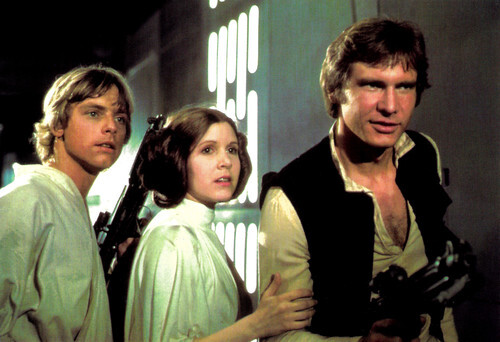
American postcard by Classico San Francisco, no. 105-527. Photo: Lucasfilm Ltd. Harrison Ford , Carrie Fisher and Mark Hamill in Star Wars - Episode IV - A New Hope (George Lucas, 1977). Caption: Luke Skywalker, Princess Leia and Han Solo.

American postcard by Classico San Francisco, no. 105-528. Photo: Lucasfilm Ltd. Mark Hamill as Luke Skywalker in Star Wars: Episode IV - A New Hope (George Lucas, 1977).

West-German postcard by Filmwelt Berlin, Bad Münder, no. SW 4.039, 1995. Photo: Lucasfilm Ltd. Harrison Ford in Star Wars - Episode IV - A New Hope (George Lucas, 1977).
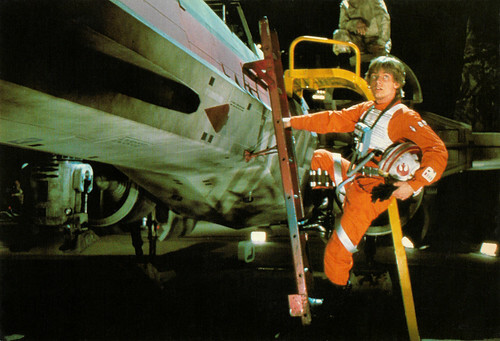
American postcard by Classico San Francisco, no. 105-059. Photo: Lucasfilm Ltd. Mark Hamill as Luke Skywalker in Star Wars: Episode IV - A New Hope (George Lucas, 1977).
A message for a certain Kenobi
Star Wars: Episode IV - A New Hope (original title: Star Wars) is chronologically the fourth instalment in the Star Wars series, but it is the first made Star Wars film. The film was produced by Gary Kurtz and directed by George Lucas from his own screenplay. The film is set in a fictional, distant galaxy. For 19 years, the dictatorial Empire has ruled the entire galaxy with an iron hand. A resistance group manages to steal the blueprint for the Death Star, a huge space station capable of destroying entire planets. This group passed data to the Rebel Alliance, which succeeds led by Princess Leia (Carrie Fisher). The ship carrying Leia is intercepted by Imperial forces led by Darth Vader. She is just able to send droid R2-D2 (Kenny Baker) and the humanoid robot C-3PO (Anthony Daniels) to the desert planet Tatooine with a message of help for a Jedi Master and an old friend of Leia's father, Obi-Wan Kenobi ( Alec Guinness ).
But on Tatooine, C-3PO and R2-D2 are captured by the Jawas, a gang of junk dealers. The Jawas sell the two droids to moisture farmer Owen Lars (Phil Brown) and his nephew Luke Skywalker (Mark Hamill). R2-D2, following Princess Leia's instructions, sets out to find Obi-Wan Kenobi. Luke does know a certain 'Kenobi' who lives as a hermit close to the mountains. Following R2D2, Luke is ambushed by Sand People, the local desert dwellers, and is eventually rescued by Obi-Wan Kenobi, whom he has only known as Ben Kenobi. In his dwelling, Obi-Wan tells Luke that he was once a Jedi but went into exile when the Sith seized power. He knows the Imperial forces will soon come looking for the droids. Luke fears for his uncle and aunt's safety, but when he gets to his house, it is already too late: the Stormtroopers have already been there and destroyed everything. His uncle and his wife, Luke's aunt Beru (Shelagh Fraser), have perished.
When Luke learns that his father was also a Jedi, he decides to go with Obi-Wan. Kenobi gives Luke the lightsaber that once belonged to his father. The two will go to Alderaan, Leia's home planet, to show the construction plans to Leia's adoptive father, hoping that the latter can discover a weakness of the Death Star. In a bar, Obi-Wan enlists the help of smuggler Han Solo ( Harrison Ford ) and his first mate Chewbacca (Peter Mayhew), a Wookiee. Han, who urgently needs money to pay off a debt, agrees to take Luke, Obi-Wan and the droids to Alderaan on his ship, the Millennium Falcon, which he claims is the fastest spaceship in the galaxy.
Meanwhile, Leia is trapped in the Death Star. Leia is interrogated by Darth Vader with the help of a torture droid to learn the location of the rebel base, but she does not reveal it. Grandmoff Tarkin (Peter Cushing), the commander of the Death Star, decides to force her to tell where the Rebels are by blowing up Alderaan with the Death Star. She gives a base, but Grand Moff Tarkin has her home planet destroyed anyway to demonstrate its firepower to the galaxy. But the specified base has long been abandoned, so the Grand Moff orders her death. On the way to Alderaan, Obi-Wan teaches Luke how to wield a lightsaber. Once the group arrives at Alderaan, they find only the debris left from the newly destroyed planet. The Death Star is also still there, and the Millennium Falcon is brought aboard via a tractor beam.
The Falcon's occupants use the secret hatches where Han hides his contraband to hide, and then disguise themselves as Stormtroopers to explore the Death Star unseen. Obi-Wan goes in search of the tractor-beam generator. Han, Luke and the droids discover that Leia is trapped in the Death Star. Luke and Han disguise themselves as Imperial stormtroopers, Chewbacca plays a prisoner to get into the detention block and free the princess. When the group wants to escape, Darth Vader (David Prowse, with the voice of James Earl Jones) intervenes. He and Obi-Wan fight each other in a lightsaber duel. When Obi-Wan sees Luke, he deliberately allows Darth Vader to kill him. As Luke, shocked by the old master's death, fires furiously at the stormtroopers present, he suddenly hears Obi-Wan's voice ordering him to flee.
The others manage to escape safely in the Falcon and rush back to Rebel headquarters. There the Rebels discover a weakness in the Death Star. Han Solo, not wanting to get further involved in this conflict, collects his earned money and leaves, while Luke attacks the Death Star with the other Rebels. For a moment, Darth Vader threatens to destroy Luke with his ship, but then Han (who apparently regretted his decision) intervenes with the Falcon. This allows Luke to successfully fire two torpedoes at a small ventilation hatch. The torpedoes cause a chain reaction in the Death Star, and the huge space station explodes. Han, Luke and Darth Vader escape the explosion with their ships, but Tarkin and the others, who were still inside the space station, die. In the final scene, Luke and Han are decorated by Princess Leia and the rest of the Rebel Alliance.
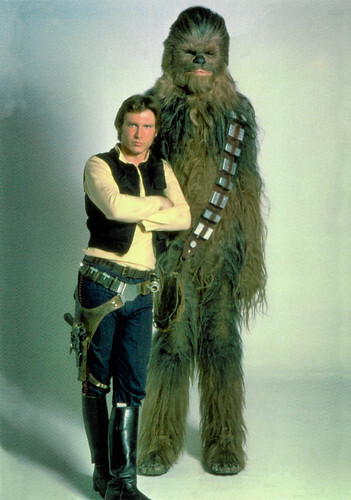
West-German postcard by Filmwelt Berlin, Bad Münder, no. SW 4.082, 1997. Photo: Lucasfilm Ltd. Harrison Ford and Peter Mayhew in Star Wars - Episode IV - A New Hope (George Lucas, 1977).
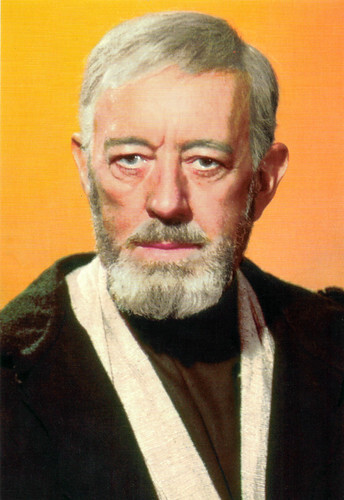
American postcard by Classico San Francisco, no. 105-521. Photo: Lucasfilm Ltd, 1997. Alec Guinness as Obi-Wan Kenobi in Star Wars: Episode IV - A New Hope (George Lucas, 1977).
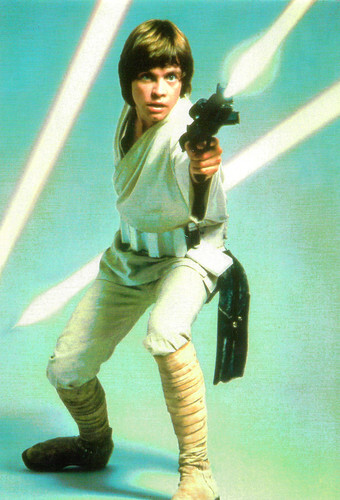
American postcard by Classico San Francisco, no. 105-530. Photo: Lucasfilm Ltd. Mark Hamill as Luke Skywalker in Star Wars - Episode IV - A New Hope (George Lucas, 1977).

American postcard by Classico San Francisco, no. 105-519. Photo: Lucasfilm Ltd. Carrie Fisher as Princess Leia in Star Wars: Episode IV - A New Hope (George Lucas, 1977).

American postcard by Classico San Francisco, no. 105-062. Photo: Lucasfilm Ltd. Anthony Daniels as C-3PO and Kenny Baker as R2-D2 in Star Wars: Episode IV - A New Hope (George Lucas, 1977).
New faces
The first concrete thoughts about a fantasy space film were developed by director and screenwriter George Lucas after the completion of his debut film THX 1138 (1971). Originally, he planned to secure the rights for a film adaptation of the comic book series 'Flash Gordon', which had fascinated him since childhood. Lucas entered into a partnership with United Artists that would guarantee him the production of two films. One was American Graffiti (1973), and the other was a space film based on 'Flash Gordon'. When Lucas was unable to obtain the rights for it, he decided to develop his own 'space opera'. In May 1973, he wrote a 14-page story for a total of six films. Because the story was set in space, it was mainly seen as a Science Fiction story. This genre was not very popular at the time, so United Artists and other studios rejected Lucas's idea. It was Alan Ladd Jr., the president of 20th Century Fox, who finally agreed.
In collaboration with Gloria Katz and Willard Huyck, Lucas wrote a full screenplay for the film in May 1974. While writing the screenplay, the initially conceived scenarios and characters changed drastically. Luke Skywalker was originally supposed to be a middle-aged general, and Han Solo was not a human but a green humanoid alien in the original screenplay. 20th Century Fox agreed to a budget of $8.25 million, while Lucas also secured the rights to any sequels, as well as control over possible merchandising. In 1975, Lucas founded the company Industrial Light & Magic (ILM) for special effects.
The cast was not known yet, except for Alec Guinness as Obi-Wan Kenobi and Peter Cushing as Grand Moff Tarkin. For the lead roles, Lucas chose new faces. Mark Hamill had previously only appeared in a few episodes of US television series. Equally unknown was the then 19-year-old Carrie Fisher, who had shortly before made a convincing cameo appearance as Loma in Shampoo. Actually not part of the actual audition was Harrison Ford , whose task was merely to serve as a dialogue partner for the auditioning actors and explain the respective dialogue passages to them. Lucas, however, was so convinced by Ford's sometimes arrogant and listless performance that he chose him for the role of the swashbuckling and self-confident Han Solo. Ford had already worked successfully with Lucas for American Graffiti (1973). Star Wars was in many ways Ford's stepping stone to becoming one of the most successful film actors in the world, having previously appeared mostly in supporting roles.
Filming began on 22 March 1976 in the Tunisian desert for the scenes on Tatooine. For the scenes for the moisture farm where Luke lives, filming took place in Matmata. The project faced several problems, with Lucas falling behind schedule after only a week. Props in particular often refused service. After filming in Tunisia was finished, they left for Elstree Studios in England for the rest of the film. Filming also took place at the Mayan ruin Tikal in Guatemala for the scenes of Yavin IV. Due to the many problems during filming, there was a lot of pressure on Lucas' shoulders to get the film finished on time. This eventually went so far that doctors had to advise him to reduce his stress. The film was scheduled for Christmas 1976, but due to delays, it did not materialise until the summer of 1977. When Lucas showed a trial version of the film to some friends, including directors Brian De Palma, John Milius and Steven Spielberg, their reactions were disappointing. In contrast, 20th Century Fox's crew was enthusiastic about the result. Although the film went over its $8 million budget due to numerous delays, it was the cheapest of the Star Wars films at $11 million.
Star Wars premiered on 25 May 1977 in 32 cinemas. Contrary to expectations, it broke all records. It grossed over $550 million during its initial run and was nominated for dozens of awards, eventually winning 54 of which 5 Oscars (Best Art Direction-Set Decoration, Best Costume Design, Best Visual Effects, Best film editing, Best Music and Best Sound). Today, the film is often regarded as one of the first true blockbusters and is still known as one of the most financially successful films ever. Even crew members like the model makers were asked for autographs by people who had seen the film. In terms of revenue, the film was the most successful film of 1977 and replaced Jaws (Steven Spielberg, 1975) as the most financially successful film in history at the time. It remained the most successful film ever until E.T. the Extra-Terrestrial (Steven Spielberg, 1982) broke this record.
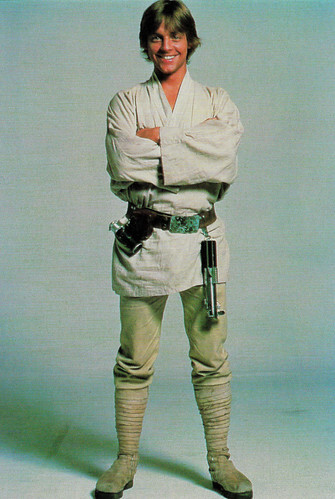
American postcard by Classico San Francisco, no. 105-074. Photo: Lucasfilm Ltd. Mark Hamill as Luke Skywalker in Star Wars - Episode IV - A New Hope (George Lucas, 1977).

French postcard by Studio Erving, Paris, no. 696. Photo: Lucasfilm Ltd. Harrison Ford in Star Wars - Episode IV - A New Hope (George Lucas, 1977).
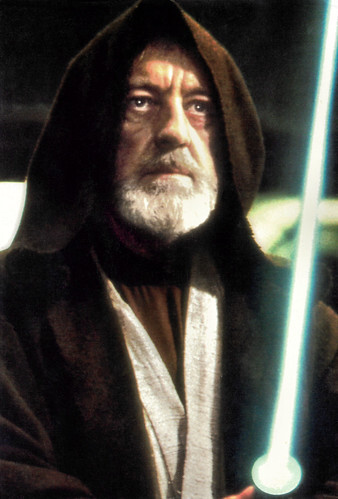
American postcard by Classico San Francisco, no. 105-507. Photo: Lucasfilm Ltd, 1997. Alec Guinness as Obi-Wan Kenobi in Star Wars: Episode IV - A New Hope (George Lucas, 1977).
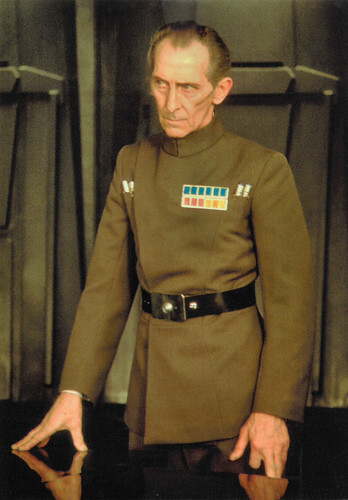
German postcard by Filmwelt Berlin, Bad Münder, no SW 4.081. Photo: Lucasfilm Ltd. Peter Cushing in Star Wars - Episode IV - A New Hope (George Lucas, 1977).
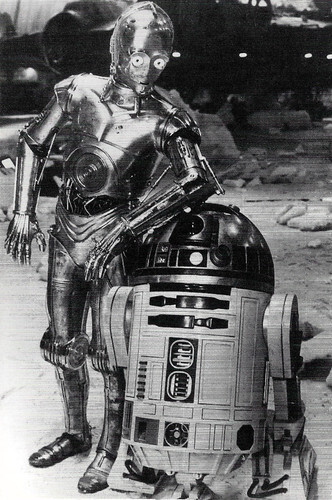
Belgian postcard by Joepie / Raider Bounty. Photo: Lucasfilm Ltd. Anthony Daniels as C-3PO and Kenny Baker as R2-D2 in Star Wars: Episode IV - A New Hope (George Lucas, 1977).

Small West-German collectors card by Topps, no. 31. Photo: Lucasfilm Ltd. Carrie Fisher as Princess Leia and Mark Hamill as Luke Skywalker in Star Wars: Episode IV - A New Hope (George Lucas, 1977). Caption: Luke shatters the door opener.
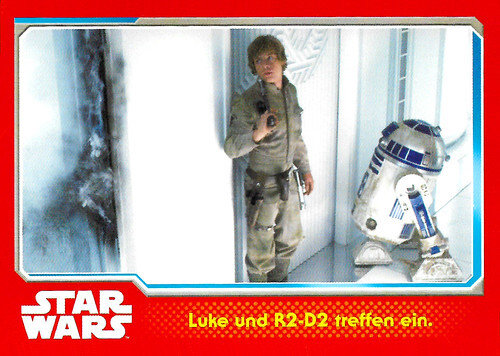
Small West-German collectors card by Topps, no. 87. Photo: Lucasfilm Ltd. Mark Hamill as Luke Skywalker in Star Wars: Episode IV - A New Hope (George Lucas, 1977). Caption: Luke and R2-D2 arrive.
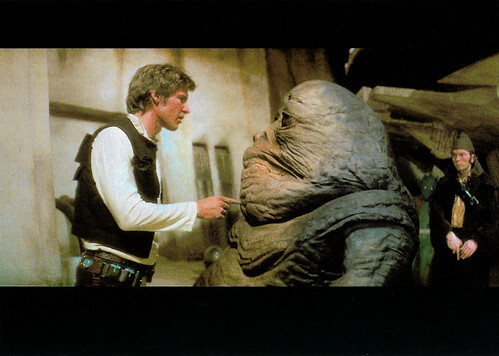
West-German postcard by Filmwelt Berlin, Bad Münder, no. SW 0.0226, 1997. Photo: Lucasfilm Ltd. Harrison Ford in Star Wars - Episode IV - A New Hope (George Lucas, 1977).
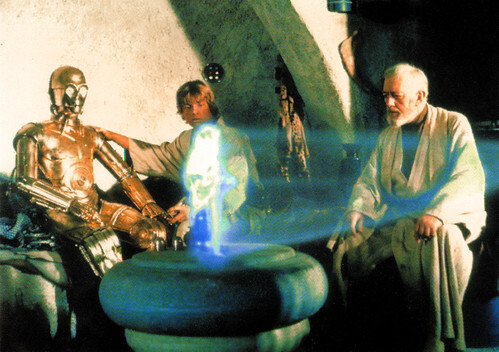
German postcard by Filmwelt Berlin, Bad Münder, no. SW 4.078. Photo: Lucasfilm Ltd. Anthony Daniels as C-3PO, Mark Hamill as Luke Skywalker and Alec Guinness as Obi-Wan Kenobi in Star Wars: Episode IV - A New Hope (George Lucas, 1977).
Sources: Wikipedia (Dutch, German and English) and IMDb.

American postcard by Classico San Francisco, no. 105-075. Photo: Lucasfilm Ltd. Anthony Daniels as C-3PO, Mark Hamill as Luke Skywalker and Alec Guinness as Obi-Wan Kenobi in Star Wars: Episode IV - A New Hope (George Lucas, 1977).

American postcard by Classico San Francisco, no. 105-527. Photo: Lucasfilm Ltd. Harrison Ford , Carrie Fisher and Mark Hamill in Star Wars - Episode IV - A New Hope (George Lucas, 1977). Caption: Luke Skywalker, Princess Leia and Han Solo.

American postcard by Classico San Francisco, no. 105-528. Photo: Lucasfilm Ltd. Mark Hamill as Luke Skywalker in Star Wars: Episode IV - A New Hope (George Lucas, 1977).

West-German postcard by Filmwelt Berlin, Bad Münder, no. SW 4.039, 1995. Photo: Lucasfilm Ltd. Harrison Ford in Star Wars - Episode IV - A New Hope (George Lucas, 1977).

American postcard by Classico San Francisco, no. 105-059. Photo: Lucasfilm Ltd. Mark Hamill as Luke Skywalker in Star Wars: Episode IV - A New Hope (George Lucas, 1977).
A message for a certain Kenobi
Star Wars: Episode IV - A New Hope (original title: Star Wars) is chronologically the fourth instalment in the Star Wars series, but it is the first made Star Wars film. The film was produced by Gary Kurtz and directed by George Lucas from his own screenplay. The film is set in a fictional, distant galaxy. For 19 years, the dictatorial Empire has ruled the entire galaxy with an iron hand. A resistance group manages to steal the blueprint for the Death Star, a huge space station capable of destroying entire planets. This group passed data to the Rebel Alliance, which succeeds led by Princess Leia (Carrie Fisher). The ship carrying Leia is intercepted by Imperial forces led by Darth Vader. She is just able to send droid R2-D2 (Kenny Baker) and the humanoid robot C-3PO (Anthony Daniels) to the desert planet Tatooine with a message of help for a Jedi Master and an old friend of Leia's father, Obi-Wan Kenobi ( Alec Guinness ).
But on Tatooine, C-3PO and R2-D2 are captured by the Jawas, a gang of junk dealers. The Jawas sell the two droids to moisture farmer Owen Lars (Phil Brown) and his nephew Luke Skywalker (Mark Hamill). R2-D2, following Princess Leia's instructions, sets out to find Obi-Wan Kenobi. Luke does know a certain 'Kenobi' who lives as a hermit close to the mountains. Following R2D2, Luke is ambushed by Sand People, the local desert dwellers, and is eventually rescued by Obi-Wan Kenobi, whom he has only known as Ben Kenobi. In his dwelling, Obi-Wan tells Luke that he was once a Jedi but went into exile when the Sith seized power. He knows the Imperial forces will soon come looking for the droids. Luke fears for his uncle and aunt's safety, but when he gets to his house, it is already too late: the Stormtroopers have already been there and destroyed everything. His uncle and his wife, Luke's aunt Beru (Shelagh Fraser), have perished.
When Luke learns that his father was also a Jedi, he decides to go with Obi-Wan. Kenobi gives Luke the lightsaber that once belonged to his father. The two will go to Alderaan, Leia's home planet, to show the construction plans to Leia's adoptive father, hoping that the latter can discover a weakness of the Death Star. In a bar, Obi-Wan enlists the help of smuggler Han Solo ( Harrison Ford ) and his first mate Chewbacca (Peter Mayhew), a Wookiee. Han, who urgently needs money to pay off a debt, agrees to take Luke, Obi-Wan and the droids to Alderaan on his ship, the Millennium Falcon, which he claims is the fastest spaceship in the galaxy.
Meanwhile, Leia is trapped in the Death Star. Leia is interrogated by Darth Vader with the help of a torture droid to learn the location of the rebel base, but she does not reveal it. Grandmoff Tarkin (Peter Cushing), the commander of the Death Star, decides to force her to tell where the Rebels are by blowing up Alderaan with the Death Star. She gives a base, but Grand Moff Tarkin has her home planet destroyed anyway to demonstrate its firepower to the galaxy. But the specified base has long been abandoned, so the Grand Moff orders her death. On the way to Alderaan, Obi-Wan teaches Luke how to wield a lightsaber. Once the group arrives at Alderaan, they find only the debris left from the newly destroyed planet. The Death Star is also still there, and the Millennium Falcon is brought aboard via a tractor beam.
The Falcon's occupants use the secret hatches where Han hides his contraband to hide, and then disguise themselves as Stormtroopers to explore the Death Star unseen. Obi-Wan goes in search of the tractor-beam generator. Han, Luke and the droids discover that Leia is trapped in the Death Star. Luke and Han disguise themselves as Imperial stormtroopers, Chewbacca plays a prisoner to get into the detention block and free the princess. When the group wants to escape, Darth Vader (David Prowse, with the voice of James Earl Jones) intervenes. He and Obi-Wan fight each other in a lightsaber duel. When Obi-Wan sees Luke, he deliberately allows Darth Vader to kill him. As Luke, shocked by the old master's death, fires furiously at the stormtroopers present, he suddenly hears Obi-Wan's voice ordering him to flee.
The others manage to escape safely in the Falcon and rush back to Rebel headquarters. There the Rebels discover a weakness in the Death Star. Han Solo, not wanting to get further involved in this conflict, collects his earned money and leaves, while Luke attacks the Death Star with the other Rebels. For a moment, Darth Vader threatens to destroy Luke with his ship, but then Han (who apparently regretted his decision) intervenes with the Falcon. This allows Luke to successfully fire two torpedoes at a small ventilation hatch. The torpedoes cause a chain reaction in the Death Star, and the huge space station explodes. Han, Luke and Darth Vader escape the explosion with their ships, but Tarkin and the others, who were still inside the space station, die. In the final scene, Luke and Han are decorated by Princess Leia and the rest of the Rebel Alliance.

West-German postcard by Filmwelt Berlin, Bad Münder, no. SW 4.082, 1997. Photo: Lucasfilm Ltd. Harrison Ford and Peter Mayhew in Star Wars - Episode IV - A New Hope (George Lucas, 1977).

American postcard by Classico San Francisco, no. 105-521. Photo: Lucasfilm Ltd, 1997. Alec Guinness as Obi-Wan Kenobi in Star Wars: Episode IV - A New Hope (George Lucas, 1977).

American postcard by Classico San Francisco, no. 105-530. Photo: Lucasfilm Ltd. Mark Hamill as Luke Skywalker in Star Wars - Episode IV - A New Hope (George Lucas, 1977).

American postcard by Classico San Francisco, no. 105-519. Photo: Lucasfilm Ltd. Carrie Fisher as Princess Leia in Star Wars: Episode IV - A New Hope (George Lucas, 1977).

American postcard by Classico San Francisco, no. 105-062. Photo: Lucasfilm Ltd. Anthony Daniels as C-3PO and Kenny Baker as R2-D2 in Star Wars: Episode IV - A New Hope (George Lucas, 1977).
New faces
The first concrete thoughts about a fantasy space film were developed by director and screenwriter George Lucas after the completion of his debut film THX 1138 (1971). Originally, he planned to secure the rights for a film adaptation of the comic book series 'Flash Gordon', which had fascinated him since childhood. Lucas entered into a partnership with United Artists that would guarantee him the production of two films. One was American Graffiti (1973), and the other was a space film based on 'Flash Gordon'. When Lucas was unable to obtain the rights for it, he decided to develop his own 'space opera'. In May 1973, he wrote a 14-page story for a total of six films. Because the story was set in space, it was mainly seen as a Science Fiction story. This genre was not very popular at the time, so United Artists and other studios rejected Lucas's idea. It was Alan Ladd Jr., the president of 20th Century Fox, who finally agreed.
In collaboration with Gloria Katz and Willard Huyck, Lucas wrote a full screenplay for the film in May 1974. While writing the screenplay, the initially conceived scenarios and characters changed drastically. Luke Skywalker was originally supposed to be a middle-aged general, and Han Solo was not a human but a green humanoid alien in the original screenplay. 20th Century Fox agreed to a budget of $8.25 million, while Lucas also secured the rights to any sequels, as well as control over possible merchandising. In 1975, Lucas founded the company Industrial Light & Magic (ILM) for special effects.
The cast was not known yet, except for Alec Guinness as Obi-Wan Kenobi and Peter Cushing as Grand Moff Tarkin. For the lead roles, Lucas chose new faces. Mark Hamill had previously only appeared in a few episodes of US television series. Equally unknown was the then 19-year-old Carrie Fisher, who had shortly before made a convincing cameo appearance as Loma in Shampoo. Actually not part of the actual audition was Harrison Ford , whose task was merely to serve as a dialogue partner for the auditioning actors and explain the respective dialogue passages to them. Lucas, however, was so convinced by Ford's sometimes arrogant and listless performance that he chose him for the role of the swashbuckling and self-confident Han Solo. Ford had already worked successfully with Lucas for American Graffiti (1973). Star Wars was in many ways Ford's stepping stone to becoming one of the most successful film actors in the world, having previously appeared mostly in supporting roles.
Filming began on 22 March 1976 in the Tunisian desert for the scenes on Tatooine. For the scenes for the moisture farm where Luke lives, filming took place in Matmata. The project faced several problems, with Lucas falling behind schedule after only a week. Props in particular often refused service. After filming in Tunisia was finished, they left for Elstree Studios in England for the rest of the film. Filming also took place at the Mayan ruin Tikal in Guatemala for the scenes of Yavin IV. Due to the many problems during filming, there was a lot of pressure on Lucas' shoulders to get the film finished on time. This eventually went so far that doctors had to advise him to reduce his stress. The film was scheduled for Christmas 1976, but due to delays, it did not materialise until the summer of 1977. When Lucas showed a trial version of the film to some friends, including directors Brian De Palma, John Milius and Steven Spielberg, their reactions were disappointing. In contrast, 20th Century Fox's crew was enthusiastic about the result. Although the film went over its $8 million budget due to numerous delays, it was the cheapest of the Star Wars films at $11 million.
Star Wars premiered on 25 May 1977 in 32 cinemas. Contrary to expectations, it broke all records. It grossed over $550 million during its initial run and was nominated for dozens of awards, eventually winning 54 of which 5 Oscars (Best Art Direction-Set Decoration, Best Costume Design, Best Visual Effects, Best film editing, Best Music and Best Sound). Today, the film is often regarded as one of the first true blockbusters and is still known as one of the most financially successful films ever. Even crew members like the model makers were asked for autographs by people who had seen the film. In terms of revenue, the film was the most successful film of 1977 and replaced Jaws (Steven Spielberg, 1975) as the most financially successful film in history at the time. It remained the most successful film ever until E.T. the Extra-Terrestrial (Steven Spielberg, 1982) broke this record.

American postcard by Classico San Francisco, no. 105-074. Photo: Lucasfilm Ltd. Mark Hamill as Luke Skywalker in Star Wars - Episode IV - A New Hope (George Lucas, 1977).

French postcard by Studio Erving, Paris, no. 696. Photo: Lucasfilm Ltd. Harrison Ford in Star Wars - Episode IV - A New Hope (George Lucas, 1977).

American postcard by Classico San Francisco, no. 105-507. Photo: Lucasfilm Ltd, 1997. Alec Guinness as Obi-Wan Kenobi in Star Wars: Episode IV - A New Hope (George Lucas, 1977).

German postcard by Filmwelt Berlin, Bad Münder, no SW 4.081. Photo: Lucasfilm Ltd. Peter Cushing in Star Wars - Episode IV - A New Hope (George Lucas, 1977).

Belgian postcard by Joepie / Raider Bounty. Photo: Lucasfilm Ltd. Anthony Daniels as C-3PO and Kenny Baker as R2-D2 in Star Wars: Episode IV - A New Hope (George Lucas, 1977).

Small West-German collectors card by Topps, no. 31. Photo: Lucasfilm Ltd. Carrie Fisher as Princess Leia and Mark Hamill as Luke Skywalker in Star Wars: Episode IV - A New Hope (George Lucas, 1977). Caption: Luke shatters the door opener.

Small West-German collectors card by Topps, no. 87. Photo: Lucasfilm Ltd. Mark Hamill as Luke Skywalker in Star Wars: Episode IV - A New Hope (George Lucas, 1977). Caption: Luke and R2-D2 arrive.

West-German postcard by Filmwelt Berlin, Bad Münder, no. SW 0.0226, 1997. Photo: Lucasfilm Ltd. Harrison Ford in Star Wars - Episode IV - A New Hope (George Lucas, 1977).

German postcard by Filmwelt Berlin, Bad Münder, no. SW 4.078. Photo: Lucasfilm Ltd. Anthony Daniels as C-3PO, Mark Hamill as Luke Skywalker and Alec Guinness as Obi-Wan Kenobi in Star Wars: Episode IV - A New Hope (George Lucas, 1977).
Sources: Wikipedia (Dutch, German and English) and IMDb.
Published on December 23, 2022 22:00
Star Wars- Episode IV - A New Hope (1977)
This Christmas period is at EFSP reserved for the Star Wars saga. Like George Lucas did, we start with our posts on this epic space opera somewhere in the middle with Star Wars- Episode IV - A New Hope (1977), the episode George Lucas directed himself. I remember what a sensation the film was at the time: a revolutionary, new kind of entertainment, a serious fantasy epic full of energy, wonderful special effects and new exciting stars. The film gave us some unforgettable characters: the heroes Luke Skywalker and Han Solo, the mysterious Princess Leia, the robots CP-3PO and R2D2 - a kind of Laurel & Hardy in space, and of course the old Jedi Obi-Wan-Kenobi, played by the great Alec Guinness. Star Wars was a gigantic hit and launched its own fictional universe with dozens of books, comics, short stories, video games, sequels, and series, and is deeply rooted in modern pop culture.

American postcard by Classico San Francisco, no. 105-075. Photo: Lucasfilm Ltd. Anthony Daniels as C-3PO, Mark Hamill as Luke Skywalker and Alec Guinness as Obi-Wan Kenobi in Star Wars: Episode IV - A New Hope (George Lucas, 1977).

American postcard by Classico San Francisco, no. 105-527. Photo: Lucasfilm Ltd. Harrison Ford , Carrie Fisher and Mark Hamill in Star Wars - Episode IV - A New Hope (George Lucas, 1977). Caption: Luke Skywalker, Princess Leia and Han Solo.

American postcard by Classico San Francisco, no. 105-528. Photo: Lucasfilm Ltd. Mark Hamill as Luke Skywalker in Star Wars: Episode IV - A New Hope (George Lucas, 1977).

West-German postcard by Filmwelt Berlin, Bad Münder, no. SW 4.039, 1995. Photo: Lucasfilm Ltd. Harrison Ford in Star Wars - Episode IV - A New Hope (George Lucas, 1977).

American postcard by Classico San Francisco, no. 105-059. Photo: Lucasfilm Ltd. Mark Hamill as Luke Skywalker in Star Wars: Episode IV - A New Hope (George Lucas, 1977).
A message for a certain Kenobi
Star Wars: Episode IV - A New Hope (original title: Star Wars) is chronologically the fourth instalment in the Star Wars series, but it is the first made Star Wars film. The film was produced by Gary Kurtz and directed by George Lucas from his own screenplay. The film is set in a fictional, distant galaxy. For 19 years, the dictatorial Empire has ruled the entire galaxy with an iron hand. A resistance group manages to steal the blueprint for the Death Star, a huge space station capable of destroying entire planets. This group passed data to the Rebel Alliance, which succeeds led by Princess Leia (Carrie Fisher). The ship carrying Leia is intercepted by Imperial forces led by Darth Vader. She is just able to send droid R2-D2 (Kenny Baker) and the humanoid robot C-3PO (Anthony Daniels) to the desert planet Tatooine with a message of help for a Jedi Master and an old friend of Leia's father, Obi-Wan Kenobi ( Alec Guinness ).
But on Tatooine, C-3PO and R2-D2 are captured by the Jawas, a gang of junk dealers. The Jawas sell the two droids to moisture farmer Owen Lars (Phil Brown) and his nephew Luke Skywalker (Mark Hamill). R2-D2, following Princess Leia's instructions, sets out to find Obi-Wan Kenobi. Luke does know a certain 'Kenobi' who lives as a hermit close to the mountains. Following R2D2, Luke is ambushed by Sand People, the local desert dwellers, and is eventually rescued by Obi-Wan Kenobi, whom he has only known as Ben Kenobi. In his dwelling, Obi-Wan tells Luke that he was once a Jedi but went into exile when the Sith seized power. He knows the Imperial forces will soon come looking for the droids. Luke fears for his uncle and aunt's safety, but when he gets to his house, it is already too late: the Stormtroopers have already been there and destroyed everything. His uncle and his wife, Luke's aunt Beru (Shelagh Fraser), have perished.
When Luke learns that his father was also a Jedi, he decides to go with Obi-Wan. Kenobi gives Luke the lightsaber that once belonged to his father. The two will go to Alderaan, Leia's home planet, to show the construction plans to Leia's adoptive father, hoping that the latter can discover a weakness of the Death Star. In a bar, Obi-Wan enlists the help of smuggler Han Solo ( Harrison Ford ) and his first mate Chewbacca (Peter Mayhew), a Wookiee. Han, who urgently needs money to pay off a debt, agrees to take Luke, Obi-Wan and the droids to Alderaan on his ship, the Millennium Falcon, which he claims is the fastest spaceship in the galaxy.
Meanwhile, Leia is trapped in the Death Star. Leia is interrogated by Darth Vader with the help of a torture droid to learn the location of the rebel base, but she does not reveal it. Grandmoff Tarkin (Peter Cushing), the commander of the Death Star, decides to force her to tell where the Rebels are by blowing up Alderaan with the Death Star. She gives a base, but Grand Moff Tarkin has her home planet destroyed anyway to demonstrate its firepower to the galaxy. But the specified base has long been abandoned, so the Grand Moff orders her death. On the way to Alderaan, Obi-Wan teaches Luke how to wield a lightsaber. Once the group arrives at Alderaan, they find only the debris left from the newly destroyed planet. The Death Star is also still there, and the Millennium Falcon is brought aboard via a tractor beam.
The Falcon's occupants use the secret hatches where Han hides his contraband to hide, and then disguise themselves as Stormtroopers to explore the Death Star unseen. Obi-Wan goes in search of the tractor-beam generator. Han, Luke and the droids discover that Leia is trapped in the Death Star. Luke and Han disguise themselves as Imperial stormtroopers, Chewbacca plays a prisoner to get into the detention block and free the princess. When the group wants to escape, Darth Vader (David Prowse, with the voice of James Earl Jones) intervenes. He and Obi-Wan fight each other in a lightsaber duel. When Obi-Wan sees Luke, he deliberately allows Darth Vader to kill him. As Luke, shocked by the old master's death, fires furiously at the stormtroopers present, he suddenly hears Obi-Wan's voice ordering him to flee.
The others manage to escape safely in the Falcon and rush back to Rebel headquarters. There the Rebels discover a weakness in the Death Star. Han Solo, not wanting to get further involved in this conflict, collects his earned money and leaves, while Luke attacks the Death Star with the other Rebels. For a moment, Darth Vader threatens to destroy Luke with his ship, but then Han (who apparently regretted his decision) intervenes with the Falcon. This allows Luke to successfully fire two torpedoes at a small ventilation hatch. The torpedoes cause a chain reaction in the Death Star, and the huge space station explodes. Han, Luke and Darth Vader escape the explosion with their ships, but Tarkin and the others, who were still inside the space station, die. In the final scene, Luke and Han are decorated by Princess Leia and the rest of the Rebel Alliance.

West-German postcard by Filmwelt Berlin, Bad Münder, no. SW 4.082, 1997. Photo: Lucasfilm Ltd. Harrison Ford and Peter Mayhew in Star Wars - Episode IV - A New Hope (George Lucas, 1977).

American postcard by Classico San Francisco, no. 105-521. Photo: Lucasfilm Ltd, 1997. Alec Guinness as Obi-Wan Kenobi in Star Wars: Episode IV - A New Hope (George Lucas, 1977).

American postcard by Classico San Francisco, no. 105-530. Photo: Lucasfilm Ltd. Mark Hamill as Luke Skywalker in Star Wars - Episode IV - A New Hope (George Lucas, 1977).

American postcard by Classico San Francisco, no. 105-519. Photo: Lucasfilm Ltd. Carrie Fisher as Princess Leia in Star Wars: Episode IV - A New Hope (George Lucas, 1977).

American postcard by Classico San Francisco, no. 105-062. Photo: Lucasfilm Ltd. Anthony Daniels as C-3PO and Kenny Baker as R2-D2 in Star Wars: Episode IV - A New Hope (George Lucas, 1977).
New faces
The first concrete thoughts about a fantasy space film were developed by director and screenwriter George Lucas after the completion of his debut film THX 1138 (1971). Originally, he planned to secure the rights for a film adaptation of the comic book series 'Flash Gordon', which had fascinated him since childhood. Lucas entered into a partnership with United Artists that would guarantee him the production of two films. One was American Graffiti (1973), and the other was a space film based on 'Flash Gordon'. When Lucas was unable to obtain the rights for it, he decided to develop his own 'space opera'. In May 1973, he wrote a 14-page story for a total of six films. Because the story was set in space, it was mainly seen as a Science Fiction story. This genre was not very popular at the time, so United Artists and other studios rejected Lucas's idea. It was Alan Ladd Jr., the president of 20th Century Fox, who finally agreed.
In collaboration with Gloria Katz and Willard Huyck, Lucas wrote a full screenplay for the film in May 1974. While writing the screenplay, the initially conceived scenarios and characters changed drastically. Luke Skywalker was originally supposed to be a middle-aged general, and Han Solo was not a human but a green humanoid alien in the original screenplay. 20th Century Fox agreed to a budget of $8.25 million, while Lucas also secured the rights to any sequels, as well as control over possible merchandising. In 1975, Lucas founded the company Industrial Light & Magic (ILM) for special effects.
The cast was not known yet, except for Alec Guinness as Obi-Wan Kenobi and Peter Cushing as Grand Moff Tarkin. For the lead roles, Lucas chose new faces. Mark Hamill had previously only appeared in a few episodes of US television series. Equally unknown was the then 19-year-old Carrie Fisher, who had shortly before made a convincing cameo appearance as Loma in Shampoo. Actually not part of the actual audition was Harrison Ford , whose task was merely to serve as a dialogue partner for the auditioning actors and explain the respective dialogue passages to them. Lucas, however, was so convinced by Ford's sometimes arrogant and listless performance that he chose him for the role of the swashbuckling and self-confident Han Solo. Ford had already worked successfully with Lucas for American Graffiti (1973). Star Wars was in many ways Ford's stepping stone to becoming one of the most successful film actors in the world, having previously appeared mostly in supporting roles.
Filming began on 22 March 1976 in the Tunisian desert for the scenes on Tatooine. For the scenes for the moisture farm where Luke lives, filming took place in Matmata. The project faced several problems, with Lucas falling behind schedule after only a week. Props in particular often refused service. After filming in Tunisia was finished, they left for Elstree Studios in England for the rest of the film. Filming also took place at the Mayan ruin Tikal in Guatemala for the scenes of Yavin IV. Due to the many problems during filming, there was a lot of pressure on Lucas' shoulders to get the film finished on time. This eventually went so far that doctors had to advise him to reduce his stress. The film was scheduled for Christmas 1976, but due to delays, it did not materialise until the summer of 1977. When Lucas showed a trial version of the film to some friends, including directors Brian De Palma, John Milius and Steven Spielberg, their reactions were disappointing. In contrast, 20th Century Fox's crew was enthusiastic about the result. Although the film went over its $8 million budget due to numerous delays, it was the cheapest of the Star Wars films at $11 million.
Star Wars premiered on 25 May 1977 in 32 cinemas. Contrary to expectations, it broke all records. It grossed over $550 million during its initial run and was nominated for dozens of awards, eventually winning 54 of which 5 Oscars (Best Art Direction-Set Decoration, Best Costume Design, Best Visual Effects, Best film editing, Best Music and Best Sound). Today, the film is often regarded as one of the first true blockbusters and is still known as one of the most financially successful films ever. Even crew members like the model makers were asked for autographs by people who had seen the film. In terms of revenue, the film was the most successful film of 1977 and replaced Jaws (Steven Spielberg, 1975) as the most financially successful film in history at the time. It remained the most successful film ever until E.T. the Extra-Terrestrial (Steven Spielberg, 1982) broke this record.

American postcard by Classico San Francisco, no. 105-074. Photo: Lucasfilm Ltd. Mark Hamill as Luke Skywalker in Star Wars - Episode IV - A New Hope (George Lucas, 1977).

French postcard by Studio Erving, Paris, no. 696. Photo: Lucasfilm Ltd. Harrison Ford in Star Wars - Episode IV - A New Hope (George Lucas, 1977).

American postcard by Classico San Francisco, no. 105-507. Photo: Lucasfilm Ltd, 1997. Alec Guinness as Obi-Wan Kenobi in Star Wars: Episode IV - A New Hope (George Lucas, 1977).

German postcard by Filmwelt Berlin, Bad Münder, no SW 4.081. Photo: Lucasfilm Ltd. Peter Cushing in Star Wars - Episode IV - A New Hope (George Lucas, 1977).

Belgian postcard by Joepie / Raider Bounty. Photo: Lucasfilm Ltd. Anthony Daniels as C-3PO and Kenny Baker as R2-D2 in Star Wars: Episode IV - A New Hope (George Lucas, 1977).

Small West-German collectors card by Topps, no. 31. Photo: Lucasfilm Ltd. Carrie Fisher as Princess Leia and Mark Hamill as Luke Skywalker in Star Wars: Episode IV - A New Hope (George Lucas, 1977). Caption: Luke shatters the door opener.

Small West-German collectors card by Topps, no. 87. Photo: Lucasfilm Ltd. Mark Hamill as Luke Skywalker in Star Wars: Episode IV - A New Hope (George Lucas, 1977). Caption: Luke and R2-D2 arrive.

West-German postcard by Filmwelt Berlin, Bad Münder, no. SW 0.0226, 1997. Photo: Lucasfilm Ltd. Harrison Ford in Star Wars - Episode IV - A New Hope (George Lucas, 1977).

German postcard by Filmwelt Berlin, Bad Münder, no. SW 4.078. Photo: Lucasfilm Ltd. Anthony Daniels as C-3PO, Mark Hamill as Luke Skywalker and Alec Guinness as Obi-Wan Kenobi in Star Wars: Episode IV - A New Hope (George Lucas, 1977).
Sources: Wikipedia (Dutch, German and English) and IMDb.

American postcard by Classico San Francisco, no. 105-075. Photo: Lucasfilm Ltd. Anthony Daniels as C-3PO, Mark Hamill as Luke Skywalker and Alec Guinness as Obi-Wan Kenobi in Star Wars: Episode IV - A New Hope (George Lucas, 1977).

American postcard by Classico San Francisco, no. 105-527. Photo: Lucasfilm Ltd. Harrison Ford , Carrie Fisher and Mark Hamill in Star Wars - Episode IV - A New Hope (George Lucas, 1977). Caption: Luke Skywalker, Princess Leia and Han Solo.

American postcard by Classico San Francisco, no. 105-528. Photo: Lucasfilm Ltd. Mark Hamill as Luke Skywalker in Star Wars: Episode IV - A New Hope (George Lucas, 1977).

West-German postcard by Filmwelt Berlin, Bad Münder, no. SW 4.039, 1995. Photo: Lucasfilm Ltd. Harrison Ford in Star Wars - Episode IV - A New Hope (George Lucas, 1977).

American postcard by Classico San Francisco, no. 105-059. Photo: Lucasfilm Ltd. Mark Hamill as Luke Skywalker in Star Wars: Episode IV - A New Hope (George Lucas, 1977).
A message for a certain Kenobi
Star Wars: Episode IV - A New Hope (original title: Star Wars) is chronologically the fourth instalment in the Star Wars series, but it is the first made Star Wars film. The film was produced by Gary Kurtz and directed by George Lucas from his own screenplay. The film is set in a fictional, distant galaxy. For 19 years, the dictatorial Empire has ruled the entire galaxy with an iron hand. A resistance group manages to steal the blueprint for the Death Star, a huge space station capable of destroying entire planets. This group passed data to the Rebel Alliance, which succeeds led by Princess Leia (Carrie Fisher). The ship carrying Leia is intercepted by Imperial forces led by Darth Vader. She is just able to send droid R2-D2 (Kenny Baker) and the humanoid robot C-3PO (Anthony Daniels) to the desert planet Tatooine with a message of help for a Jedi Master and an old friend of Leia's father, Obi-Wan Kenobi ( Alec Guinness ).
But on Tatooine, C-3PO and R2-D2 are captured by the Jawas, a gang of junk dealers. The Jawas sell the two droids to moisture farmer Owen Lars (Phil Brown) and his nephew Luke Skywalker (Mark Hamill). R2-D2, following Princess Leia's instructions, sets out to find Obi-Wan Kenobi. Luke does know a certain 'Kenobi' who lives as a hermit close to the mountains. Following R2D2, Luke is ambushed by Sand People, the local desert dwellers, and is eventually rescued by Obi-Wan Kenobi, whom he has only known as Ben Kenobi. In his dwelling, Obi-Wan tells Luke that he was once a Jedi but went into exile when the Sith seized power. He knows the Imperial forces will soon come looking for the droids. Luke fears for his uncle and aunt's safety, but when he gets to his house, it is already too late: the Stormtroopers have already been there and destroyed everything. His uncle and his wife, Luke's aunt Beru (Shelagh Fraser), have perished.
When Luke learns that his father was also a Jedi, he decides to go with Obi-Wan. Kenobi gives Luke the lightsaber that once belonged to his father. The two will go to Alderaan, Leia's home planet, to show the construction plans to Leia's adoptive father, hoping that the latter can discover a weakness of the Death Star. In a bar, Obi-Wan enlists the help of smuggler Han Solo ( Harrison Ford ) and his first mate Chewbacca (Peter Mayhew), a Wookiee. Han, who urgently needs money to pay off a debt, agrees to take Luke, Obi-Wan and the droids to Alderaan on his ship, the Millennium Falcon, which he claims is the fastest spaceship in the galaxy.
Meanwhile, Leia is trapped in the Death Star. Leia is interrogated by Darth Vader with the help of a torture droid to learn the location of the rebel base, but she does not reveal it. Grandmoff Tarkin (Peter Cushing), the commander of the Death Star, decides to force her to tell where the Rebels are by blowing up Alderaan with the Death Star. She gives a base, but Grand Moff Tarkin has her home planet destroyed anyway to demonstrate its firepower to the galaxy. But the specified base has long been abandoned, so the Grand Moff orders her death. On the way to Alderaan, Obi-Wan teaches Luke how to wield a lightsaber. Once the group arrives at Alderaan, they find only the debris left from the newly destroyed planet. The Death Star is also still there, and the Millennium Falcon is brought aboard via a tractor beam.
The Falcon's occupants use the secret hatches where Han hides his contraband to hide, and then disguise themselves as Stormtroopers to explore the Death Star unseen. Obi-Wan goes in search of the tractor-beam generator. Han, Luke and the droids discover that Leia is trapped in the Death Star. Luke and Han disguise themselves as Imperial stormtroopers, Chewbacca plays a prisoner to get into the detention block and free the princess. When the group wants to escape, Darth Vader (David Prowse, with the voice of James Earl Jones) intervenes. He and Obi-Wan fight each other in a lightsaber duel. When Obi-Wan sees Luke, he deliberately allows Darth Vader to kill him. As Luke, shocked by the old master's death, fires furiously at the stormtroopers present, he suddenly hears Obi-Wan's voice ordering him to flee.
The others manage to escape safely in the Falcon and rush back to Rebel headquarters. There the Rebels discover a weakness in the Death Star. Han Solo, not wanting to get further involved in this conflict, collects his earned money and leaves, while Luke attacks the Death Star with the other Rebels. For a moment, Darth Vader threatens to destroy Luke with his ship, but then Han (who apparently regretted his decision) intervenes with the Falcon. This allows Luke to successfully fire two torpedoes at a small ventilation hatch. The torpedoes cause a chain reaction in the Death Star, and the huge space station explodes. Han, Luke and Darth Vader escape the explosion with their ships, but Tarkin and the others, who were still inside the space station, die. In the final scene, Luke and Han are decorated by Princess Leia and the rest of the Rebel Alliance.

West-German postcard by Filmwelt Berlin, Bad Münder, no. SW 4.082, 1997. Photo: Lucasfilm Ltd. Harrison Ford and Peter Mayhew in Star Wars - Episode IV - A New Hope (George Lucas, 1977).

American postcard by Classico San Francisco, no. 105-521. Photo: Lucasfilm Ltd, 1997. Alec Guinness as Obi-Wan Kenobi in Star Wars: Episode IV - A New Hope (George Lucas, 1977).

American postcard by Classico San Francisco, no. 105-530. Photo: Lucasfilm Ltd. Mark Hamill as Luke Skywalker in Star Wars - Episode IV - A New Hope (George Lucas, 1977).

American postcard by Classico San Francisco, no. 105-519. Photo: Lucasfilm Ltd. Carrie Fisher as Princess Leia in Star Wars: Episode IV - A New Hope (George Lucas, 1977).

American postcard by Classico San Francisco, no. 105-062. Photo: Lucasfilm Ltd. Anthony Daniels as C-3PO and Kenny Baker as R2-D2 in Star Wars: Episode IV - A New Hope (George Lucas, 1977).
New faces
The first concrete thoughts about a fantasy space film were developed by director and screenwriter George Lucas after the completion of his debut film THX 1138 (1971). Originally, he planned to secure the rights for a film adaptation of the comic book series 'Flash Gordon', which had fascinated him since childhood. Lucas entered into a partnership with United Artists that would guarantee him the production of two films. One was American Graffiti (1973), and the other was a space film based on 'Flash Gordon'. When Lucas was unable to obtain the rights for it, he decided to develop his own 'space opera'. In May 1973, he wrote a 14-page story for a total of six films. Because the story was set in space, it was mainly seen as a Science Fiction story. This genre was not very popular at the time, so United Artists and other studios rejected Lucas's idea. It was Alan Ladd Jr., the president of 20th Century Fox, who finally agreed.
In collaboration with Gloria Katz and Willard Huyck, Lucas wrote a full screenplay for the film in May 1974. While writing the screenplay, the initially conceived scenarios and characters changed drastically. Luke Skywalker was originally supposed to be a middle-aged general, and Han Solo was not a human but a green humanoid alien in the original screenplay. 20th Century Fox agreed to a budget of $8.25 million, while Lucas also secured the rights to any sequels, as well as control over possible merchandising. In 1975, Lucas founded the company Industrial Light & Magic (ILM) for special effects.
The cast was not known yet, except for Alec Guinness as Obi-Wan Kenobi and Peter Cushing as Grand Moff Tarkin. For the lead roles, Lucas chose new faces. Mark Hamill had previously only appeared in a few episodes of US television series. Equally unknown was the then 19-year-old Carrie Fisher, who had shortly before made a convincing cameo appearance as Loma in Shampoo. Actually not part of the actual audition was Harrison Ford , whose task was merely to serve as a dialogue partner for the auditioning actors and explain the respective dialogue passages to them. Lucas, however, was so convinced by Ford's sometimes arrogant and listless performance that he chose him for the role of the swashbuckling and self-confident Han Solo. Ford had already worked successfully with Lucas for American Graffiti (1973). Star Wars was in many ways Ford's stepping stone to becoming one of the most successful film actors in the world, having previously appeared mostly in supporting roles.
Filming began on 22 March 1976 in the Tunisian desert for the scenes on Tatooine. For the scenes for the moisture farm where Luke lives, filming took place in Matmata. The project faced several problems, with Lucas falling behind schedule after only a week. Props in particular often refused service. After filming in Tunisia was finished, they left for Elstree Studios in England for the rest of the film. Filming also took place at the Mayan ruin Tikal in Guatemala for the scenes of Yavin IV. Due to the many problems during filming, there was a lot of pressure on Lucas' shoulders to get the film finished on time. This eventually went so far that doctors had to advise him to reduce his stress. The film was scheduled for Christmas 1976, but due to delays, it did not materialise until the summer of 1977. When Lucas showed a trial version of the film to some friends, including directors Brian De Palma, John Milius and Steven Spielberg, their reactions were disappointing. In contrast, 20th Century Fox's crew was enthusiastic about the result. Although the film went over its $8 million budget due to numerous delays, it was the cheapest of the Star Wars films at $11 million.
Star Wars premiered on 25 May 1977 in 32 cinemas. Contrary to expectations, it broke all records. It grossed over $550 million during its initial run and was nominated for dozens of awards, eventually winning 54 of which 5 Oscars (Best Art Direction-Set Decoration, Best Costume Design, Best Visual Effects, Best film editing, Best Music and Best Sound). Today, the film is often regarded as one of the first true blockbusters and is still known as one of the most financially successful films ever. Even crew members like the model makers were asked for autographs by people who had seen the film. In terms of revenue, the film was the most successful film of 1977 and replaced Jaws (Steven Spielberg, 1975) as the most financially successful film in history at the time. It remained the most successful film ever until E.T. the Extra-Terrestrial (Steven Spielberg, 1982) broke this record.

American postcard by Classico San Francisco, no. 105-074. Photo: Lucasfilm Ltd. Mark Hamill as Luke Skywalker in Star Wars - Episode IV - A New Hope (George Lucas, 1977).

French postcard by Studio Erving, Paris, no. 696. Photo: Lucasfilm Ltd. Harrison Ford in Star Wars - Episode IV - A New Hope (George Lucas, 1977).

American postcard by Classico San Francisco, no. 105-507. Photo: Lucasfilm Ltd, 1997. Alec Guinness as Obi-Wan Kenobi in Star Wars: Episode IV - A New Hope (George Lucas, 1977).

German postcard by Filmwelt Berlin, Bad Münder, no SW 4.081. Photo: Lucasfilm Ltd. Peter Cushing in Star Wars - Episode IV - A New Hope (George Lucas, 1977).

Belgian postcard by Joepie / Raider Bounty. Photo: Lucasfilm Ltd. Anthony Daniels as C-3PO and Kenny Baker as R2-D2 in Star Wars: Episode IV - A New Hope (George Lucas, 1977).

Small West-German collectors card by Topps, no. 31. Photo: Lucasfilm Ltd. Carrie Fisher as Princess Leia and Mark Hamill as Luke Skywalker in Star Wars: Episode IV - A New Hope (George Lucas, 1977). Caption: Luke shatters the door opener.

Small West-German collectors card by Topps, no. 87. Photo: Lucasfilm Ltd. Mark Hamill as Luke Skywalker in Star Wars: Episode IV - A New Hope (George Lucas, 1977). Caption: Luke and R2-D2 arrive.

West-German postcard by Filmwelt Berlin, Bad Münder, no. SW 0.0226, 1997. Photo: Lucasfilm Ltd. Harrison Ford in Star Wars - Episode IV - A New Hope (George Lucas, 1977).

German postcard by Filmwelt Berlin, Bad Münder, no. SW 4.078. Photo: Lucasfilm Ltd. Anthony Daniels as C-3PO, Mark Hamill as Luke Skywalker and Alec Guinness as Obi-Wan Kenobi in Star Wars: Episode IV - A New Hope (George Lucas, 1977).
Sources: Wikipedia (Dutch, German and English) and IMDb.
Published on December 23, 2022 22:00
December 21, 2022
Ingrid Bergman
Ingrid Bergman (1915-1982) was ‘Sweden's illustrious gift to Hollywood’. In the 1940s, the fresh and naturally beautiful actress won three times the Oscar, twice the Emmy, and once the Tony Award for Best Actress. Little known is that before she went to Hollywood she already had a European film career.

Italian postcard by Garami, Milano. Photo: Warner Bros.
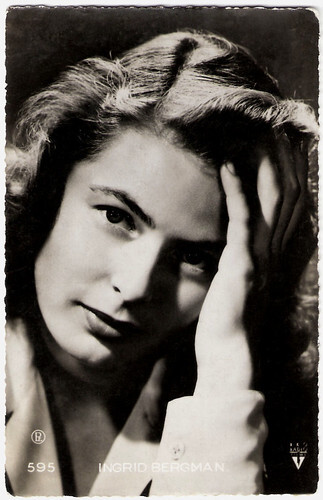
Vintage postcard by PE, no. 595. Photo: RKO Radio Pictures.
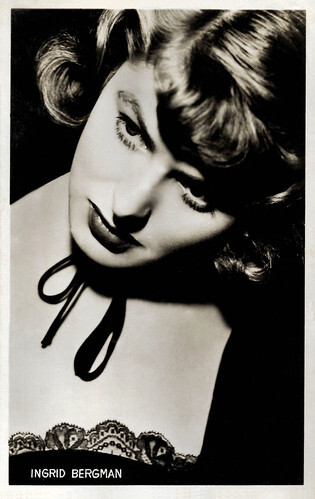
Dutch postcard, no. 15.
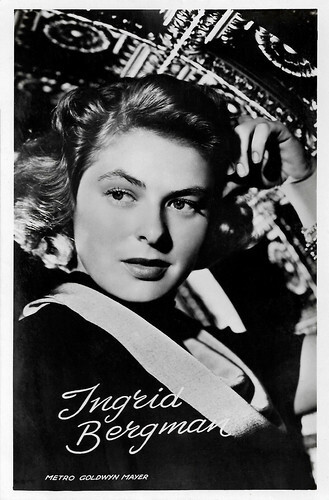
Dutch postcard, no. 3320. Photo: MGM (Metro-Goldwyn-Mayer).
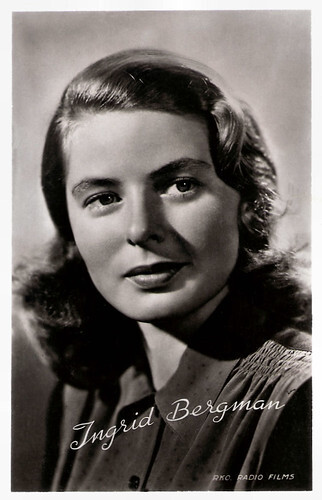
Dutch postcard, no. 3031. Photo: RKO Radio Films.
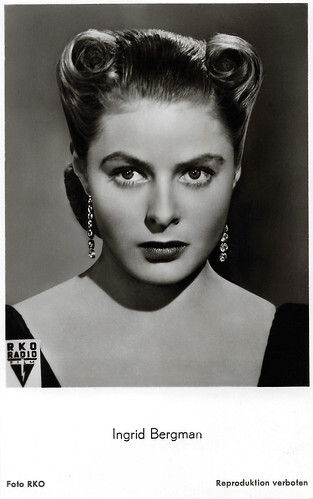
West-German postcard by F.J. Rüdel, Filmpostkartenverlag. Hamburg-Bergedorf, no. 213. Photo: RKO. Ingrid Bergman in Notorious (Alfred Hitchcock, 1946).
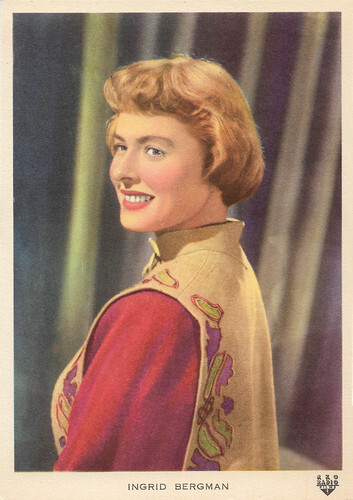
Uruguayan postcard by CF. Photo: RKO Radio Films. Ingrid Bergman in Joan of Arc (Victor Fleming, 1948).
Summer Break
Ingrid Bergman was born in Stockholm, Sweden in 1915 to a Swedish father and a German mother.
At age 17, she had a taste of acting when she played an uncredited role of a girl standing in line in the Swedish film Landskamp (Gunnar Skoglund, 1932). The next year she was accepted to the Royal Dramatic Theatre in Stockholm, but she soon decided that stage acting was not for her.
During her first summer break, she was hired at a Swedish film studio to work in film full time. Her first film part was in Munkbrogreven/The Count of the Old Town (Edvin Adolphson, 1935), where she had a speaking part as Elsa Edlund.
In the following years, she made a dozen films in Sweden that established her as a class actress. Among them were Bränningar/The Surf (Ivar Johansson, 1935) and Dollar (Gustaf Mollander, 1938).
Another film, En kvinnas ansikte (Gustaf Molander, 1938) would later be remade as A Woman's Face with Joan Crawford . Bergman also made a film in Germany, Die Vier Gesellen/The Four Companions (Carl Froelich, 1938).
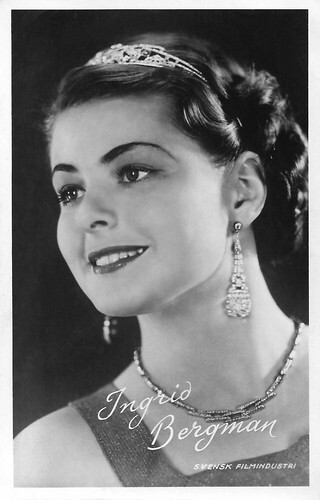
Dutch postcard by Takken / 't Sticht, Utrecht, no. 662. Photo: Svensk Filmindustri. Ingrid Bergman in Swedenhielms (Gustaf Molander, 1935).
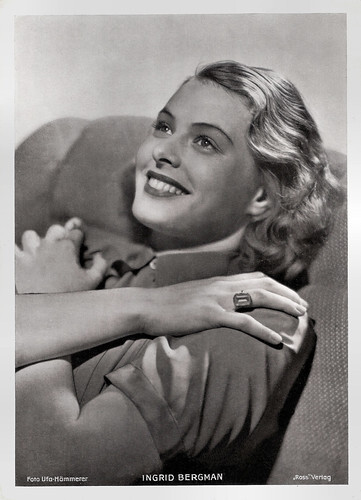
Big German card by Ross Verlag. Photo: Ufa / Hämmerer. Ingrid Bergman in Die vier Gesellen/The Four Companions (Carl Froelich, 1938).
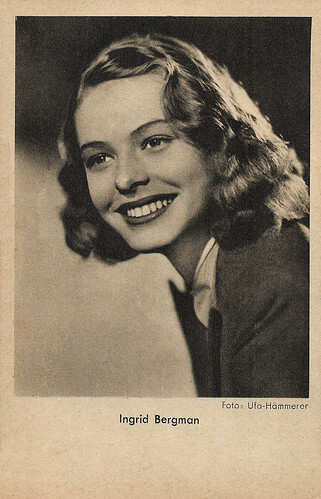
German postcard. Photo: Ufa / Hämmerer. Ingrid Bergman in Die vier Gesellen/The Four Companions (Carl Froelich, 1938).
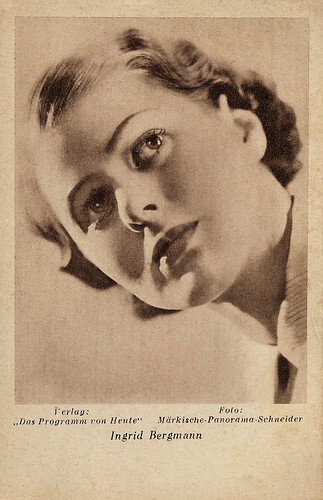
German postcard by Das Programm von Heute, Berlin. Photo: Märkische / Panorama / Schneider.
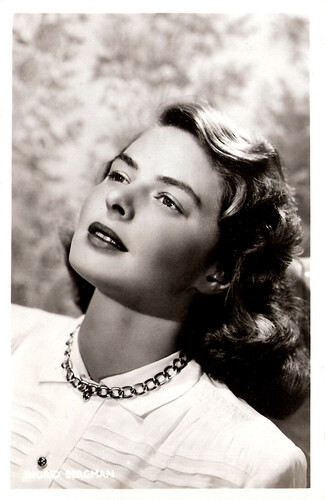
Dutch postcard.
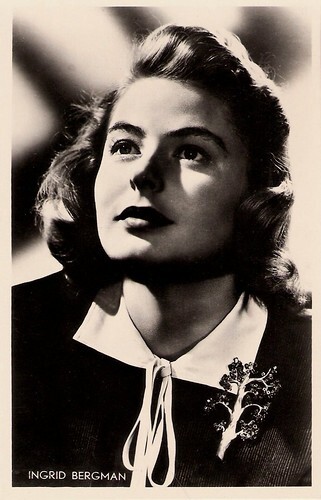
Dutch postcard by S. & v. H., A. Photo: M.P.E.A.
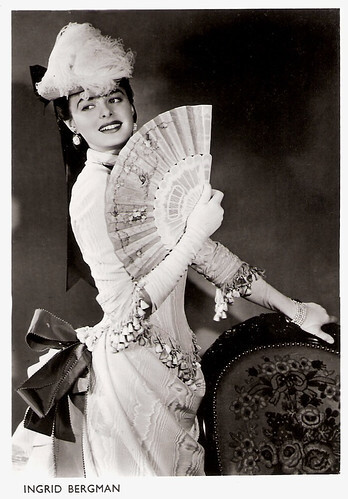
Dutch postcard by J. Sleding N.V., Amsterdam, no. 102/1250.
Intermezzo
Ingrid Bergman's breakthrough film was Intermezzo (Gustaf Molander, 1936), in which she played a pianist who has a love affair with a celebrated and married violinist, played by Gösta Ekman .
Hollywood producer David O. Selznick saw it and sent a representative from MGM to gain the rights to the story and have the actress signed to a contract. Ingrid went to California and starred in MGM's remake Intermezzo: A Love Story (Gregory Ratoff, 1939), reprising her original role.
The film was a hit and so was Ingrid. Her beauty was unlike anything the movie industry had seen before and her acting was superb. She was under contract to go back to Sweden to film Juninatten/A Night in June (Per Lindberg, 1940).
Back in the US, she appeared in three films, all well-received. In 1942 she played in only one film, but that film, Casablanca (Michael Curtiz, 1942), would make her a huge star. Bergman chose her roles well after Casablanca.
In 1943, she was nominated for an Academy Award for her role in Ernest Hemingway's For Whom the Bell Tolls (Sam Wood, 1943), the only film she made that year. The critics and public didn't forget her when she made Gaslight (George Cukor, 1944) the following year - her role as the persecuted wife of Charles Boyer got her the Oscar for Best Actress.
In 1945, Ingrid played in Spellbound (Alfred Hitchcock, 1945) with Gregory Peck, Saratoga Trunk (Sam Wood, 1945), and The Bells of St. Mary's (Leo McCarey, 1945), for which she received her third Oscar nomination for her part as Sister Benedict.
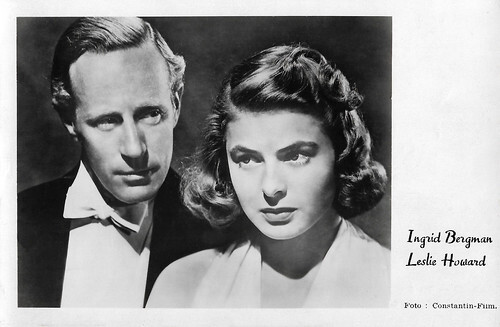
West German postcard by Schneider-Junior, Neunkirchen/Saar, no. 60. Photo: Constantin-Film. Ingrid Bergman and Leslie Howardin Intermezzo (Gregory Ratoff, 1939).
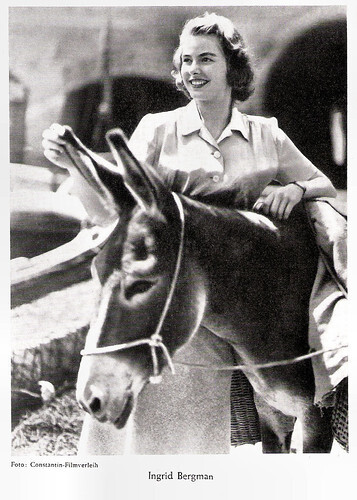
West-German collectors card. Photo: Constantin-Filmverleih / Selznick International Pictures. Ingrid Bergman in Intermezzo (Gregory Ratoff, 1939).
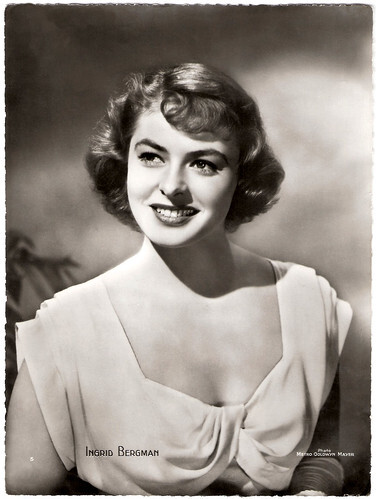
Big Belgian card by Chocolaterie Clovis, Pepinster. Photo: Metro Goldwyn Mayer.
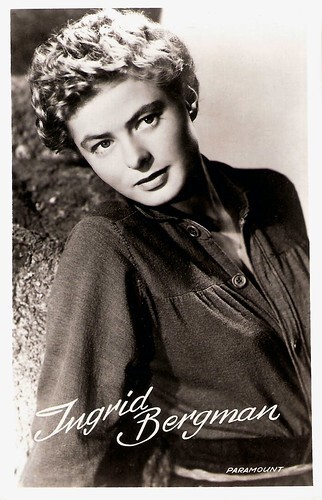
Dutch postcard. Photo: Paramount. Publicity still for For Whom the Bell Tolls (Sam Wood, 1943).
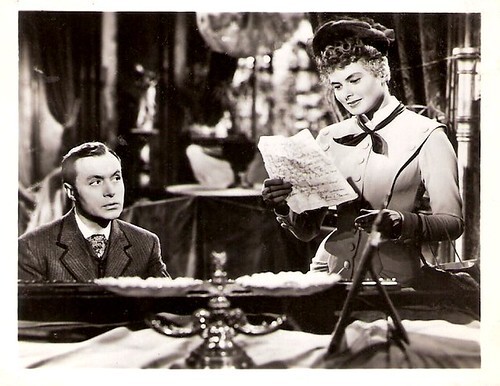
Small card. Photo: MGM. Photo: still from Gaslight (George Cukor, 1944) with Charles Boyer .
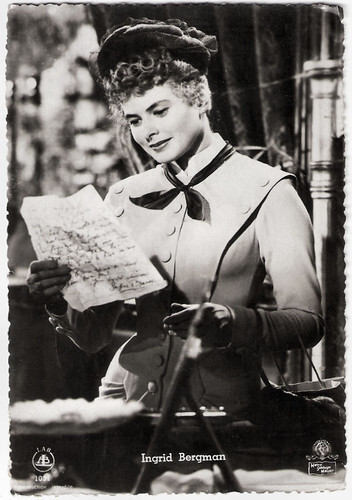
Belgian postcard by Les Editions d'Art L.A.B., Bruxelles, no. 1031. Photo: Metro-Goldwyn-Mayer. Ingrid Bergman in Gaslight (George Cukor, 1944).
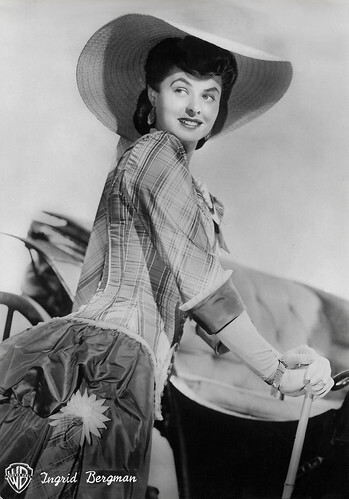
Italian postcard by Ediz. Garami / Rotalfoto, Milano, no. 21. Photo: Warner Bros. Ingrid Bergman in Saratoga Trunk (Sam Wood, 1945).
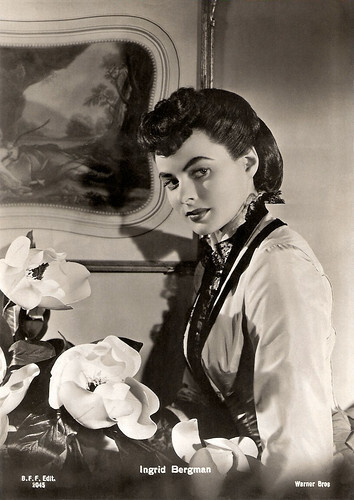
Italian postcard by Casa Editr. Ballerini & Fratini, Firenze, no. 2045. Photo: Warner Bros. Ingrid Bergman in Saratoga Trunk (Sam Wood, 1945).
Jeanne d'Arc
Ingrid Bergman also worked with Alfred Hitchcock on another classic, Notorious (1946) with Cary Grant , and the less successful Under Capricorn (1949) with Joseph Cotten .
Bergman went to Alaska during World War II in order to entertain troops. Soon after the war ended, she also went to Europe for the same purpose, where she was able to see the devastation caused by the war. It was during this time that she began a relationship with the famous photographer Robert Capa.
She made no films in 1947 but bounced back with a fourth nomination for Joan of Arc (Victor Fleming, 1948). She played the part of Jeanne d'Arc three times in her career: on stage in 1946 in Maxwell Anderson's Joan of Lorraine for which she won the Tony Award, in the film version in 1948, and in 1954 in the Italian film Giovanna d'Arco al rogo/Joan of Arc at the Stake (Roberto Rossellini, 1954), based on a 1935 dramatic oratorio by Arthur Honegger.
But in 1949 Saint Ingrid first would suffer a sudden and disastrous fall from grace.
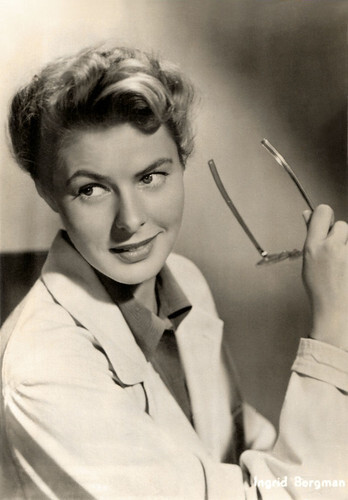
Dutch postcard by REB. Publicity still for Spellbound (Alfred Hitchcock, 1945).
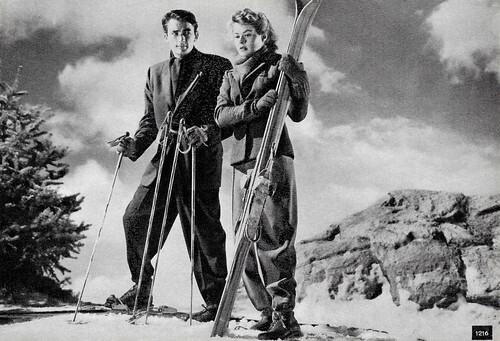
Italian postcard, no. 1216. Photo: United Artists. Gregory Peck and Ingrid Bergman in Spellbound (Alfred Hitchcock, 1945).
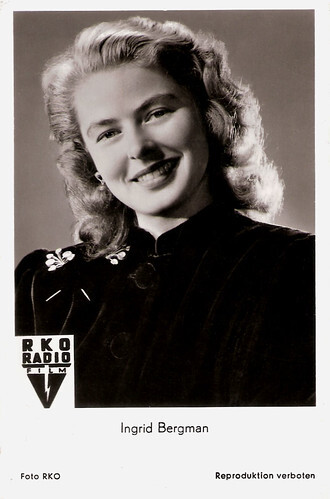
German postcard by Film-Postkartenverlag Hbg.-Bergedorf, no. 150. Photo: RKO. Publicity still for Notorious (Alfred Hitchcock, 1946).
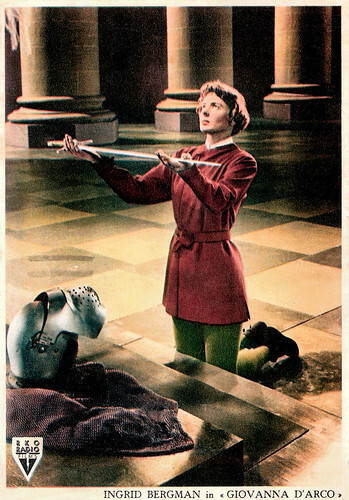
Italian postcard, no. 3161. Photo: R.K.O. Radio Pictures. Publicity still for Joan of Arc (Victor Fleming, 1948).
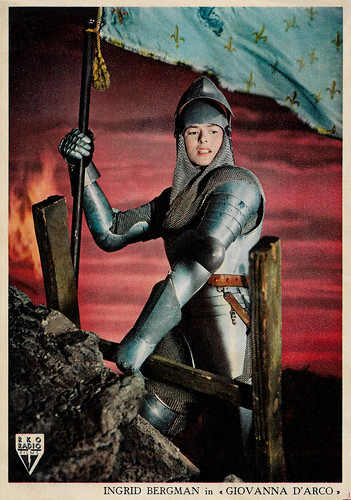
Italian postcard by Zincografica Fiorentina. Photo: RKO Radio Films. Ingrid Bergman in Joan of Arc (Victor Fleming, 1948).
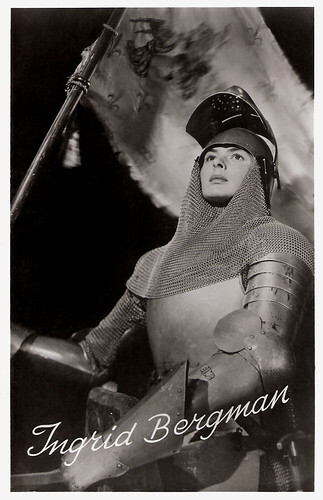
Dutch postcard, no. 3161. Photo: publicity still for Joan of Arc (Victor Fleming, 1948).
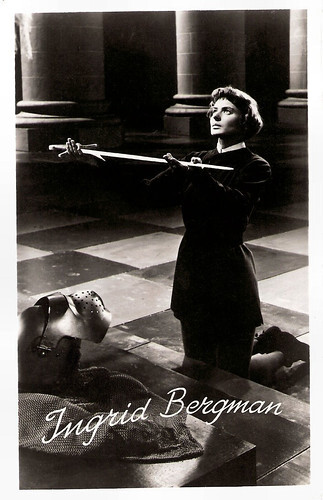
Dutch postcard. Photo: Paramount. Publicity still for Joan of Arc (1948).
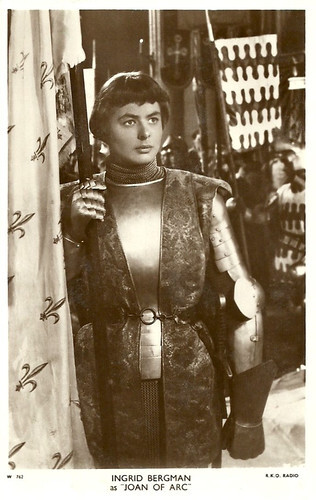
British postcard, no. W 762. Photo: R.K.O. Publicity still for Joan of Arc (1948).
Scandal
In 1949 Ingrid Bergman went to Italy to film Stromboli (1950), directed by Roberto Rossellini. She fell in love with him and got pregnant. The pregnancy caused a huge scandal in the United States. It even led to Bergman being denounced on the floor of the US Senate by Edwin C. Johnson, a Democratic senator, who referred to her as "a horrible example of womanhood and a powerful influence for evil." In addition, there was a floor vote, which resulted in her being made 'persona non grata'.
The scandal forced Ingrid Bergman to exile herself to Italy, leaving her husband, Dr. Petter Lindström, and daughter, Pia Lindström in the United States. Dr. Lindström eventually sued for desertion and waged a custody battle for their daughter.
In 1950 Bergman married Rossellini and the same year their son, Renato Roberto, was born. In 1952 Ingrid had twins, Isotta and Isabella Rossellini. Isabella would later become an outstanding actress in her own right, as did her halfsister Pia.
From 1950 to 1955 Bergman and Rossellini made six films together: Stromboli (1950), Europa '51/No Greater Love (1952), a segment of Siamo donne/We, the Women (1953), Viaggio in Italia/Voyage in Italy (1954), La paura/Fear (1954) and Giovanna d'Arco al rogo/Joan of Arc at the Stake (1954). These films were ahead of their time but were generally not received well, especially in the US, where many conservative political and religious leaders still raised a hue and cry about her past.
Bergman also starred in Jean Renoir 's Elena et les Hommes/Elena and Her Men (1956), a romantic comedy where she played a Polish princess caught in political intrigue. Although the film wasn't a success, it has since come to be regarded as one of her best performances.
Finally, after being exiled from Hollywood for seven years, Bergman returned opposite Yul Brynner in the title role in Anastasia (Anatole Litvak, 1956), which was filmed in England. For this, she won her second Academy Award. She had scarcely missed a beat. The award was accepted for her by her friend Cary Grant. Bergman would not make her first post-scandal public appearance in Hollywood until the 1958 Academy Awards when she was the presenter of the Academy Award for Best Picture. Furthermore, after being introduced by Cary Grant and walking out on stage to present, she was given a standing ovation.
In 1957 she had divorced Rosselini and in 1958 she married Lars Schmidt, a theatrical entrepreneur from a wealthy Swedish shipping family. After all the years she spent away from Hollywood, she still managed to maintain her status as a major star, as the success of films like Indiscreet (Stanley Donen, 1958) opposite Cary Grant and The Inn of the Sixth Happiness (Mark Robson, 1958) with Curd Jürgens showed.
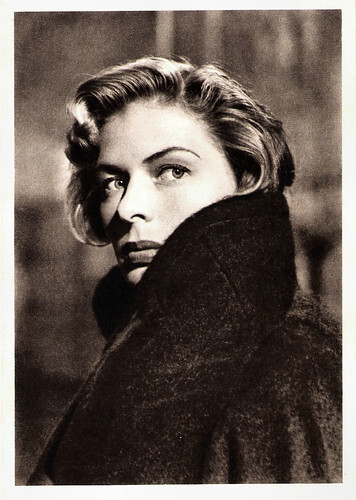
Italian postcard by Rotocalco Dagnino, Torino. Photo: Ponti-De Laurentiis / Lux Film. Ingrid Bergman in Europa 51 (Roberto Rossellini, 1952).
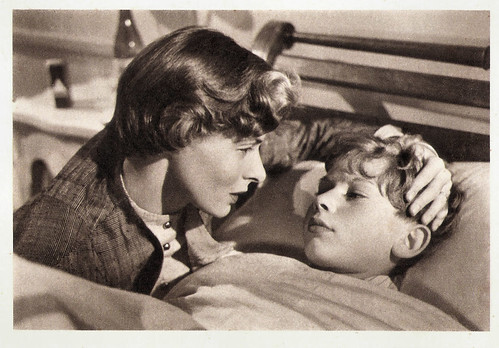
Italian postcard by Rotocalco Dagnino, Torino. Photo: LIF / Pont-De Laurentiis / Lux Film. Ingrid Bergman in Europa '51/No Greater Love (Roberto Rossellini, 1952).
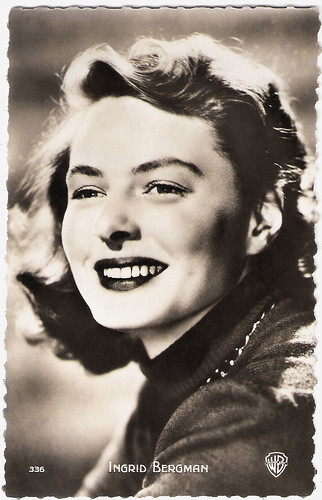
French postcard by Editions P.I., Paris, offered by Les Carbones Korès, no. 336. Photo: Warner Bros.
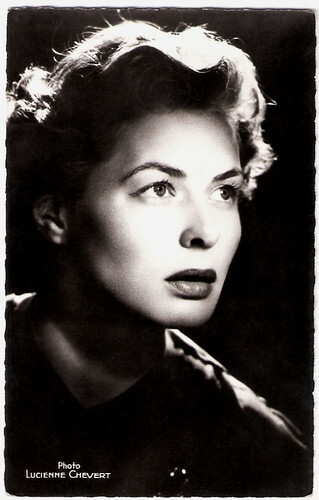
French postcard by Editions du Globe, Paris, no. 198. Photo: Lucienne Chevert.
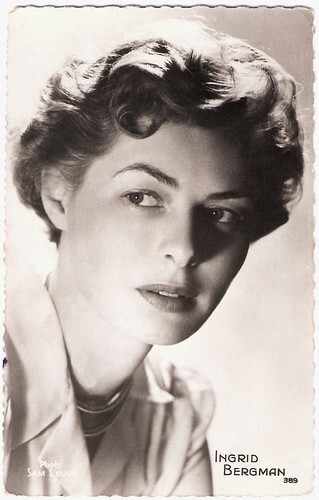
French postcard by Editions P.I., Paris, no. 389. Photo: Sam Lévin.
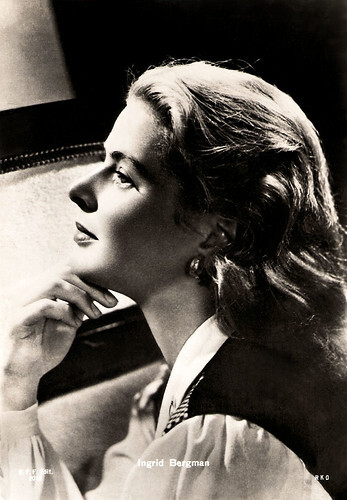
Italian postcard by casa Edite Ballerini & Fratini, Firenze, no. 2018. Photo: RKO.
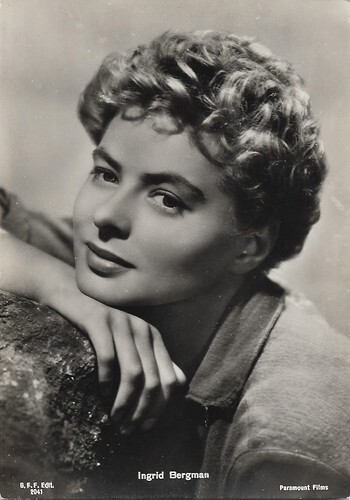
Italian postcard by B.F.F. Edit., no. 2041. Photo: Paramount Films.
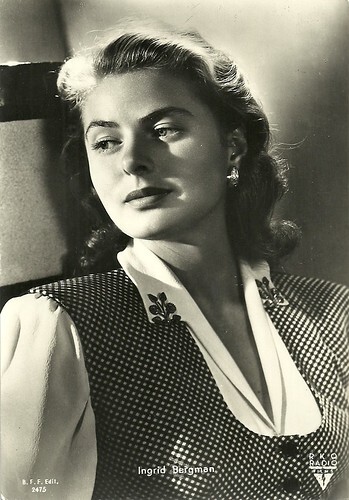
Italian postcard by B.F.F. Edit. (Casa Edite Ballerini & Fratini, Firenze), no. 2475. Photo: RKO Radio Films.
Emmy Award
In the 1960s, Ingrid Bergman concentrated on stage work and television appearances, collaborated with her husband, theatrical producer Lars Schmidt, in such TV plays as The Turn of The Screw (John Frankenheimer, 1960) for which she won an Emmy Award, and Twenty-Four Hours in a Woman's Life (Silvio Narrizano, 1961).
She didn't appear in as many films as she had before, but she continued to bounce between Europe and the US making films. After a long hiatus, Bergman appeared in Cactus Flower (Gene Saks, 1968), with Walter Matthau and Goldie Hawn. In 1972, Senator Charles H. Percy entered an apology into the Congressional Record for the attack made on Bergman 22 years earlier by Edwin C. Johnson.
Bergman won her third Academy Award for her role as Greta Ohlsson in Murder on the Orient Express (Sidney Lumet, 1974). Her performance is contained in a single scene: her interrogation by Poirot, captured in a single continuous take, nearly five minutes long. By 1975 Ingrid Bergman was divorced again.
In her final big-screen performance in Höstsonaten/Autumn Sonata (Ingmar Bergman, 1978) she had her seventh Academy Award nomination. Bergman plays in this film a celebrity pianist who returns to Sweden to visit her neglected daughter, played by Liv Ullmann . Though she didn't win the Oscar, many felt it was the best performance of her career.
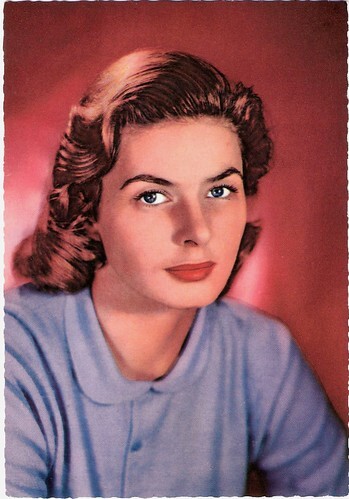
German postcard by ISV, no. A 58. Photo: 20th Century Fox. Publicity still for Anastasia (Anatole Litvak, 1956).
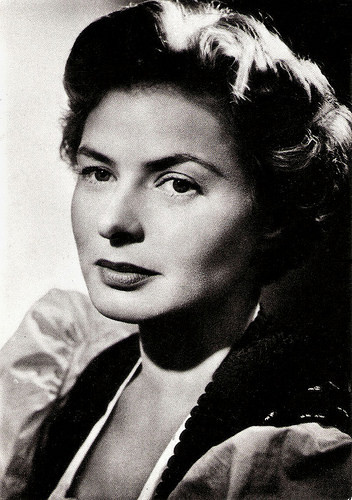
French postcard by Editions P.I. Paris, no. FK 1585. Photo: Lars Looschen.
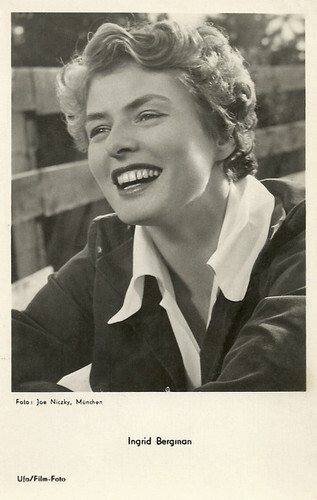
German postcard by Ufa/Film-Foto. Photo: Joe Niczky, Munich.
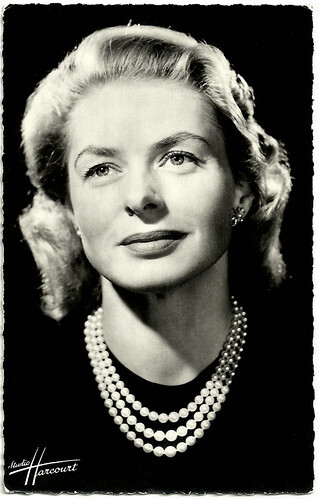
French postcard by Editions du Globe, Paris. Photo: Studio Harcourt.
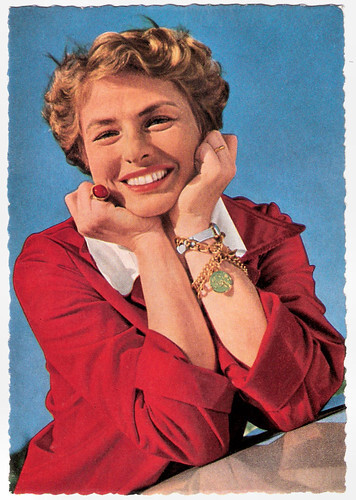
German postcard by WS-Druck, Wanne-Eickel, no. F 50. Photo: Joe Niczky.
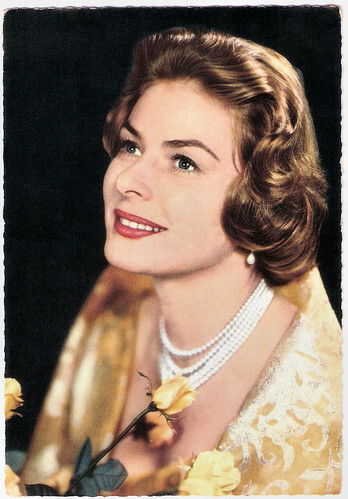
German postcard by ISV, no. H 21. Sent by mail in the Netherlands in 1962. Collection: Geoffrey Donaldson Institute.
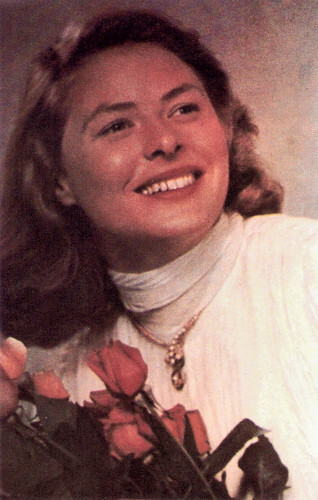
American postcard by Coral-Lee, Rancho Cordova, Ca., no. Personality 77.
As Time Goes By
In the late 1970s, Ingrid Bergman first discovered the symptoms of cancer and underwent a mastectomy. Her last role was in the television film A Woman Called Golda (Alan Gibson, 1982), about the late Israeli Prime Minister Golda Meir.
Ingrid Bergman died in 1982, in London, the day after having a small party with a few friends for her 67th birthday. At her burial a single violin played the song As Time Goes By, the theme from Casablanca, recalling her most famous role, that of Ilsa Lund.
That year her daughter, Pia Lindström accepted the Emmy Award as Best Actress that Ingrid won posthumously for A Woman Called Golda.
Seventeen years later, in 1999, she was ranked #4 in the American Film Institute's list of greatest female screen legends. Later she was ranked #5 in Premiere's list of 'The 50 Greatest Movie Stars of All Time'. Ingrid Bergman continues to be a cultural icon - for her films and for her innocent, natural beauty.

Romanian postcard by Casa Filmului Acin, no. 459. Ingrid Bergman and Yves Montand in Goodbye Again (Anatole Litvak, 1961).
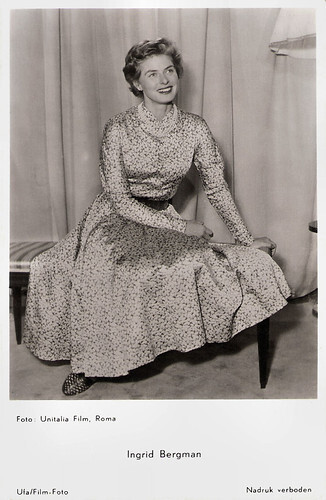
Dutch postcard by Gebr. Spanjersberg N.V., Rotterdam, no. 3480. Sent by mail in the Netherlands in 1963. Photo: Unitalia Film, Roma / Ufa. Collection: Geoffrey Donaldson Institute.
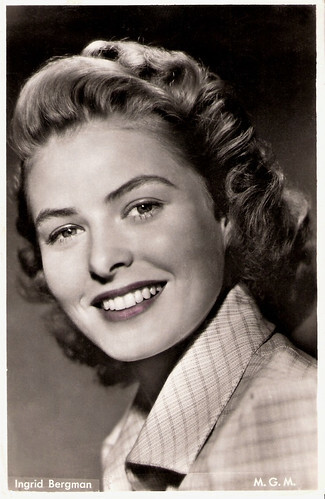
Dutch postcard by DRC/MEPA. Photo: MGM.
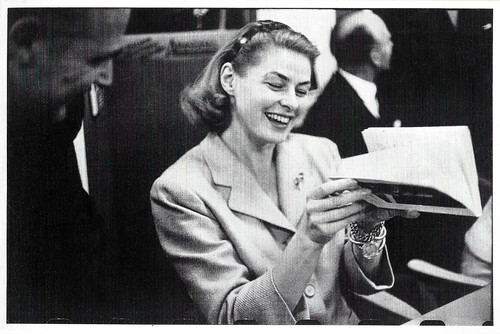
French postcard by Edition Connaissance du Tarn. Photo: Georges Fèvre, Paris.
Ingrid Bergman with Hans Söhnker in a scene from Die Vier Gesellen (1938). Source: Herweniel (YouTube). Sorry, no subtitles.
Recent trailer for Notorious (1946). Source: BFI.
Scene from Elena et les Hommes (1956) with Mel Ferrer. Source: Anmili (YouTube).
The original trailer in high definition of Höstsonaten/Autumn Sonata (1978) with Liv Ulmann . Source: (YouTube).
Sources: Denny Jackson, Naim81 and Ezio Flavio de Freitas (), Wikipedia, Hitchcock.tv, and .

Italian postcard by Garami, Milano. Photo: Warner Bros.

Vintage postcard by PE, no. 595. Photo: RKO Radio Pictures.

Dutch postcard, no. 15.

Dutch postcard, no. 3320. Photo: MGM (Metro-Goldwyn-Mayer).

Dutch postcard, no. 3031. Photo: RKO Radio Films.

West-German postcard by F.J. Rüdel, Filmpostkartenverlag. Hamburg-Bergedorf, no. 213. Photo: RKO. Ingrid Bergman in Notorious (Alfred Hitchcock, 1946).

Uruguayan postcard by CF. Photo: RKO Radio Films. Ingrid Bergman in Joan of Arc (Victor Fleming, 1948).
Summer Break
Ingrid Bergman was born in Stockholm, Sweden in 1915 to a Swedish father and a German mother.
At age 17, she had a taste of acting when she played an uncredited role of a girl standing in line in the Swedish film Landskamp (Gunnar Skoglund, 1932). The next year she was accepted to the Royal Dramatic Theatre in Stockholm, but she soon decided that stage acting was not for her.
During her first summer break, she was hired at a Swedish film studio to work in film full time. Her first film part was in Munkbrogreven/The Count of the Old Town (Edvin Adolphson, 1935), where she had a speaking part as Elsa Edlund.
In the following years, she made a dozen films in Sweden that established her as a class actress. Among them were Bränningar/The Surf (Ivar Johansson, 1935) and Dollar (Gustaf Mollander, 1938).
Another film, En kvinnas ansikte (Gustaf Molander, 1938) would later be remade as A Woman's Face with Joan Crawford . Bergman also made a film in Germany, Die Vier Gesellen/The Four Companions (Carl Froelich, 1938).

Dutch postcard by Takken / 't Sticht, Utrecht, no. 662. Photo: Svensk Filmindustri. Ingrid Bergman in Swedenhielms (Gustaf Molander, 1935).

Big German card by Ross Verlag. Photo: Ufa / Hämmerer. Ingrid Bergman in Die vier Gesellen/The Four Companions (Carl Froelich, 1938).

German postcard. Photo: Ufa / Hämmerer. Ingrid Bergman in Die vier Gesellen/The Four Companions (Carl Froelich, 1938).

German postcard by Das Programm von Heute, Berlin. Photo: Märkische / Panorama / Schneider.

Dutch postcard.

Dutch postcard by S. & v. H., A. Photo: M.P.E.A.

Dutch postcard by J. Sleding N.V., Amsterdam, no. 102/1250.
Intermezzo
Ingrid Bergman's breakthrough film was Intermezzo (Gustaf Molander, 1936), in which she played a pianist who has a love affair with a celebrated and married violinist, played by Gösta Ekman .
Hollywood producer David O. Selznick saw it and sent a representative from MGM to gain the rights to the story and have the actress signed to a contract. Ingrid went to California and starred in MGM's remake Intermezzo: A Love Story (Gregory Ratoff, 1939), reprising her original role.
The film was a hit and so was Ingrid. Her beauty was unlike anything the movie industry had seen before and her acting was superb. She was under contract to go back to Sweden to film Juninatten/A Night in June (Per Lindberg, 1940).
Back in the US, she appeared in three films, all well-received. In 1942 she played in only one film, but that film, Casablanca (Michael Curtiz, 1942), would make her a huge star. Bergman chose her roles well after Casablanca.
In 1943, she was nominated for an Academy Award for her role in Ernest Hemingway's For Whom the Bell Tolls (Sam Wood, 1943), the only film she made that year. The critics and public didn't forget her when she made Gaslight (George Cukor, 1944) the following year - her role as the persecuted wife of Charles Boyer got her the Oscar for Best Actress.
In 1945, Ingrid played in Spellbound (Alfred Hitchcock, 1945) with Gregory Peck, Saratoga Trunk (Sam Wood, 1945), and The Bells of St. Mary's (Leo McCarey, 1945), for which she received her third Oscar nomination for her part as Sister Benedict.

West German postcard by Schneider-Junior, Neunkirchen/Saar, no. 60. Photo: Constantin-Film. Ingrid Bergman and Leslie Howardin Intermezzo (Gregory Ratoff, 1939).

West-German collectors card. Photo: Constantin-Filmverleih / Selznick International Pictures. Ingrid Bergman in Intermezzo (Gregory Ratoff, 1939).

Big Belgian card by Chocolaterie Clovis, Pepinster. Photo: Metro Goldwyn Mayer.

Dutch postcard. Photo: Paramount. Publicity still for For Whom the Bell Tolls (Sam Wood, 1943).

Small card. Photo: MGM. Photo: still from Gaslight (George Cukor, 1944) with Charles Boyer .

Belgian postcard by Les Editions d'Art L.A.B., Bruxelles, no. 1031. Photo: Metro-Goldwyn-Mayer. Ingrid Bergman in Gaslight (George Cukor, 1944).

Italian postcard by Ediz. Garami / Rotalfoto, Milano, no. 21. Photo: Warner Bros. Ingrid Bergman in Saratoga Trunk (Sam Wood, 1945).

Italian postcard by Casa Editr. Ballerini & Fratini, Firenze, no. 2045. Photo: Warner Bros. Ingrid Bergman in Saratoga Trunk (Sam Wood, 1945).
Jeanne d'Arc
Ingrid Bergman also worked with Alfred Hitchcock on another classic, Notorious (1946) with Cary Grant , and the less successful Under Capricorn (1949) with Joseph Cotten .
Bergman went to Alaska during World War II in order to entertain troops. Soon after the war ended, she also went to Europe for the same purpose, where she was able to see the devastation caused by the war. It was during this time that she began a relationship with the famous photographer Robert Capa.
She made no films in 1947 but bounced back with a fourth nomination for Joan of Arc (Victor Fleming, 1948). She played the part of Jeanne d'Arc three times in her career: on stage in 1946 in Maxwell Anderson's Joan of Lorraine for which she won the Tony Award, in the film version in 1948, and in 1954 in the Italian film Giovanna d'Arco al rogo/Joan of Arc at the Stake (Roberto Rossellini, 1954), based on a 1935 dramatic oratorio by Arthur Honegger.
But in 1949 Saint Ingrid first would suffer a sudden and disastrous fall from grace.

Dutch postcard by REB. Publicity still for Spellbound (Alfred Hitchcock, 1945).

Italian postcard, no. 1216. Photo: United Artists. Gregory Peck and Ingrid Bergman in Spellbound (Alfred Hitchcock, 1945).

German postcard by Film-Postkartenverlag Hbg.-Bergedorf, no. 150. Photo: RKO. Publicity still for Notorious (Alfred Hitchcock, 1946).

Italian postcard, no. 3161. Photo: R.K.O. Radio Pictures. Publicity still for Joan of Arc (Victor Fleming, 1948).

Italian postcard by Zincografica Fiorentina. Photo: RKO Radio Films. Ingrid Bergman in Joan of Arc (Victor Fleming, 1948).

Dutch postcard, no. 3161. Photo: publicity still for Joan of Arc (Victor Fleming, 1948).

Dutch postcard. Photo: Paramount. Publicity still for Joan of Arc (1948).

British postcard, no. W 762. Photo: R.K.O. Publicity still for Joan of Arc (1948).
Scandal
In 1949 Ingrid Bergman went to Italy to film Stromboli (1950), directed by Roberto Rossellini. She fell in love with him and got pregnant. The pregnancy caused a huge scandal in the United States. It even led to Bergman being denounced on the floor of the US Senate by Edwin C. Johnson, a Democratic senator, who referred to her as "a horrible example of womanhood and a powerful influence for evil." In addition, there was a floor vote, which resulted in her being made 'persona non grata'.
The scandal forced Ingrid Bergman to exile herself to Italy, leaving her husband, Dr. Petter Lindström, and daughter, Pia Lindström in the United States. Dr. Lindström eventually sued for desertion and waged a custody battle for their daughter.
In 1950 Bergman married Rossellini and the same year their son, Renato Roberto, was born. In 1952 Ingrid had twins, Isotta and Isabella Rossellini. Isabella would later become an outstanding actress in her own right, as did her halfsister Pia.
From 1950 to 1955 Bergman and Rossellini made six films together: Stromboli (1950), Europa '51/No Greater Love (1952), a segment of Siamo donne/We, the Women (1953), Viaggio in Italia/Voyage in Italy (1954), La paura/Fear (1954) and Giovanna d'Arco al rogo/Joan of Arc at the Stake (1954). These films were ahead of their time but were generally not received well, especially in the US, where many conservative political and religious leaders still raised a hue and cry about her past.
Bergman also starred in Jean Renoir 's Elena et les Hommes/Elena and Her Men (1956), a romantic comedy where she played a Polish princess caught in political intrigue. Although the film wasn't a success, it has since come to be regarded as one of her best performances.
Finally, after being exiled from Hollywood for seven years, Bergman returned opposite Yul Brynner in the title role in Anastasia (Anatole Litvak, 1956), which was filmed in England. For this, she won her second Academy Award. She had scarcely missed a beat. The award was accepted for her by her friend Cary Grant. Bergman would not make her first post-scandal public appearance in Hollywood until the 1958 Academy Awards when she was the presenter of the Academy Award for Best Picture. Furthermore, after being introduced by Cary Grant and walking out on stage to present, she was given a standing ovation.
In 1957 she had divorced Rosselini and in 1958 she married Lars Schmidt, a theatrical entrepreneur from a wealthy Swedish shipping family. After all the years she spent away from Hollywood, she still managed to maintain her status as a major star, as the success of films like Indiscreet (Stanley Donen, 1958) opposite Cary Grant and The Inn of the Sixth Happiness (Mark Robson, 1958) with Curd Jürgens showed.

Italian postcard by Rotocalco Dagnino, Torino. Photo: Ponti-De Laurentiis / Lux Film. Ingrid Bergman in Europa 51 (Roberto Rossellini, 1952).

Italian postcard by Rotocalco Dagnino, Torino. Photo: LIF / Pont-De Laurentiis / Lux Film. Ingrid Bergman in Europa '51/No Greater Love (Roberto Rossellini, 1952).

French postcard by Editions P.I., Paris, offered by Les Carbones Korès, no. 336. Photo: Warner Bros.

French postcard by Editions du Globe, Paris, no. 198. Photo: Lucienne Chevert.

French postcard by Editions P.I., Paris, no. 389. Photo: Sam Lévin.

Italian postcard by casa Edite Ballerini & Fratini, Firenze, no. 2018. Photo: RKO.

Italian postcard by B.F.F. Edit., no. 2041. Photo: Paramount Films.

Italian postcard by B.F.F. Edit. (Casa Edite Ballerini & Fratini, Firenze), no. 2475. Photo: RKO Radio Films.
Emmy Award
In the 1960s, Ingrid Bergman concentrated on stage work and television appearances, collaborated with her husband, theatrical producer Lars Schmidt, in such TV plays as The Turn of The Screw (John Frankenheimer, 1960) for which she won an Emmy Award, and Twenty-Four Hours in a Woman's Life (Silvio Narrizano, 1961).
She didn't appear in as many films as she had before, but she continued to bounce between Europe and the US making films. After a long hiatus, Bergman appeared in Cactus Flower (Gene Saks, 1968), with Walter Matthau and Goldie Hawn. In 1972, Senator Charles H. Percy entered an apology into the Congressional Record for the attack made on Bergman 22 years earlier by Edwin C. Johnson.
Bergman won her third Academy Award for her role as Greta Ohlsson in Murder on the Orient Express (Sidney Lumet, 1974). Her performance is contained in a single scene: her interrogation by Poirot, captured in a single continuous take, nearly five minutes long. By 1975 Ingrid Bergman was divorced again.
In her final big-screen performance in Höstsonaten/Autumn Sonata (Ingmar Bergman, 1978) she had her seventh Academy Award nomination. Bergman plays in this film a celebrity pianist who returns to Sweden to visit her neglected daughter, played by Liv Ullmann . Though she didn't win the Oscar, many felt it was the best performance of her career.

German postcard by ISV, no. A 58. Photo: 20th Century Fox. Publicity still for Anastasia (Anatole Litvak, 1956).

French postcard by Editions P.I. Paris, no. FK 1585. Photo: Lars Looschen.

German postcard by Ufa/Film-Foto. Photo: Joe Niczky, Munich.

French postcard by Editions du Globe, Paris. Photo: Studio Harcourt.

German postcard by WS-Druck, Wanne-Eickel, no. F 50. Photo: Joe Niczky.

German postcard by ISV, no. H 21. Sent by mail in the Netherlands in 1962. Collection: Geoffrey Donaldson Institute.

American postcard by Coral-Lee, Rancho Cordova, Ca., no. Personality 77.
As Time Goes By
In the late 1970s, Ingrid Bergman first discovered the symptoms of cancer and underwent a mastectomy. Her last role was in the television film A Woman Called Golda (Alan Gibson, 1982), about the late Israeli Prime Minister Golda Meir.
Ingrid Bergman died in 1982, in London, the day after having a small party with a few friends for her 67th birthday. At her burial a single violin played the song As Time Goes By, the theme from Casablanca, recalling her most famous role, that of Ilsa Lund.
That year her daughter, Pia Lindström accepted the Emmy Award as Best Actress that Ingrid won posthumously for A Woman Called Golda.
Seventeen years later, in 1999, she was ranked #4 in the American Film Institute's list of greatest female screen legends. Later she was ranked #5 in Premiere's list of 'The 50 Greatest Movie Stars of All Time'. Ingrid Bergman continues to be a cultural icon - for her films and for her innocent, natural beauty.

Romanian postcard by Casa Filmului Acin, no. 459. Ingrid Bergman and Yves Montand in Goodbye Again (Anatole Litvak, 1961).

Dutch postcard by Gebr. Spanjersberg N.V., Rotterdam, no. 3480. Sent by mail in the Netherlands in 1963. Photo: Unitalia Film, Roma / Ufa. Collection: Geoffrey Donaldson Institute.

Dutch postcard by DRC/MEPA. Photo: MGM.

French postcard by Edition Connaissance du Tarn. Photo: Georges Fèvre, Paris.
Ingrid Bergman with Hans Söhnker in a scene from Die Vier Gesellen (1938). Source: Herweniel (YouTube). Sorry, no subtitles.
Recent trailer for Notorious (1946). Source: BFI.
Scene from Elena et les Hommes (1956) with Mel Ferrer. Source: Anmili (YouTube).
The original trailer in high definition of Höstsonaten/Autumn Sonata (1978) with Liv Ulmann . Source: (YouTube).
Sources: Denny Jackson, Naim81 and Ezio Flavio de Freitas (), Wikipedia, Hitchcock.tv, and .
Published on December 21, 2022 22:00
December 20, 2022
Jack Lemmon
Versatile and beloved American actor Jack Lemmon (1925-2001) was a virtuoso in both comedy and drama. He initially acted on TV before moving to Hollywood, cultivating a career that would span decades. Lemmon starred in over 60 films including Some Like It Hot (1959), The Apartment (1960), Irma la Douce (1963), The Odd Couple (1968), Save the Tiger (1973) and Grumpy Old Men (1993). Some of his most beloved performances stemmed from his collaborations with acclaimed director Billy Wilder and with his fellow friend and actor Walter Matthau.
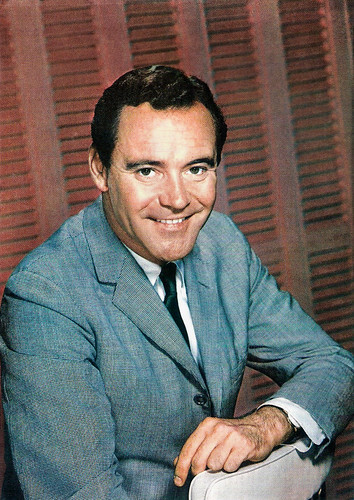
Italian postcard by Rotalcolor /Rotalfoto, Milano, no. N. 177.
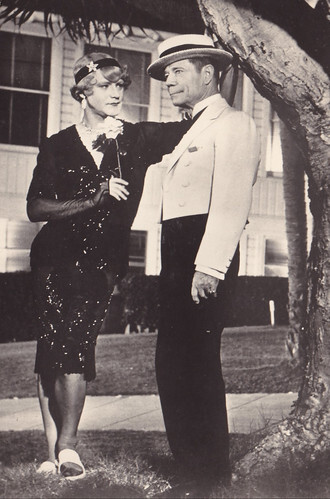
Czech postcard by Pressfoto, Praha (Prague). Photo: Jack Lemmon and Joe E. Brown in Some Like it Hot (Billy Wilder, 1959). Collection: Carla Bosch.

Big East-German card by VEB Progress Film-Verleih, Berlin, no. 1020. Jack Lemmon and Marcello Mastroianni in Maccheroni/Macaroni (Ettore Scola, 1985).
Some like it hot
Jack Lemmon was born John Uhler Lemmon III in 1925, in an elevator at Newton-Wellesley Hospital in Newton, Massachusetts, a suburb of Boston. He was the only child of Mildred Lankford Noel and John Uhler Lemmon, Jr., the president of a doughnut company. He later described his flamboyant, authoritarian mother as 'Tallulah Bankhead on a roadshow.' He laughed about how she used to hang out with her girlfriends at the Ritz Bar in Boston and how she tried to have her cremation ashes placed on the bar (the management refused).
Jack attended Ward Elementary near his Newton, MA home. At age 9 he was sent to Rivers Country Day School, then located in nearby Brookline. After RCDS, he went to high school at Phillips Andover Academy. Lemmon attended Harvard, where he became president of the Hasty Pudding Club, the university's famous acting club. During WW II, he served in the Naval Reserve and was the communications officer aboard the aircraft carrier USS Lake Champlain CV-39.
After serving as a Navy ensign, he worked in a beer hall playing the piano. Then, Lemmon followed his passion for theatre. His father didn't approve of his son taking up acting, but told him he should continue with it only as long as he felt passion for it. Soon, Jack landed small roles on radio, off-Broadway, TV and Broadway. In 1953, he was very successful on Broadway with 'Room Service', after which he went to Hollywood.
He signed a contract with Columbia Pictures. His film debut was opposite Judy Holliday in the romantic comedy It Should Happen to You (George Cukor, 1954). He was loaned to Warner Bros. in 1955 for his fourth film. There, he had his breakthrough as Ensign Pulver in the war drama Mister Roberts (John Ford, Mervyn LeRoy, 1955) starring Henry Fonda and James Cagney . His complex portrayal of this somewhat dishonest but sensitive character earned him the Academy Award for Best Supporting Actor.
Lemmon would go on to work on a number of films with comedian and close friend Ernie Kovacs, including Bell Book and Candle (Richard Quine, 1958) starring James Stewart and Kim Novak . In 1959, Lemmon gave one of the top comedic performances of his career when he starred alongside Tony Curtis and Marilyn Monroe in the romantic comedy Some Like It Hot (Billy Wilder, 1959). He received an Oscar nomination for his role and he did the next year, for The Appartement (Billy Wilder, (1960) in which he co-starred with Shirley MacLaine. This led to several more collaborations with director Billy Wilder and great success on the big screen throughout the 1960s and 1970s.
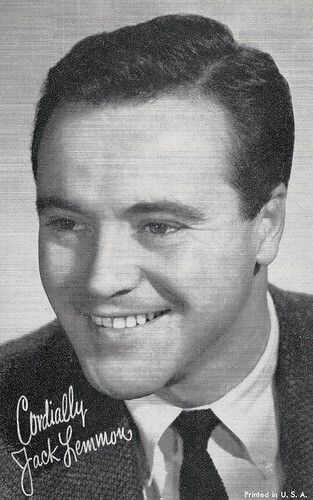
American card. Caption: Cordially Jack Lemmon.
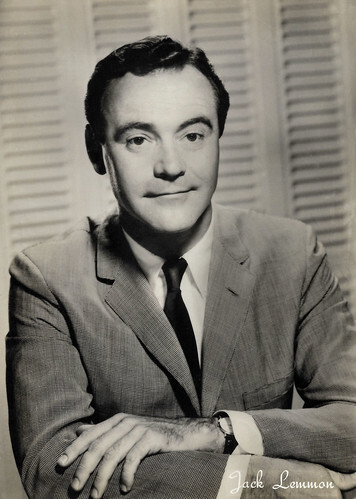
Italian postcard by Rotalfoto, Milano, no. 1124. Photo: Warner Bros.
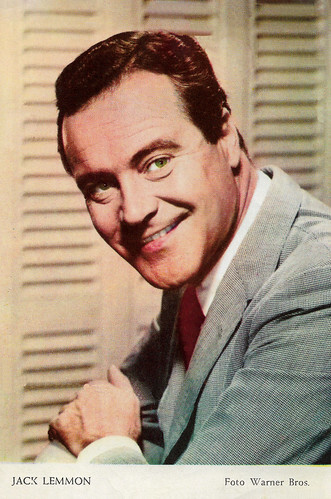
Vintage card. Photo: Warner Bros.
America's everyman
Jack Lemmon also excelled in drama. He received an Oscar nomination for his role as an alcoholic in Days of Wine and Roses (Blake Edwards, 1962) and later followed more nominations for the dramas The China Syndrome (James Bridges, 1979), Tribute (Bob Clark, 1980) and Missing (Costa-Gravas, 1982). Kyle Perez at IMDb : "Sometimes referred to as "America's Everyman", Lemmon's versatility as an actor helped the audience more closely identify and relate to him. He was able always to elicit a laugh or sympathy from his viewers and his charismatic presence always shined on the big screen. He often portrayed the quintessence of an aspiring man and established a lasting impression on the film industry."
Lemmon reunited with Shirley MacLaine in another Wilder film, Irma la Douce (Billy Wilder, 1963). It was one of the biggest commercial successes for the trio. The Fortune Cookie (Billy Wilder, 1966) served as the start of a comedic partnership between Lemmon and Walter Matthau and the two would come together again, two years later, for The Odd Couple (Gene Saks, 1968), based on a play by Neil Simon. It is one of their most endearing films together.
As the 1970s came around, Lemmon began to undertake more dramatic roles and won the Academy Award for Best Actor for his performance as Harry Stoner in Save the Tiger (John G. Avildsen, 1973). Lemmon admitted to having had a serious drinking problem at one time, which is one reason he looked back on his Oscar-winning role as perhaps the most gratifying, emotionally fulfilling performance of his career. Throughout the 1980s and 1990s, Lemmon continued to excel in his character performances and earned the Cannes Best Actor award for The China Syndrome (James Bridges, 1979) and Missing (Costa-Gravas, 1982). As a director, he made his film debut with Kotch (Jack Lemmon, 1971) and his Broadway debut with Eugene O'Neill's 'Long Day's Journey into Night'.
In 1988 he received the Life Achievement Award from the American Film Institute. In the 1990s, he continued to have success with roles in films such as Glengarry Glen Ross (James Foley, 1992) and Short Cuts (Robert Altman, 1993). In the comedy Grumpy Old Men (Donald Petrie, 1993), he was reunited with Walter Matthau. The film was a huge success, and a sequel was even released in 1995. A sequel to The Odd Couple was also released in 1998. In 1997, he received a Golden Globe nomination for the television adaptation of 12 Angry Men (William Friedkin, 1997).
Jack Lemmon was married twice, first to actress Cynthia Stone (1950-1956) and his second marriage to actress Felicia Farr lasted from 1972 till his death. Jack Lemmon passed away in 2001 in Los Angeles at the age of 76. He had two children, Chris Lemmon (1954) and Courtney Lemmon (1966). Actress Sydney Lemmon is his granddaughter.
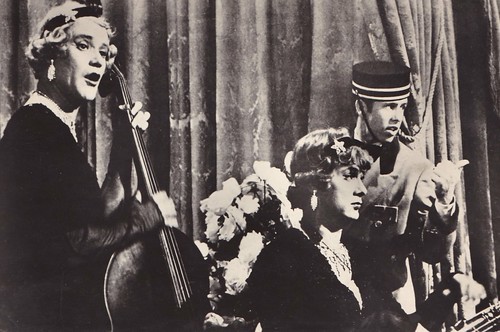
Czech postcard by Pressfoto, Praha (Prague). Photo: Jack Lemmon and Tony Curtis in Some Like it Hot (Billy Wilder, 1959). Collection: Carla Bosch.

Big East-German card by VEB Progress Film-Vertrieb, Berlin, no. 65/72,1972. Jack Lemmon and Judi West in The Fortune Cookie (Billy Wilder, 1966).
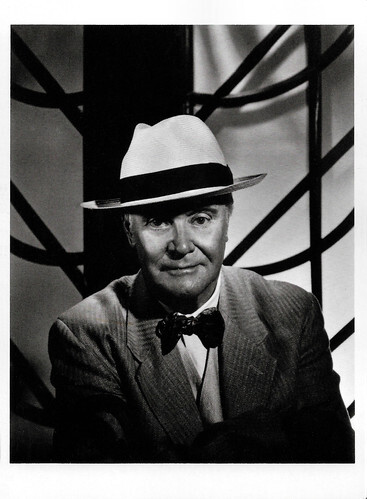
American postcard by Fotofolio, New York, N.Y. no. F 323. Photo: Len Prince. Caption: Jack Lemmon, Hollywood, 1995.
Sources: (IMDb), (IMDb), Wikipedia (Dutch) and .

Italian postcard by Rotalcolor /Rotalfoto, Milano, no. N. 177.

Czech postcard by Pressfoto, Praha (Prague). Photo: Jack Lemmon and Joe E. Brown in Some Like it Hot (Billy Wilder, 1959). Collection: Carla Bosch.

Big East-German card by VEB Progress Film-Verleih, Berlin, no. 1020. Jack Lemmon and Marcello Mastroianni in Maccheroni/Macaroni (Ettore Scola, 1985).
Some like it hot
Jack Lemmon was born John Uhler Lemmon III in 1925, in an elevator at Newton-Wellesley Hospital in Newton, Massachusetts, a suburb of Boston. He was the only child of Mildred Lankford Noel and John Uhler Lemmon, Jr., the president of a doughnut company. He later described his flamboyant, authoritarian mother as 'Tallulah Bankhead on a roadshow.' He laughed about how she used to hang out with her girlfriends at the Ritz Bar in Boston and how she tried to have her cremation ashes placed on the bar (the management refused).
Jack attended Ward Elementary near his Newton, MA home. At age 9 he was sent to Rivers Country Day School, then located in nearby Brookline. After RCDS, he went to high school at Phillips Andover Academy. Lemmon attended Harvard, where he became president of the Hasty Pudding Club, the university's famous acting club. During WW II, he served in the Naval Reserve and was the communications officer aboard the aircraft carrier USS Lake Champlain CV-39.
After serving as a Navy ensign, he worked in a beer hall playing the piano. Then, Lemmon followed his passion for theatre. His father didn't approve of his son taking up acting, but told him he should continue with it only as long as he felt passion for it. Soon, Jack landed small roles on radio, off-Broadway, TV and Broadway. In 1953, he was very successful on Broadway with 'Room Service', after which he went to Hollywood.
He signed a contract with Columbia Pictures. His film debut was opposite Judy Holliday in the romantic comedy It Should Happen to You (George Cukor, 1954). He was loaned to Warner Bros. in 1955 for his fourth film. There, he had his breakthrough as Ensign Pulver in the war drama Mister Roberts (John Ford, Mervyn LeRoy, 1955) starring Henry Fonda and James Cagney . His complex portrayal of this somewhat dishonest but sensitive character earned him the Academy Award for Best Supporting Actor.
Lemmon would go on to work on a number of films with comedian and close friend Ernie Kovacs, including Bell Book and Candle (Richard Quine, 1958) starring James Stewart and Kim Novak . In 1959, Lemmon gave one of the top comedic performances of his career when he starred alongside Tony Curtis and Marilyn Monroe in the romantic comedy Some Like It Hot (Billy Wilder, 1959). He received an Oscar nomination for his role and he did the next year, for The Appartement (Billy Wilder, (1960) in which he co-starred with Shirley MacLaine. This led to several more collaborations with director Billy Wilder and great success on the big screen throughout the 1960s and 1970s.

American card. Caption: Cordially Jack Lemmon.

Italian postcard by Rotalfoto, Milano, no. 1124. Photo: Warner Bros.

Vintage card. Photo: Warner Bros.
America's everyman
Jack Lemmon also excelled in drama. He received an Oscar nomination for his role as an alcoholic in Days of Wine and Roses (Blake Edwards, 1962) and later followed more nominations for the dramas The China Syndrome (James Bridges, 1979), Tribute (Bob Clark, 1980) and Missing (Costa-Gravas, 1982). Kyle Perez at IMDb : "Sometimes referred to as "America's Everyman", Lemmon's versatility as an actor helped the audience more closely identify and relate to him. He was able always to elicit a laugh or sympathy from his viewers and his charismatic presence always shined on the big screen. He often portrayed the quintessence of an aspiring man and established a lasting impression on the film industry."
Lemmon reunited with Shirley MacLaine in another Wilder film, Irma la Douce (Billy Wilder, 1963). It was one of the biggest commercial successes for the trio. The Fortune Cookie (Billy Wilder, 1966) served as the start of a comedic partnership between Lemmon and Walter Matthau and the two would come together again, two years later, for The Odd Couple (Gene Saks, 1968), based on a play by Neil Simon. It is one of their most endearing films together.
As the 1970s came around, Lemmon began to undertake more dramatic roles and won the Academy Award for Best Actor for his performance as Harry Stoner in Save the Tiger (John G. Avildsen, 1973). Lemmon admitted to having had a serious drinking problem at one time, which is one reason he looked back on his Oscar-winning role as perhaps the most gratifying, emotionally fulfilling performance of his career. Throughout the 1980s and 1990s, Lemmon continued to excel in his character performances and earned the Cannes Best Actor award for The China Syndrome (James Bridges, 1979) and Missing (Costa-Gravas, 1982). As a director, he made his film debut with Kotch (Jack Lemmon, 1971) and his Broadway debut with Eugene O'Neill's 'Long Day's Journey into Night'.
In 1988 he received the Life Achievement Award from the American Film Institute. In the 1990s, he continued to have success with roles in films such as Glengarry Glen Ross (James Foley, 1992) and Short Cuts (Robert Altman, 1993). In the comedy Grumpy Old Men (Donald Petrie, 1993), he was reunited with Walter Matthau. The film was a huge success, and a sequel was even released in 1995. A sequel to The Odd Couple was also released in 1998. In 1997, he received a Golden Globe nomination for the television adaptation of 12 Angry Men (William Friedkin, 1997).
Jack Lemmon was married twice, first to actress Cynthia Stone (1950-1956) and his second marriage to actress Felicia Farr lasted from 1972 till his death. Jack Lemmon passed away in 2001 in Los Angeles at the age of 76. He had two children, Chris Lemmon (1954) and Courtney Lemmon (1966). Actress Sydney Lemmon is his granddaughter.

Czech postcard by Pressfoto, Praha (Prague). Photo: Jack Lemmon and Tony Curtis in Some Like it Hot (Billy Wilder, 1959). Collection: Carla Bosch.

Big East-German card by VEB Progress Film-Vertrieb, Berlin, no. 65/72,1972. Jack Lemmon and Judi West in The Fortune Cookie (Billy Wilder, 1966).

American postcard by Fotofolio, New York, N.Y. no. F 323. Photo: Len Prince. Caption: Jack Lemmon, Hollywood, 1995.
Sources: (IMDb), (IMDb), Wikipedia (Dutch) and .
Published on December 20, 2022 22:00
December 19, 2022
Lia Eibenschütz
Lia Eibenschütz (1899-1985) was an attractive German singer, pianist and film actress who peaked in the German silent cinema during the 1920s. She often appeared as the enamoured young woman or elegant socialite in romantic melodramas and comedies. Her career declined in the sound era and the Nazis banned her from performing because of her half-Jewish ancestry.
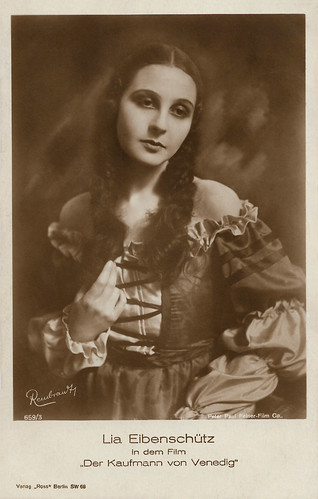
German postcard by Ross Verlag, Berlin, no. 659/3. Photo: Rembrandt / Peter Paul Felner-Film Co. Lia Eibenschütz as Jessica in Der Kaufmann von Venedig/The Merchant of Venice (Peter Paul Felner, 1923).
French postcard by Cinémagazine-Edition, no. 527. Lia Eibenschütz in Paname...n'est pas Paris/Die Apachen von Paris (Nikolai Malikoff, 1927).

German postcard by Ross Verlag, no. 1952/1, 1927-1928. Photo: Ufa.
Discovered during a concert tour
Lia (or Lya) Eibenschütz was born Lina Mathilde Eibenschütz in 1899 in Wiesbaden, Hesse, Germany. She had Austro-Hungarian ancestors. Her father, Albert Maria Eibenschütz was a pianist and conductor, and her mother, Wilhelmine Marianne Eibenschütz-Wnuczek was also a successful pianist.
So it was not surprising that daughter Lia also studied music and worked as a singer and pianist. She was discovered as an actress in Berlin in 1919 during a concert tour. She debuted on-screen in the leading role of Der Tempel der Liebe/The Temple of Love (Paul Ludwig Stein, 1919). In the 1920s, she could be seen in numerous silent films, often as the enamoured young woman or elegant socialite. She played Baroness Edda von Gerding in Die große und die kleine Welt (Max Mack, 1921), and Countess Polignac in the biopic Marie Antoinette - Das Leben einer Königin (Rudolf Meinert, 1922) with Diana Karenne in the title role.
Other memorable parts she had in Nathan der Weise/Nathan the Wise (Manfred Noa, 1922) starring Werner Krauss and based on the play by Gotthold Ephraim Lessing, the tragicomedy Der Puppenmacher von Kiang-Ning/The Doll Maker of Kiang-Ning (Robert Wiene, 1923) again with Krauss, and the William Shakespeare adaptation Der Kaufmann von Venedig/The Merchant of Venice (Peter Paul Felner, 1923) starring Henny Porten as the rich Portia, Werner Krauss as Shylock, and Harry Liedtke as Bassanio. Eibenschütz played Shylock's daughter Jessica.
She also starred in Die Dame aus Berlin/The Lady of Berlin (Lorand von Kabdebo, 1925) again with Krauss, and (Nikolai Malikoff, 1927) with Jaque Catelain and Ruth Weyher . The latter was a Franco-German co-production, distributed by Ufa. According to Cinémagazine, a fire broke out on Thursday 31 July 1927 in the editing room of the G. M. Film factory in Billancourt, where the film was being developed. As the film had just been finished, the producers decided to re-shoot the film completely.
Lia Eibenschütz was also the leading lady in the early sound film Der Korvettenkapitän/The Corvette Captain (Rudolf Walther-Fein, 1930), a romantic comedy in the Navy with Harry Liedtke , Maria Paudler and Fritz Kampers. But from the early 1930s onward her parts became smaller.
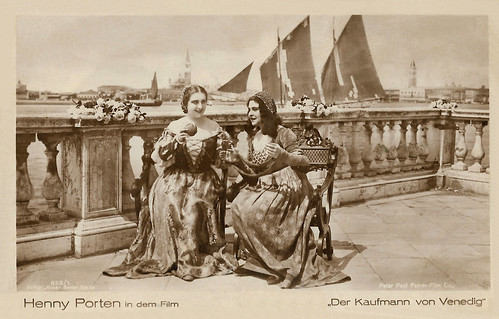
German postcard by Ross Verlag, no. 658/1. Photo: Peter Paul Felner-Film Co. Henny Porten and Lia Eibenschütz in Der Kaufmann von Venedig/The Merchant of Venice (Peter Paul Felner, 1923).
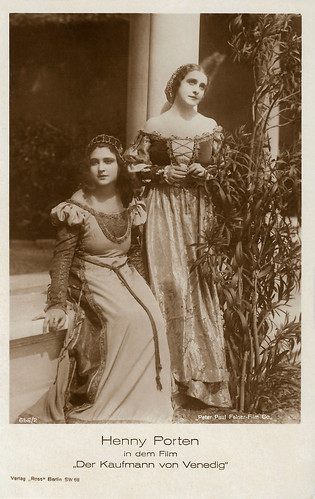
German postcard by Ross Verlag, Berlin, no. 658/2. Photo: Rembrandt / Peter Paul Felner-Film Co. Henny Porten as Porzia and Lia Eibenschütz as Jessica in Der Kaufmann von Venedig/The Merchant of Venice (Peter Paul Felner, 1923).
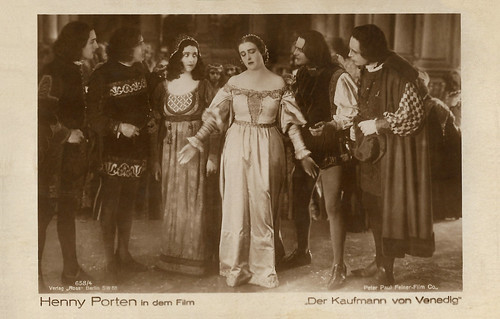
German postcard by Ross Verlag, no. 658/4. Photo: Peter Paul Felner-Film Co. Publicity still for Der Kaufmann von Venedig/The Merchant of Venice (Peter Paul Felner, 1923). Henny Porten as Porzia/Portia and Lia Eibenschütz as Jessica. The man far right is Carl Ebert (Antonio).
Women of the world
Lia Eibenschütz also worked on the Berlin stage, often performing women of the world. After she married actor Kurt Vespermann in 1927, she retired more and more into private life in the 1930s. She was last seen on stage at the famous Berlin Kabarett der Komiker in the 1932/1933 season. She quitted the sets in 1932 and only appeared in three sound film productions, among others in Friedrich Zelnik 's comedy Ein süßes Geheimnis/A sweet secret (1932) as the film daughter of the Viennese folk actress Hansi Niese.
She dedicated herself to the education of her son, the later actor Gerd Vespermann (1926-2000). Since the Nazis considered her as a "half-Jew", or non-Aryan, Eibenschütz faced increasing problems and was finally excluded from the Reichstheaterkammer in 1937. In hindsight, it is therefore quite remarkable that in the 1920s she did so many films with Werner Krauss , who would become a Nazi and virulent anti-semite in the 1930s. Then again, in the 1920s Krauss was considered one of Germany's best stage and screen actors.
After the end of the Second World War, Lia Eibenschütz took on a few small roles in German film productions. These include Madame de la Rocco in the comedy Das Haus in Montevideo/The House in Montevideo (Curt Goetz, Valerie von Martens, 1951) and the character of Frau Mertens in the Hans Albers thriller Der Greifer/The Ripper (Eugen York, 1958). She appeared as Lady Curtain in the Edgar Wallace adaptation Neues vom Hexer/Again the Ringer (Alfred Vohrer, 1965) with Heinz Drache as Inspector Wesby, and mimed the mother of the over-excited fashion designer Emile Cavin (Hanns Lothar) in the crime comedy Lange Beine - lange Finger/Long Legs, Long Fingers (Alfred Vohrer, 1966) with Martin Held , Senta Berger and Joachim Fuchsberger .
She also returned to Berlin as a theatre actress, for example at the Renaissance Theater. Occasionally, she also worked as a voice actress, for example for the film The Life and Death of Colonel Blimp (Michael Powell, Emeric Pressburger, 1943). Her last film role was as the mother of the girl Johanna (Verena Buss) in the auteur film Der sanfte Lauf/The Soft Course (Haro Senft, 1967) with Bruno Ganz in his first leading role in the cinema. She also appeared on TV on several occasions, such as the mother-in-law of the title character ( Heidelinde Weis ) in the TV series Meine Frau Susanne/My wife Susanne (Erik Ode, 1963).
Lia Eibenschütz acted in almost 70 films and TV series and passed away in 1985 in West Berlin, shortly before her 86th birthday. She is buried in the Kaiser Wilhelm Memorial Cemetery in Berlin, next to her husband Kurt Vespermann . Lia Eibenschütz is not to be confused with the German stage actress Camilla Eibenschütz.
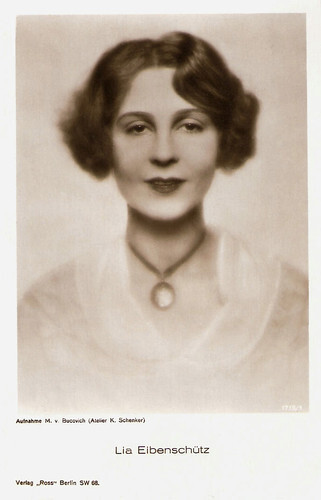
German postcard by Ross Verlag, no. 1715/1, 1927-1928. Photo: Mario von Bucovich (Ateler Karl Schenker).
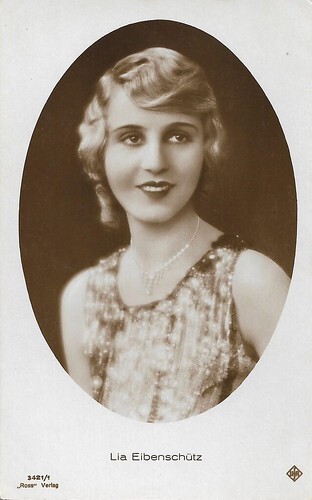
German postcard by Ross Verlag, no. 3421/1, 1928-1929. Photo: Ufa.
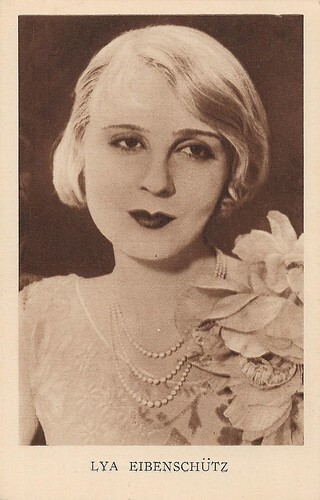
Belgian postcard by S. A. Cacao et Chocolat Kivou, Vilvorde/ N. V. Cacao en Chocolade Kivou, Vilvoorde.
Sources: Stephanie d'Heil (Steffi-Line - German), Thomas Staedeli (Cyranos), Filmportal.de, Wikipedia (German), and .

German postcard by Ross Verlag, Berlin, no. 659/3. Photo: Rembrandt / Peter Paul Felner-Film Co. Lia Eibenschütz as Jessica in Der Kaufmann von Venedig/The Merchant of Venice (Peter Paul Felner, 1923).
French postcard by Cinémagazine-Edition, no. 527. Lia Eibenschütz in Paname...n'est pas Paris/Die Apachen von Paris (Nikolai Malikoff, 1927).

German postcard by Ross Verlag, no. 1952/1, 1927-1928. Photo: Ufa.
Discovered during a concert tour
Lia (or Lya) Eibenschütz was born Lina Mathilde Eibenschütz in 1899 in Wiesbaden, Hesse, Germany. She had Austro-Hungarian ancestors. Her father, Albert Maria Eibenschütz was a pianist and conductor, and her mother, Wilhelmine Marianne Eibenschütz-Wnuczek was also a successful pianist.
So it was not surprising that daughter Lia also studied music and worked as a singer and pianist. She was discovered as an actress in Berlin in 1919 during a concert tour. She debuted on-screen in the leading role of Der Tempel der Liebe/The Temple of Love (Paul Ludwig Stein, 1919). In the 1920s, she could be seen in numerous silent films, often as the enamoured young woman or elegant socialite. She played Baroness Edda von Gerding in Die große und die kleine Welt (Max Mack, 1921), and Countess Polignac in the biopic Marie Antoinette - Das Leben einer Königin (Rudolf Meinert, 1922) with Diana Karenne in the title role.
Other memorable parts she had in Nathan der Weise/Nathan the Wise (Manfred Noa, 1922) starring Werner Krauss and based on the play by Gotthold Ephraim Lessing, the tragicomedy Der Puppenmacher von Kiang-Ning/The Doll Maker of Kiang-Ning (Robert Wiene, 1923) again with Krauss, and the William Shakespeare adaptation Der Kaufmann von Venedig/The Merchant of Venice (Peter Paul Felner, 1923) starring Henny Porten as the rich Portia, Werner Krauss as Shylock, and Harry Liedtke as Bassanio. Eibenschütz played Shylock's daughter Jessica.
She also starred in Die Dame aus Berlin/The Lady of Berlin (Lorand von Kabdebo, 1925) again with Krauss, and (Nikolai Malikoff, 1927) with Jaque Catelain and Ruth Weyher . The latter was a Franco-German co-production, distributed by Ufa. According to Cinémagazine, a fire broke out on Thursday 31 July 1927 in the editing room of the G. M. Film factory in Billancourt, where the film was being developed. As the film had just been finished, the producers decided to re-shoot the film completely.
Lia Eibenschütz was also the leading lady in the early sound film Der Korvettenkapitän/The Corvette Captain (Rudolf Walther-Fein, 1930), a romantic comedy in the Navy with Harry Liedtke , Maria Paudler and Fritz Kampers. But from the early 1930s onward her parts became smaller.

German postcard by Ross Verlag, no. 658/1. Photo: Peter Paul Felner-Film Co. Henny Porten and Lia Eibenschütz in Der Kaufmann von Venedig/The Merchant of Venice (Peter Paul Felner, 1923).

German postcard by Ross Verlag, Berlin, no. 658/2. Photo: Rembrandt / Peter Paul Felner-Film Co. Henny Porten as Porzia and Lia Eibenschütz as Jessica in Der Kaufmann von Venedig/The Merchant of Venice (Peter Paul Felner, 1923).

German postcard by Ross Verlag, no. 658/4. Photo: Peter Paul Felner-Film Co. Publicity still for Der Kaufmann von Venedig/The Merchant of Venice (Peter Paul Felner, 1923). Henny Porten as Porzia/Portia and Lia Eibenschütz as Jessica. The man far right is Carl Ebert (Antonio).
Women of the world
Lia Eibenschütz also worked on the Berlin stage, often performing women of the world. After she married actor Kurt Vespermann in 1927, she retired more and more into private life in the 1930s. She was last seen on stage at the famous Berlin Kabarett der Komiker in the 1932/1933 season. She quitted the sets in 1932 and only appeared in three sound film productions, among others in Friedrich Zelnik 's comedy Ein süßes Geheimnis/A sweet secret (1932) as the film daughter of the Viennese folk actress Hansi Niese.
She dedicated herself to the education of her son, the later actor Gerd Vespermann (1926-2000). Since the Nazis considered her as a "half-Jew", or non-Aryan, Eibenschütz faced increasing problems and was finally excluded from the Reichstheaterkammer in 1937. In hindsight, it is therefore quite remarkable that in the 1920s she did so many films with Werner Krauss , who would become a Nazi and virulent anti-semite in the 1930s. Then again, in the 1920s Krauss was considered one of Germany's best stage and screen actors.
After the end of the Second World War, Lia Eibenschütz took on a few small roles in German film productions. These include Madame de la Rocco in the comedy Das Haus in Montevideo/The House in Montevideo (Curt Goetz, Valerie von Martens, 1951) and the character of Frau Mertens in the Hans Albers thriller Der Greifer/The Ripper (Eugen York, 1958). She appeared as Lady Curtain in the Edgar Wallace adaptation Neues vom Hexer/Again the Ringer (Alfred Vohrer, 1965) with Heinz Drache as Inspector Wesby, and mimed the mother of the over-excited fashion designer Emile Cavin (Hanns Lothar) in the crime comedy Lange Beine - lange Finger/Long Legs, Long Fingers (Alfred Vohrer, 1966) with Martin Held , Senta Berger and Joachim Fuchsberger .
She also returned to Berlin as a theatre actress, for example at the Renaissance Theater. Occasionally, she also worked as a voice actress, for example for the film The Life and Death of Colonel Blimp (Michael Powell, Emeric Pressburger, 1943). Her last film role was as the mother of the girl Johanna (Verena Buss) in the auteur film Der sanfte Lauf/The Soft Course (Haro Senft, 1967) with Bruno Ganz in his first leading role in the cinema. She also appeared on TV on several occasions, such as the mother-in-law of the title character ( Heidelinde Weis ) in the TV series Meine Frau Susanne/My wife Susanne (Erik Ode, 1963).
Lia Eibenschütz acted in almost 70 films and TV series and passed away in 1985 in West Berlin, shortly before her 86th birthday. She is buried in the Kaiser Wilhelm Memorial Cemetery in Berlin, next to her husband Kurt Vespermann . Lia Eibenschütz is not to be confused with the German stage actress Camilla Eibenschütz.

German postcard by Ross Verlag, no. 1715/1, 1927-1928. Photo: Mario von Bucovich (Ateler Karl Schenker).

German postcard by Ross Verlag, no. 3421/1, 1928-1929. Photo: Ufa.

Belgian postcard by S. A. Cacao et Chocolat Kivou, Vilvorde/ N. V. Cacao en Chocolade Kivou, Vilvoorde.
Sources: Stephanie d'Heil (Steffi-Line - German), Thomas Staedeli (Cyranos), Filmportal.de, Wikipedia (German), and .
Published on December 19, 2022 22:00
Paul van Yperen's Blog
- Paul van Yperen's profile
- 13 followers
Paul van Yperen isn't a Goodreads Author
(yet),
but they
do have a blog,
so here are some recent posts imported from
their feed.



